14 Fun & Interactive Presentation Games for Teams and Students

So you've got an audience to energize, students to engage, or a team that needs a little extra fun — playing an interactive presentation game is an easy way to do just that.
We've done the research and found the best of these games for you: we looked specifically for games that are simple to set up, fun to play, and flexible enough to be used with a variety of presentations and audiences. Most of these activities work virtually with Zoom/PowerPoint and can also be used in person.
Which of these 14 presentation games do you like best? Take a look and let us know your favorites:

1. Live Trivia Competition
A great way to ramp up the excitement and engagement is to enable a little bit of friendly competition. Trivia is an easy way to do this—plus, it can be whole-group inclusive and large-audience friendly (if you use the right tools).
Here's a great trivia game you can run with your team, students, or any large audience. It's already created for you with questions and scoring built in to make it even easier:
Here's how to play:
- Make a free account here: https://slideswith.com/
- Click the slide deck and copy it.
- Launch the trivia game by clicking "Start Event."
- Invite your group to join in and submit answers using their mobile devices (show the winners automatically).
- Interact and play during your presentation!
This trivia game has questions on many topics to keep your audience's attention and appeal to everyone. It only takes 10-15 minutes to play, so it's a great game for long discussions! Also, this interactive activity is free for up to ten participants and is totally customizable.
2. Sing and Swing
To really liven up your group, encourage your listeners to play Sing and Swing. This activity is best for long presentations because it boosts energy, creates a fun, light-hearted environment, and makes people laugh a lot.
Here's how to play:
- Before your presentation, pick a well-known song and rewrite the chorus (replace parts of it with words and phrases from your presentation)
- When you're ready to play, show the song on your screen.
- Invite your audience to sing it with you!
If you have a fun group or a class of energetic students, consider adding choreography to engage your audience even more.

3. 20 Questions
If you want a presentation game that requires your listeners to talk more than you, 20 Questions is the one to play! A classic and simple activity, this game immediately boosts engagement and gets people laughing.
Here's how to play: Have someone put an appropriate image or word on the screen behind you (this can be an audience member you trust or a colleague or co-presenter). To make things more fun, put on a blindfold so that everyone knows you can't cheat. From there, ask 20 "yes or no" questions to guess what's displayed on the screen. Your group should respond "yes" or "no" to guide you to the correct answer.
4. Scavenger Hunt Challenge
To get your audience out of their seats, a scavenger hunt challenge is one of the best interactive games for presentations. It'll immediately energize your audience , team, or students while giving them a fun way to learn.
There are tons of in-person and virtual scavenger hunt ideas you can use to dive deeper into your topic or help everyone learn about one another. But if you want a ready-to-play game that you can instantly launch without having any tech skills, here's a fun one to play:
- Use an email address and password to create a free account here: https://slideswith.com/ (a free account guarantees up to ten people can play at no charge).
- Click the game and press "Copy and use this slide deck."
- In the top right corner, click "Start Event."
- Ask listeners to join the game by using their mobile devices to scan the QR code. Players should continue using their mobile devices to submit answers to questions.
- Have everyone start hunting for items!
This activity is a particularly fun game because it's a photo-hunt, show-and-tell challenge! That means your audience will not only get out of their seats to find items, but they'll also get to take pictures and share and discuss photos of what they find. This conversational element will help engage your group!
5. Group Word Clouds
Whether you're speaking to team members, students, or conference-goers, this activity lets you ask questions and get your listeners' thoughts on specific topics.
This game is the perfect way to start your presentation, especially if you're discussing something with a wide range of opinions or are unsure how much your listeners know about a certain subject. Group Word Clouds is also beneficial if you want to do a quick meeting pulse or know how your listeners feel going into your presentation—understanding their energy levels and mood can help you adjust (if necessary) to get maximum engagement and excitement.
To enjoy this activity, keep things simple by using a tool that already offers a ready-to-play Group Word Clouds game. Here's a popular one you can launch immediately:
- Create a free account by entering an email and password here: https://slideswith.com/
- Click the game and then copy it (the button to do so is right underneath the slide deck).
- Press "Start Event" in the top right corner.
- Tell participants to play by scanning the QR code.
- Create word clouds and have fun!
This interactive game only takes 5-10 minutes to play, so it's a fast, fun way to engage your audience and feel out the room. Players can use their mobile devices to answer questions. This activity is also free for up to 10 people and is easy to personalize.
6. The Get to Know You Game
This activity is one of the best presentation games if you have a small group that doesn't really know each other. The Get to Know You Game is a creative way to do introductions, and it's really simple.
Here's how to play the game: Before the event, ask group members to bring a favorite song or item to the presentation (you can do this by emailing them). When you're ready to play, ask each person to introduce themself, present their song or item, and explain why they picked it. For those sharing a song, have them play it on their phones before they explain why it's their favorite.
7. Live Poll Questions
When you have a large group, it's not easy to find ways to boost engagement—but poll questions are the solutions, especially when they're live and interactive. With this unique setup, large groups engage by answering questions and seeing their answers displayed in a fun way.
Your job is to make sure you actually find a game that showcases responses uniquely to captivate your group. For a quick and great option, here's a popular icebreaker activity that promises to display responses using fun formats like word clouds, donut charts, live graphs, and per-player:
- Create an account for free to access the game: https://slideswith.com/
- Click the slide deck and press the button to copy it.
- Look in the top right corner of the deck and press "Start Event."
- Invite your group to play the game. They only need to use their mobile devices to scan the QR code.
- Start polling your audience!
This activity is one of those fun presentation games everyone will want to enjoy, so invite all of your team members and students to participate. This game can accommodate up to 250 players and takes 5-10 minutes to complete. Tell your group to use their mobile devices to submit their responses.
8. Assumptions
This interactive game is a great way to break up your presentation to see who's paying attention and who can answer questions pertaining to your topic.
- Ask your audience to stand up (for virtual presentations, make sure everyone's video is on).
- Show true or false statements on the screen one by one.
- Tell people to raise a hand if they think the statement is correct and sit down if they think it's incorrect.
- Continue until one person is left standing.
- Award the winner.
This activity can be as short and challenging as you want. Also, if your presentation is long, you can play multiple rounds to break up your speaking time and test your audience throughout your discussion.

9. Controversial Questions
Want to see where your audience, students, or team lands on controversial topics? Then, energize your presentation with a fun, creative game called Controversial Questions. This activity has prompts that inspire lively debates, so it's a great way to get your group excited and chatty.
However, to maintain a positive environment, make sure to find a tool that offers an office-friendly, classroom-friendly, and conference-friendly game. You don't want to sour the mood by creating uncomfortable division during your presentation. To make sure this game is fun and light-hearted, here's a popular one that's suitable for all audiences and ages:
- Sign up for a free account by inputting an email address and password here: https://slideswith.com/pricing
- Click the game and press the button that says, "Copy and use this deck."
- Press "Start Event" (the button is in the top right corner).
- Have participants join the fun by asking them to scan the QR code with their mobile devices.
- Get controversial and play!
This interactive game for presentations asks fun (but appropriate) questions like:
- Does pineapple belong on pizza?
- Does the person flying in the middle seat get both armrests?
- Should the toilet roll go over or under?
Players should use their mobile devices to submit answers. Up to ten people can play for free, and you can customize the game by updating the questions!
10. Word of the Day
With this activity, you can keep your audience, team, or students engaged throughout your entire presentation. This game requires listeners to be alert and recognize whenever you say the word of the day.
Here's how to play: At the beginning of your presentation, tell your group the word of the day (it can also be a phrase if you'd prefer). Say that you'll weave the word into your presentation and that your audience must shout it out whenever you mention it.
11. Mini Activity: Group Icebreaker
Whether you're doing an in-person or virtual presentation, you need to warm up your audience to get things started on a positive note. The best way to do that is with a quick icebreaker game.
However, make sure your questions are fun, positive, and engaging. You can easily do this by finding a game that already has the best icebreaker questions included. Here's one that's ready to play (and requiring no tech skills to launch):
- Input an email address and password to make a free account here: https://slideswith.com/
- Click the deck and copy it (press "Copy and use this deck).
- Click the button in the top right corner that says "Start Event."
- Invite participants to play by asking them to scan the QR code.
- Break the ice to warm up your audience!
Your group should use their mobile devices to submit responses to poll questions. Also, this game accommodates up to 250 players, but only ten people can join for free.
12. Process of Elimination
This activity is one of the best games for presentations because it's simple yet fun and great at helping listeners get to know each other. You can play it at the beginning of your presentation or in the middle to give your group a chance to stretch their legs.
- Before your event, create a list of "yes or no" questions.
- Once you're ready to play, tell your group to stand up (if you're doing a virtual presentation, make sure everyone's video is on).
- Ask each question one by one.
- Tell attendees to stand if their answer is "yes" and sit if their answer is "no."
The questions can relate to your topic or be totally random. Also, if you'd prefer to thin out the number of people standing, you can take a creative twist and ask your questions by saying something like this: "Stay standing if (insert scenario)." When phrasing each question this way, the game will end with one person standing. To acknowledge the winner, you can give them a round of applause or award them a prize.
13. Conference Opener Icebreaker
If you're speaking at a big conference, you need an interactive game for presentations that can get everyone involved and ensure every voice is heard. To achieve these goals, you should create an icebreaker game that works for large groups .
Using an easy, intuitive template is the best step to take. That way, you don't have to start from scratch or spend hours making your game. For a template that requires no code or tech-savviness to build on, here's the best option:
- Sign up by making a free account here: https://slideswith.com/
- Click on the game. On the next page, click the button to copy and use the deck.
- Customize the template using the instructions HERE .
- During your presentation, press "Start Event" in the top right corner.
- Ask the group to use their mobile devices to scan the QR code and join the fun. (Also, make sure participants use their mobile devices to submit answers.)
- Play and engage your audience!
This template has fun, interactive features built in to keep your large audience engaged. Those features include polls, word clouds, and ratings. Just make sure you sign up for a paid plan to accommodate the large number of people in your group—the free account only works for up to ten players.
14. Two Truths and a Lie
This classic game is a fun, energizing way to help your listeners get to know one another. It's perfect for small in-person or virtual groups and is an ideal activity for the beginning of your presentation.
Here's how to play: Pick any topic (for the purposes of this article, the topic will be "movies"). In no particular order, say two movies you've really watched and one you haven't watched. Ask your audience to guess which statement is the lie. The winner picks the next topic and says two truths and a lie.
Be Memorable With Presentation Games
Oftentimes, people forget presentations within a week or even days, and that's because the discussions are boring. But you don't work hard preparing a presentation for it to be forgotten. If you want your message to stick, all you have to do is make it enjoyable without being corny.
If you want to be remembered and actually get people engaged, you need to make your presentation fun and enjoyable, without coming off as corny or desperate to please. Ivan Dimitrijevic, 10 Secrets of Making Every Presentation Fun, Engaging, and Enjoyable
Luckily, the interactive presentation games in this article are unique and exciting—they're far from corny. So, use them for your upcoming presentations to make your messages compelling and memorable.
Subscribe for more articles like this
Try slides with friends for free.
The easiest way to host meetings your team will love
Engagement delivered to your inbox
We'll email you 1-2x per month with brand new, ready-to-run events and ideas. Subscribe to stay ahead of the curve and keep your lessons, meetings, and events fresh and engaging.
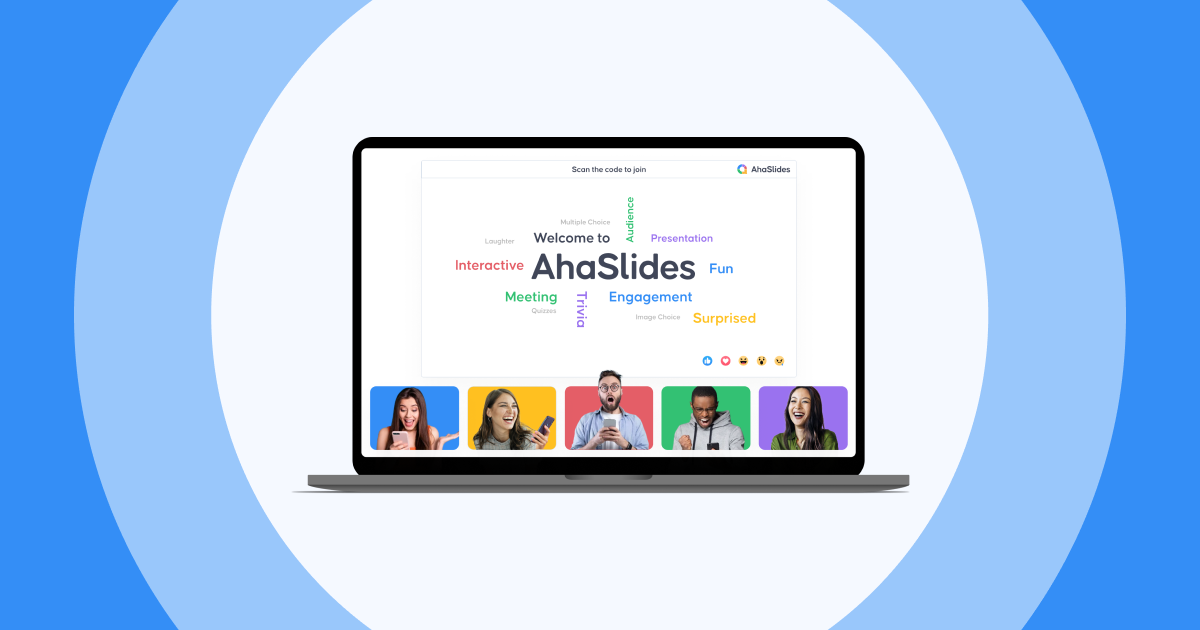
11 Interactive Presentation Games to Win Easy Engagement in 2024
Lawrence Haywood • 08 Apr 2024 • 10 min read
So, how to make a presentation engaging? Audience attention is a slippery snake. It’s difficult to grasp and even less easy to hold, yet you need it for a successful presentation.
No Death by PowerPoint, no to drawing monologues; it’s time to bring out the interactive presentation games !
Bonus : Free game presentation templates to use. Scroll down for more👇
These 11 games below are perfect for an interactive presentation . They’ll score you mega-plus points with colleagues, students, or wherever else you need a kick of super-engaging interactivity… So let’s check out those exciting presentation formats!
Table of Contents
- #1: Live Quiz
#2: What Would You Do?
#3: key number, #4: guess the order, #5: 2 truths, 1 lie, #6: 4 corners, #7: obscure word cloud, #8: heart, gun, bomb.
- #9: Match Up
#10: Spin the Wheel
#11: q&a balloons, interactive powerpoint presentation games – yes or no, frequently asked questions.
Host Interactive Presentation Games for Free!
Add interactive elements that make the crowd go wild . Make your whole event memorable for any audience, anywhere, with AhaSlides.
More Interactive Presentation Tips with AhaSlides
- The Complete Guide to Make a Presentation Interactive
- Interactive Presentation Ideas to Enliven Work/Hangout
- Interactive Presentation Techniques

Start in seconds.
Get free templates for your next interactive presentation. Sign up for free and take what you want from the template library!
#1: Live Quiz Competition
Is there any event that hasn’t been immediately improved with some trivia?
A live quiz is an evergreen, ever-engaging way to consolidate your presentation’s info and check the understanding of it all amongst your audience. Expect big laughs as your audience competes fiercely over who was listening to your presentation the most complex.
Here’s how to play:
- Set up your questions on AhaSlides – the free quizzing software .
- Present your quiz to your players, who join by typing your unique code into their phones.
- Take your players through each question, and they race to get the correct answer the fastest.
- Check the final leaderboard to reveal the winner!
Learn how to set up your presentation quiz for free in just a few minutes! 👇
Put your audience in your shoes. Give them a scenario related to your presentation and see how they would deal with it.
Let’s say you’re a teacher giving a presentation on dinosaurs. After presenting your info, you would ask something like…
A stegosaurus is chasing you, ready to snap you up for dinner. How do you escape?
After each person submits their answer, you can take a vote to see which is the crowd’s favourite response to the scenario.
This is one of the best presentation games for students as it gets young minds whirring creatively. But it also works great in a work setting and can have a similar freeing effect, which is especially significant as a large group icebreaker .
- Create a brainstorming slide and write your scenario at the top.
- Participants join your presentation on their phones and type their responses to your scenario.
- Afterwards, each participant votes for their favourite (or top 3 favourites) answers.
- The participant with the most votes is revealed as the winner!
No matter the topic of your presentation, there’s sure to be a lot of numbers and figures flying around.
As an audience member, keeping track of them isn’t always easy, but one of the interactive presentation games that makes it easier is Key Number .
Here, you offer a simple prompt of a number, and the audience responds with what they think it refers to. For example, if you write ‘ $25′ , your audience might respond with ‘our cost per acquisition’ , ‘our daily budget for TikTok advertising’ or ‘the amount John spends on jelly tots every day’ .
- Create a few multiple-choice slides (or open-ended slides to make it more complicated).
- Write your key number at the top of each slide.
- Write the answer options.
- Participants join your presentation on their phones.
- Participants select the answer they think the critical number relates to (or type in their answer if open-ended).

If keeping track of numbers and figures is challenging, it can be even tougher to follow entire processes or workflows explained in a presentation.
To cement this information in your audience’s mind, Guess the Order is a fantastic minigame for presentations.
You write the steps of a process, jumble them up, and then see who can put them in the right order the fastest.
- Create a ‘Correct Order’ slide and write your statements.
- Statements are automatically jumbled up.
- Players join your presentation on their phones.
- Players race to put the statements in the correct order.

You might have heard of this one as a great icebreaker, but it’s also one of the top presentation games for checking who’s paying attention.
And it’s pretty simple to do. Just think of two statements using the information in your presentation, and make another one up. Players have to guess which is the one you’ve made up.
This one is a great re-capping game and works for students and colleagues.
- Create a list of 2 truths and one lie covering different topics in your presentation.
- Read out two truths and one lie and get participants to guess the lie.
- Participants vote for the lie either by hand or through a multiple-choice slide in your presentation.
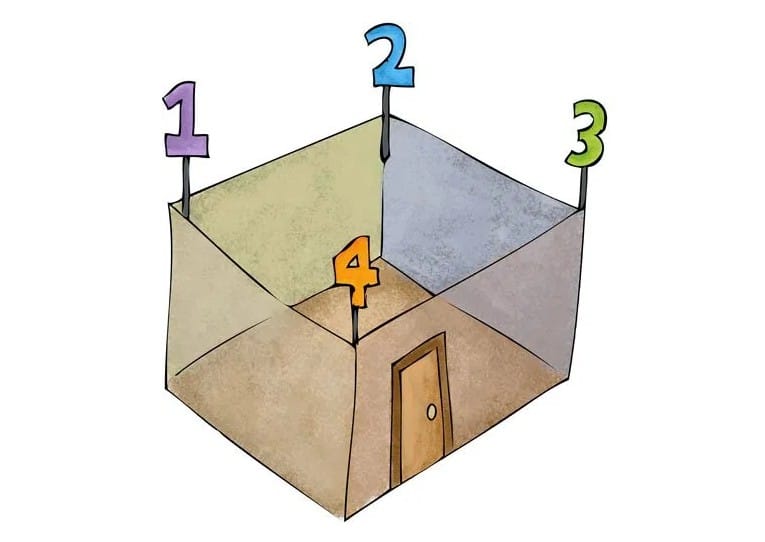
The best presentations are ones that spark a bit of creative thinking and discussion. There’s no better presentation game for evoking this than 4 Corners.
The concept is simple. Present a statement based on something from your presentation that’s open to different points of view. Depending on each player’s opinion, they move to a corner of the room labelled ‘strongly agree’, ‘agree’, ‘disagree’ or ‘strongly disagree’ .
Maybe something like this:
An individual is shaped more by nature than nurture.
Once everyone is in their corner, you could have a structured debate between the four sides to bring different opinions to the table.
- Set up the ‘strongly agree’, ‘agree’, ‘disagree’ and ‘strongly disagree’ corners of your room (if running a virtual presentation, then a simple show of hands could work).
- Write some statements which are open to different opinions.
- Read out the statement.
- Each player stands in the right corner of the room, depending on their view.
- Discuss the four different viewpoints.

Live word clouds are always a beautiful addition to any interactive presentation. If you want our advice, include them whenever you can – presentation games or not.
If you do plan to use one for a game in your presentation, a great one to try is Obscure Word Cloud .
It works on the same concept as the popular UK game show Pointless . Your players are given a statement and have to name the most obscure answer they can. The least-mentioned correct answer is the winner!
Take this example statement:
Name one of our top 10 countries for customer satisfaction.
The most popular answers may be India, USA and Brazil , but the points go to the least mentioned correct country.
- Create a word cloud slide with your statement at the top.
- Players submit the most obscure answer they can think of.
- The most obscure one appears most diminutive on the board. Whoever submitted that answer is the winner!
Word Clouds for Every Presentation
Get these word cloud templates when you sign up for free with AhaSlides!

For Ice Breaking

For Testing

This one’s a great game to use in the classroom, but if you’re not looking for presentation games for students, it also works wonders in a casual work setting.
Heart, Gun, Bomb is a game in which teams take turns to answer questions presented in a grid. If they get an answer right, they either get a heart, a gun or a bomb…
- A ❤️ grants the team an extra life.
- A 🔫 takes away one life from any other team.
- A 💣 takes away one heart from the team who got it.
All teams start with five hearts. The team with the most hearts at the end, or the only surviving team, is the winner!
- Before starting, create a grid table for yourself with either a heart, gun or bomb occupying each grid (on a 5×5 grid, this should be 12 hearts, nine guns and four bombs).
- Present another grid table to your players (5×5 for two teams, 6×6 for three groups, etc.)
- Write a figure stat (like 25%) from your presentation into each grid.
- Split players into the desired number of teams.
- Team 1 chooses a grid and says the meaning behind the number ( for example, the number of customers last quarter ).
- If they’re wrong, they lose a heart. If they’re right, they get either a seat, gun or bomb, depending on what the grid corresponds to on your grid table.
- Repeat this with all the teams until there’s a winner!
👉 Get more interactive presentation ideas (interactive PowerPoint ideas) with AhaSlides.
#9: Match Up – Interactive Presentation Games
Here’s another quiz-type question that can be a great addition to your roster of presentation games.
It involves a set of prompt statements and a set of answers. Each group is jumbled; the players must match the information with the correct answer as quickly as possible.
Again, this one works well when the answers are numbers and figures.
- Create a ‘Match Pairs’ question.
- Fill out the set of prompts and answers, which will automatically shuffle.
- Players match each prompt with its answer as fast as possible to score the most points.
If there’s a more versatile presentation game tool than the humble spinner wheel , we aren’t aware of it.
Adding the random factor of a spinner wheel might be just what you need to keep engagement in your presentation high. There are presentation games you can use with this, including…
- Choosing a random participant to answer a question.
- Choosing a bonus prize after getting an answer correct.
- Choosing the next person to ask a Q&A question or give a presentation.
- Create a spinner wheel slide and write the title at the top.
- Write the entries for the spinner wheel.
- Spin the wheel and see where it lands!
Tip 💡 You can choose the AhaSlides spinner wheel to use your participants’ names, so you don’t have to fill in the entries manually! Learn more interactive presentation techniques with AhaSlides.
This one’s a great way to turn a regular end-of-presentation feature into a fun, engaging game.
It’s got all the hallmarks of a standard Q&A, but this time, all the questions are written on balloons.
It’s a super simple one to set up and play, but you’ll see how motivated participants are to ask questions when it involves balloons!
- Hand out a deflated balloon and a Sharpie to each participant.
- Each participant blows up the balloon and writes their question on it.
- Each participant bats their balloon to where the speaker is standing.
- The speaker answers the question and then pops or throws away the balloon.
🎉 Tips: Best Q&A Apps to Engage With Your Audience | 5+ Platforms For Free in 2024
So, how do you feel about AhaSlides’s creative ideas for presentations? Being by far the most popular presentation tool on the planet, you may want to know if there are any presentation games to play on PowerPoint.
Unfortunately, the answer is no. PowerPoint takes presentations incredibly seriously and doesn’t have a lot of time for interactivity or fun of any kind.
But there’s good news…
It is possible to directly embed presentation games into PowerPoint presentations with free help from AhaSlides.
You can import your PowerPoint presentation to AhaSlides with the click of a button and vice versa , then place interactive presentation games like the ones above directly between your presentation slides.
💡 PowerPoint presentation games in less than 5 minutes ? Check the video below or our quick tutorial here to find out how!
What are the benefits of playing interactive presentation games?
Interactive presentation games boost engagement, participation and knowledge retention. They turn passive listeners into active learners by incorporating elements like live polls , idea board , quizzes, word clouds and Q&A .
How do you make a presentation interactive with games?
– Match your content: The game should reinforce the topics being covered, not just be random entertainment. – Audience considerations: Age, group size, and their knowledge level will inform game complexity. – Tech tools & time: Consider tools like AhaSlides, Mentimeter Alternatives , Kahoot , etc., or design simple no-tech games based on the time you have. – Utilise appropriate questions, including icebreaker games questions or general knowledge quiz questions
How can I make my presentation more engaging?
Making presentations more engaging can be a challenge, but there are several techniques you can use to make your presentation more interesting and memorable, including (1) start with a strong opening (2) use lots of visual ads and (3) tell attractive story. Also, remember to keep it short and sweet, and of course, practice a lots!

Lawrence Haywood
Former ESL teacher and quiz master converted to the wild slide. Now a content creator, traveller, musician and big time slider preaching the good word of interactivity.
More from AhaSlides

- Skip to main content
- Skip to primary sidebar
- Skip to footer
- QuestionPro

- Solutions Industries Gaming Automotive Sports and events Education Government Travel & Hospitality Financial Services Healthcare Cannabis Technology Use Case NPS+ Communities Audience Contactless surveys Mobile LivePolls Member Experience GDPR Positive People Science 360 Feedback Surveys
- Resources Blog eBooks Survey Templates Case Studies Training Help center
Home LivePolls
15 Interactive Presentation Games to Engage Your Audience
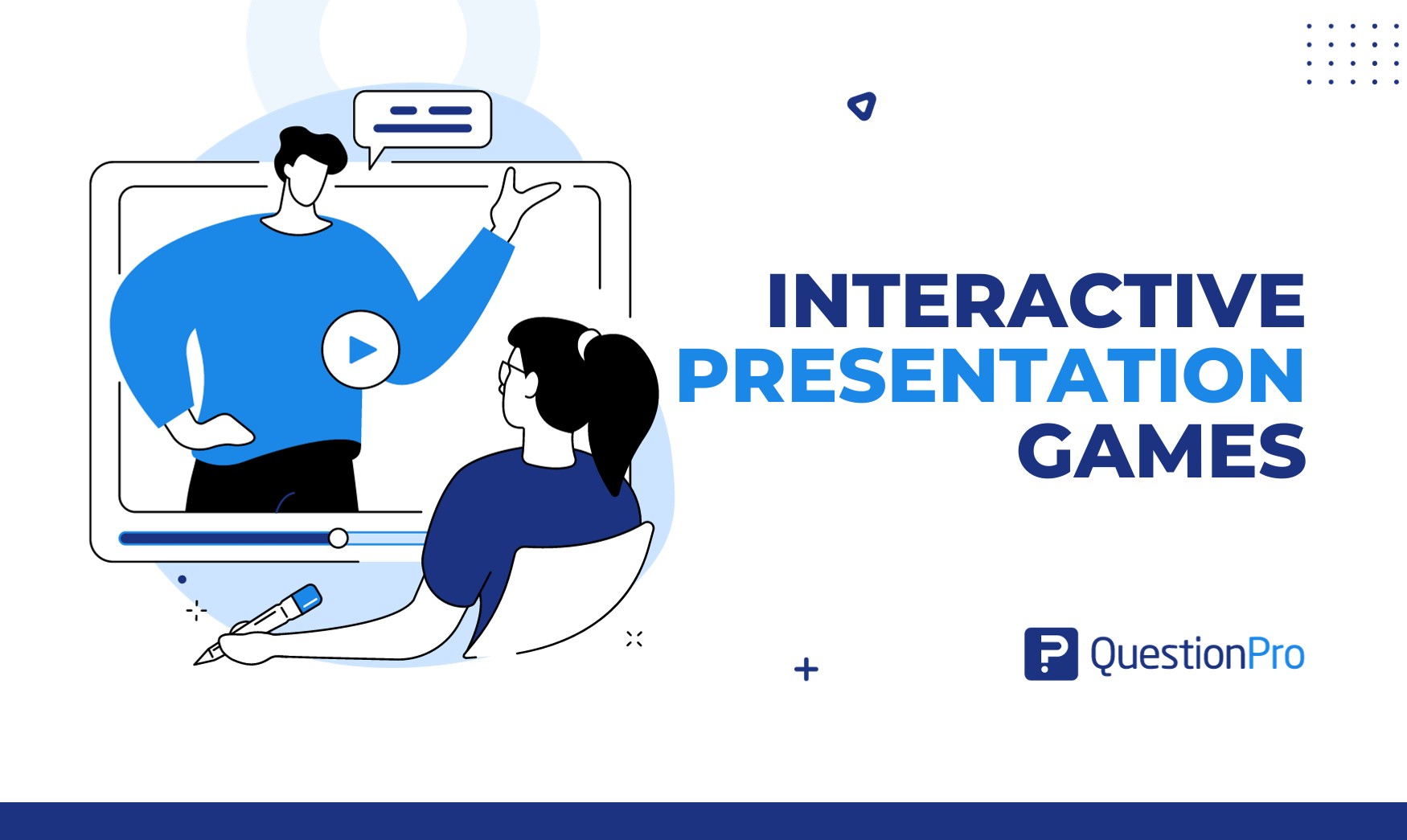
In the world of presentations and public speaking, engaging your audience is crucial. A captivating presentation can leave a lasting impact and ensure that your message is heard and retained. One effective way to achieve this engagement is by incorporating interactive presentation games into your talks.
Interactive presentation games break the monotony of traditional slideshows and transform passive listeners into active participants. In this blog, we’ll explore 15 interactive presentation games that can make your presentations more dynamic, memorable, and enjoyable for your audience.
Why Use Interactive Presentation Games?
Traditional presentations often involve passive listening, which can lead to disengagement and limited retention of information. On the other hand, interactive presentation games create an environment of active participation.
Making your presentations more memorable and impactful. They foster interaction, feedback, and collaboration, turning your audience into active participants rather than passive observers.
Benefits of Engaging Your Audience
Engaging your audience with interactive presentation games offers numerous benefits:
- Increased Engagement: Interactive presentation games grab your audience’s attention and keep them actively involved throughout the presentation.
- Improved Information Retention: Active participation enhances the retention of key information, ensuring that your message sticks with your audience long after the presentation is over.
- Enhanced Learning: Games encourage a deeper understanding of the subject matter, making it easier for your audience to grasp complex concepts.
- Better Audience Connection: By involving your audience, you establish a stronger connection, making them feel valued and heard.
- Immediate Feedback: Games provide opportunities for instant feedback, allowing you to address questions and concerns in real time.
- Fun and Entertainment: Interactive fun games add an element of fun and entertainment to your presentations, making them more enjoyable for your audience.
How to Choose the Right Presentation Games
Selecting the appropriate presentation games depends on your audience, topic, and objectives. Consider factors such as the size of your audience, the level of interactivity you desire, and the technology available. Tailor your choice of games to align with your presentation goals, ensuring they enhance your message rather than distract from it.
Now, let’s explore 15 interactive presentation games that you can incorporate into your presentations to engage your audience effectively:
01. Polling and Surveys
Polling and surveys involve asking questions to your audience and collecting their responses in real time. This game is useful for engaging the audience and gathering valuable data or opinions.
Example: During a marketing presentation, you can use polling to ask the audience which social media platform they use most frequently for product discovery, with response options like “Facebook,” “Instagram,” or “Twitter.” The results can guide your marketing strategy.
02. Quiz and Trivia
Quiz and trivia games challenge the audience’s knowledge of a specific subject. Correct-answer questions encourage competition and learning because participants’ scores are added up.
Example: In a history lecture, you can organize a trivia quiz about historical events. Ask questions like, “Who was the first President of the United States?” and award points for correct answers to make learning history engaging.
03. Interactive Q&A Sessions
Interactive Q&A sessions allow the audience to ask questions and engage in a live dialogue with the presenter. This interactive presentation game promotes engagement, clarification, and in-depth discussions.
Example: After a business strategy presentation, open the floor for an interactive Q&A session where the audience can ask questions about the proposed strategies, fostering a deeper understanding of the material.
04. Gamified Scenarios
Gamified scenarios present real-world situations or challenges to the audience. Participants make decisions, and the consequences of those choices are revealed, creating an immersive learning experience.
Example: In leadership training, simulate a business scenario where participants make decisions as managers. Their choices affect the company’s success, making the learning process engaging and interactive.
05. Virtual Reality and Augmented Reality Experiences
Virtual reality (VR) and augmented reality (AR) games provide immersive 3D experiences. Participants can explore virtual environments or interact with augmented elements.
Example: In a product launch presentation, use AR to allow the audience to visualize how the product would fit into their homes. They can use their smartphones to see a virtual presentation version of the product in their living rooms.
06. Storytelling Challenges
Storytelling challenges encourage participants to create and share their stories, fostering creativity and personal expression.
Example: In a team-building workshop, ask each participant to share a personal success story related to teamwork. This engages the audience and builds a sense of connection among participants.
07. Collaborative Whiteboard Activities
In real-time, collaborative whiteboard activities involve multiple participants contributing ideas, drawings, or annotations on a digital whiteboard. This game fosters teamwork and brainstorming.
Example: During a brainstorming session for a new project, use a digital whiteboard tool where team members can simultaneously sketch out their ideas and add comments. This promotes collaboration and idea generation.
08. Interactive Polls and Word Clouds
Interactive polls and word clouds engage the audience by having them vote or input keywords related to a topic. The results are displayed dynamically.
Example: In a conference PowerPoint presentation about technology trends, ask the audience to submit keywords related to the most exciting emerging technologies. Display the results in a word cloud to visualize the collective interest.
09. Simulations and Case Studies
Simulations and case studies replicate real-life scenarios for participants to make decisions and see the outcomes. This game is effective for practical learning.
Example: In a business strategy workshop, provide participants with a case study of a struggling company. Have them analyze the situation and propose strategies to turn the business around. The best solutions can be discussed as a group.
10. Role-Playing Exercises
Role-playing exercises involve participants taking on specific roles or characters to act out scenarios. This game promotes empathy and communication skills.
Example: In customer service training, participants can take on the roles of customers and service representatives. They act out various customer service scenarios to practice effective communication and problem-solving.
11. Breakout Rooms and Group Discussions
Breakout rooms and group discussions split the audience-focused audiences into smaller groups to discuss specific topics or tasks. This great game promotes active participation and in-depth exploration of ideas.
Example: In an educational webinar, use breakout rooms to divide participants into smaller groups. Each group discusses a different aspect of the topic and then shares their insights when they return to the main session.
12. Live Challenges and Competitions
Live challenges and competitions introduce competitive elements to the best presentation games. Participants can compete individually or in teams to solve problems or complete tasks.
Example: In a team-building event, organize a friendly competition where teams compete in a series of challenges. Challenges could include problem-solving tasks, physical activities, or trivia quizzes to foster teamwork and camaraderie.
13. Interactive Presentations
Interactive presentations incorporate multimedia elements, quizzes, and audience participation throughout the entire presentation screen to keep the audience engaged.
Example: During a product launch presentation, embed interactive elements such as polls, quizzes, and live demos within your slides. This ensures constant engagement and information retention.
14. Icebreakers and Energizers
Icebreakers and energizers are quick, fun activities designed to create a relaxed atmosphere and engage the audience at the beginning of a presentation or during breaks.
Example: At the start of a team meeting, use a fun icebreaker like “Two Truths and a Lie,” where each participant shares two true statements and one false one about themselves. It lightens the mood and promotes bonding.
15. Creative Challenges and Brain Teasers
Creative challenges and brain teasers stimulate creativity and problem-solving. They present puzzles, riddles, or creative tasks to engage the audience stand.
Example: During a creativity workshop, present participants with a riddle or a creative problem to solve as a group. Encourage them to think critically and come up with innovative solutions, fostering creative thinking.
How QuestioPro LivePolls can help in Interactive presentation games
When you use any tool for an interactive show, you need to think about how your audience votes and your presentation’s goals. Make sure the interactive elements enhance the learning or engagement experience rather than becoming a distraction.
Here are some ways a survey-based tool like QuestionPro can assist in creating interactive presentation games:
Question and Quiz Creation
Many interactive presentation game tools allow you to create questions and quizzes that you can integrate into your presentations. These questions can be multiple-choice, true/false, open-ended, or other formats. Participants can then respond to these questions during your presentation.
Interactive presentation fun game tools often include features that engage your audience. This can include things like timers for questions, leaderboards to display scores, and interactive survey elements that make your presentation more engaging and fun.
Feedback and Scoring
These tools typically provide instant feedback to participants. Correct answers might be rewarded with points, while explanations could follow incorrect answers. Scores are often tallied in real time, creating a competitive or gamified atmosphere.
Data Collection
Interactive presentation game tools can help you collect data on audience response software . This data can be valuable for assessing learning outcomes, understanding audience vote opinions, or tailoring your content to your audience’s preferences.
Customization
You can often customize the appearance and behavior of interactive elements to fit your presentation’s theme or style. This allows for creative and engaging presentations.
Audience Participation
Such tools enable audience members to actively participate and feel involved in your presentation. This can lead to higher engagement levels and better retention of information.
Reports and Analytics
Some tools provide analytics and reports after your presentation, which can help you assess the effectiveness of your interactive elements and the overall presentation.
Incorporating interactive presentation games into your talks can elevate your engagement, foster learning, and make your message more memorable. Whether you choose polls, quizzes, simulations, or storytelling challenges, tailoring the games to your audience and objectives is key.
By doing so, you’ll transform your presentations into dynamic and unforgettable experiences that leave a lasting impact on your audience. So, level up your presentations with these interactive games, and watch your audience become active participants in your message.
LEARN MORE CREATE FREE ACCOUNT
MORE LIKE THIS

Top 20 Employee Engagement Software Solutions
May 3, 2024

15 Best Customer Experience Software of 2024
May 2, 2024

Journey Orchestration Platforms: Top 11 Platforms in 2024

Top 12 Employee Pulse Survey Tools Unlocking Insights in 2024
May 1, 2024
Other categories
- Academic Research
- Artificial Intelligence
- Assessments
- Brand Awareness
- Case Studies
- Communities
- Consumer Insights
- Customer effort score
- Customer Engagement
- Customer Experience
- Customer Loyalty
- Customer Research
- Customer Satisfaction
- Employee Benefits
- Employee Engagement
- Employee Retention
- Friday Five
- General Data Protection Regulation
- Insights Hub
- Life@QuestionPro
- Market Research
- Mobile diaries
- Mobile Surveys
- New Features
- Online Communities
- Question Types
- Questionnaire
- QuestionPro Products
- Release Notes
- Research Tools and Apps
- Revenue at Risk
- Survey Templates
- Training Tips
- Uncategorized
- Video Learning Series
- What’s Coming Up
- Workforce Intelligence
Blog > The 10 best PowerPoint Games to play in Workshops, Classrooms & Presentations
The 10 best PowerPoint Games to play in Workshops, Classrooms & Presentations
01.01.20 • #fun #game #powerpoint #presentation.
In our last blog post, we talked about tools and tips on how to boost the audience engagement in your presentation. One of our recommended ways to do so was to play games, as they release tension and function as a fun element that lightens the mood. That’s why today we are going to list the Top 10 best games to play in your presentation.
1. Would you rather
Is it a game that everyone knows already? Probably. But did we have to include it on the list because it is just perfect for playing with your audience? Definitely. The game is pretty much self-explanatory – You give your attendees two (or more) scenarios and they have to choose which one they’d rather experience. Combining the Would you rather – question with your presentation topic is usually very easy, but we also thought of some questions you could use for any topic (e.g. as an icebreaker, to get to know your audience a little better, to ask about their opinion or just as a fun element in between). You can let your audience vote by letting them raise their hands or by using an interactive poll tool such as SlideLizard .
- Would you rather A. travel back in time OR B. travel to the future OR C. stay in the present
- Would you rather A. have a long lunch break now OR B. have a short break and finish early
- Would you rather A. be able to read minds OR B. be able to fly OR C. be able to turn invisible
- Would you rather A. receive a letter from Hogwarts OR B. join Frodo on his journey OR C. Hog-what?
- Would you rather A. never be able to go on Social Media again B. never be able to read a book again

2. Charades
The popular game is not only great for your family’s game-night, but also for your presentations and workshops. Prepare a few cards that have words related to your presentation’s topic on them, let some volunteers in your audience draw and act them out. The rest of the audience has to guess the word. You can be sure that these terms and the associated performances will never be forgotten!

Small Trivia quizzes are perfect for checking and manifesting the audience’s knowledge at the end of your presentation. Instead of repeating and summing up what you have already said, you can let your participants test their knowledge right away. However, you can also use a quiz in the beginning to test your audience’s existing knowledge about a topic. But there are not only trivia quizzes: Questions about personality can also be interesting and work well as an ice breaker in the beginning. Again, we recommend a tool for poll creation, as that is the easiest way to conduct quizzes. In a recent article we listed 50 great questions (a mix of personality and trivia) , that you could use for your next presentation! And if you're a fan of quiz game shows, we also got a full Who wants to be a Millionaire PowerPoint template for you to download for free! You'll see how it looks like in the following video (be sure to turn up your sound!):
PowerPoint can be used for way more than most people know. Even we were amazed by people on the internet who created extensive games by animating content using PP. We don’t want to go that big today, but we are going to provide you with a free-to-download template of memory. You only have to add it to your presentation and customize the pictures or terms you want under the cards. Download free PPT Memory Template
5. Two Truths and a Lie
Here is another game that is just perfect when you play it with interactive poll tools. It is great for getting the audience to know you as a presenter better. Think of a fun, interesting or astonishing fact about yourself, and then invent two fake ones. Your attendees have to vote which statement they think is true. Be prepared to see some very surprised faces in your audience!

6. PowerPoint Karaoke
PowerPoint-Karaoke is the perfect improvisation game. Players are confronted with a set of slides they have never seen before and try to give a presentation as convincingly as possible. If you want to know all about this game and get some slides you can use for playing, check out our detailed blog post on PowerPoint-Karaoke .

7. Where do you stand?
For the game “Where do you stand?”, your attendees will actually have to stand up. Therefore, it is only convenient if you have enough space. If you want to get your participant’s opinion about something and get them to move a little, look no further! Create an imaginary line across the room. One end stands for one opinion, the other end for the exact opposite opinion. Your attendees can now place themselves on this line wherever they like (right in the middle, on either end or somewhere in between). You can then even interview people on the line (it is always interesting to choose two from opposite sites) and learn about their views. If you’re a little overwhelmed now, here are some examples you could use for this game:
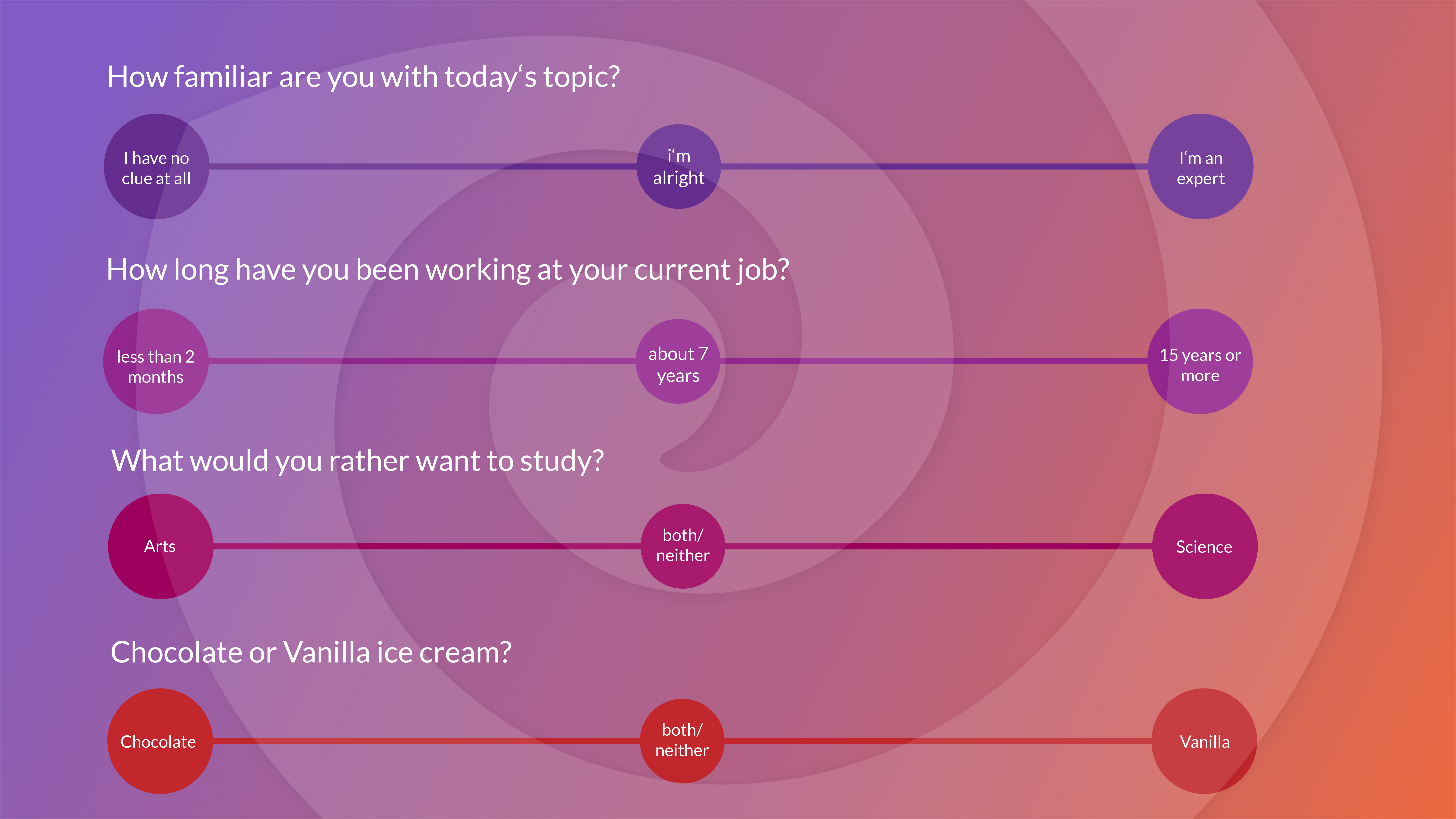
Attention – you can of course ask about political or more controversial topics, but that may escalate and turn into a fight, which is not the purpose of the game or your presentation.
8. Describe That
Let your audience draw from cards with words on them and then describe it for the other attendees. It is basically like charades, but with words instead of acting. Some may find that too easy. In that case, you can either choose terms that are extremely hard to describe or add some “Taboo-words” to the card that can’t be used for describing.

9. True and False
Have you ever heard a crazy, bizarre fact where you didn’t think that it could be true? Perfect. You can use it in the well-known “True and False”-Game. You pick out a fact (ideally something related to your presentation topic) and then let your audience vote (you know – via an interactive poll tool like SlideLizard ) if they think it’s true or not. A tip for making statements false: Change little things about the them, like numbers, dates or names or use common misconceptions and see how many of your attendees buy into them, e.g. “Bulls are enraged by the color red” (which is false, bulls are simply enraged by movement, not specific colors).

10. The never-ending sentence
The never-ending sentence is a great game that incorporates many of your attendees and awakens their brain cells. It is perfect for keeping up their engagement and interest, especially for long presentations or workshops when you feel like some people are getting a little tired. Simply start by saying a word – it can be related to the presentation’s topic if you want – and ask a person in your audience to repeat that word and add another one – the next person to repeat those two words and add another one as well , and so on, until a sentence forms. As it gets longer the game gets a lot more difficult, because there is a lot more to remember and to repeat. The sentence can’t be ended, it has to be continued until someone makes a mistake (or until the last person in the room has added a new word). We promise that you will be left with a lot of fun, creative, and straight-up weird sentences that will make your audience laugh a lot.

Related articles
About the author.

Pia Lehner-Mittermaier
Pia works in Marketing as a graphic designer and writer at SlideLizard. She uses her vivid imagination and creativity to produce good content.

Get 1 Month for free!
Do you want to make your presentations more interactive.
With SlideLizard you can engage your audience with live polls, questions and feedback . Directly within your PowerPoint Presentation. Learn more

Top blog articles More posts

Wedding Quiz Ideas

Create an animated timeline in PowerPoint + Free Template

Get started with Live Polls, Q&A and slides
for your PowerPoint Presentations
The big SlideLizard presentation glossary
Outline view.
The outline view in PowerPoint shows a list with the whole text of all slides on the left of the screen. There are no images and graphics displayed in this view. It's useful for editing the presentation and can also be saved as a Word document.
SmartArts are diagrams that convey processes, connections or hierarchies. They can also be edited individually and easily be added to your presentations.
Hybrid Audience
A mix between in-person and virtual participants for an event or a lecture is called a hybrid audience. Working with a hybrid audience may be challenging, as it requires the presenter to find ways to engage both the live and the virtual audience.
Motivational Presentation
A motivational presentation is meant to inspire people. In a company, for example, you could tell the company's story in a motivational presentation.
Be the first to know!
The latest SlideLizard news, articles, and resources, sent straight to your inbox.
- or follow us on -
We use cookies to personalize content and analyze traffic to our website. You can choose to accept only cookies that are necessary for the website to function or to also allow tracking cookies. For more information, please see our privacy policy .
Cookie Settings
Necessary cookies are required for the proper functioning of the website. These cookies ensure basic functionalities and security features of the website.
Analytical cookies are used to understand how visitors interact with the website. These cookies help provide information about the number of visitors, etc.
We use essential cookies to make Venngage work. By clicking “Accept All Cookies”, you agree to the storing of cookies on your device to enhance site navigation, analyze site usage, and assist in our marketing efforts.
Manage Cookies
Cookies and similar technologies collect certain information about how you’re using our website. Some of them are essential, and without them you wouldn’t be able to use Venngage. But others are optional, and you get to choose whether we use them or not.
Strictly Necessary Cookies
These cookies are always on, as they’re essential for making Venngage work, and making it safe. Without these cookies, services you’ve asked for can’t be provided.
Show cookie providers
- Google Login
Functionality Cookies
These cookies help us provide enhanced functionality and personalisation, and remember your settings. They may be set by us or by third party providers.
Performance Cookies
These cookies help us analyze how many people are using Venngage, where they come from and how they're using it. If you opt out of these cookies, we can’t get feedback to make Venngage better for you and all our users.
- Google Analytics
Targeting Cookies
These cookies are set by our advertising partners to track your activity and show you relevant Venngage ads on other sites as you browse the internet.
- Google Tag Manager
- Infographics
- Daily Infographics
- Template Lists
- Graphic Design
- Graphs and Charts
- Data Visualization
- Human Resources
- Beginner Guides
Blog Marketing 15 Interactive Presentation Ideas to Elevate Engagement
15 Interactive Presentation Ideas to Elevate Engagement
Written by: Krystle Wong Aug 04, 2023

As attention spans continue to shrink, the challenge of engaging audiences in a short timeframe has never been more significant. Let’s face it — grabbing and keeping your audience’s attention can be quite the challenge, especially when time is ticking away. But fear not, I’ve got the perfect solution: interactive presentations!
Believe it or not, creating an interactive presentation is easier than you might think. In this guide, I’ll show you how to effortlessly turn ordinary slides into captivating experiences with 15 interactive presentation ideas that will leave your audience begging for more. From quirky polls and fun games to storytelling adventures and multimedia magic, these ideas will take your presentation game to the next level.
Venngage is a game-changer when it comes to empowering interactive presentations. With just a few clicks, users can customize their favorite presentation templates , add multimedia content and create immersive experiences that leave a lasting impact. Whether you’re a seasoned presenter or a newcomer, get started with Venngage to elevate your presentation game to new heights of engagement and creativity.
Click to jump ahead:
What is an interactive presentation?
15 ways to make a presentation interactive, 7 best interactive presentation software, what are some common mistakes to avoid when creating interactive presentations, interactive presentation faqs, how to create an interactive presentation with venngage.

An interactive presentation is a dynamic and engaging communication format that involves active participation and collaboration between the presenter and the audience. Unlike traditional presentations where information is delivered in a one-way manner, interactive presentations invite the audience to interact, respond and contribute throughout the session.
Think of it as a two-way street where you and your audience have a friendly chat. It’s like playing a fun game where you ask questions, get live feedback and encourage people to share their thoughts.
To make a good presentation , you can utilize various tools and techniques such as clickable buttons, polls, quizzes, discussions and multimedia elements to transform your slides into an interactive presentation. Whether you’re presenting in-person or giving a virtual presentation — when people are actively participating, they’re more likely to remember the stuff you’re talking about.

Interactive presentations leave a lasting impression on the audience. By encouraging active participation and feedback, interactive presentations facilitate better understanding and knowledge retention. Here are 15 innovative 5-minute interactive presentation ideas to captivate your audience from start to finish:
1. Ice-breaker questions
Start your presentation with intriguing and thought-provoking questions or a fun icebreaker game. These questions should be designed to pique the audience’s curiosity and encourage them to think about the topic you’ll be covering. By doing so, you create an immediate connection with your audience and set the stage for a more engaged and attentive audience.
For example, if you’re giving a business presentation about management and leadership training, you could ask audience questions such as “What’s the best business advice you’ve ever received, and how has it impacted your career?”

2. Live polling
Incorporate live polls during your presentation using audience response systems or polling apps. This allows you to collect real-time feedback, opinions and insights from active participants. Live polling encourages active participation and involvement, making your presentation feel like a collaborative and interactive experience.
3. Q&A sessions
Encourage the audience to ask questions throughout your presentation, especially for pitch deck presentations . Address these questions in real-time, which fosters a more interactive and dynamic atmosphere. This approach shows that you value the audience’s input and promotes a two-way communication flow.
4. Clickable buttons
Add clickable buttons to your slides, allowing the audience to navigate to specific sections or external resources at their own pace. For example, you could include links to your social media accounts or extra reading materials in your education presentation to give further information about the topic and get your students engaged.
By providing this autonomy, you empower the audience to explore areas of particular interest, creating a more personalized and engaging experience through your interactive slideshow.

5. Storytelling
Incorporate anecdotes or personal stories related to your topic. Storytelling is a powerful way to emotionally connect with your audience, making your presentation more relatable and memorable. A little storytelling along with a set of creative slides draws the audience in and keeps them engaged as they follow the narrative.
6. Interactive charts and graphs
Use interactive charts and graphs that respond to user input to make your presentation interactive. For instance, allow the audience to click on data points to view more detailed information or to change the displayed data series. Creating charts with interactive visuals help the audience interact with the data, fostering better understanding and engagement.
7. Animated infographics
Add animations to your infographics, making them visually dynamic and progressive. Animated infographics reveal information gradually, keeping the audience curious and attentive. This transforms complex data into an easily digestible and engaging format.
Venngage’s extensive library of infographic templates is a powerful tool to visualize data and elevate the interactivity of your presentations. Personalizing the visuals ensures a cohesive and professional look throughout your interactive presentation. The templates are highly customizable, allowing you to adjust colors, fonts, and styles to match your presentation’s theme and branding.

8. Gamification
Introduce an interactive quiz, puzzles, or challenges related to your presentation content. Gamification adds an element of fun and competition, motivating the audience to participate actively and boosting their learning experience. Here are some gaming presentation templates you could use.

9. Virtual reality (VR) or augmented reality (AR)
If applicable, leverage VR or AR technologies to provide immersive experiences. These interactive presentation tools transport the audience into a virtual or augmented environment, making your presentation more captivating and memorable.
10. Collaborative whiteboarding
Get your audience involved in your presentation by utilizing digital whiteboards or collaborative tools to brainstorm ideas collectively. This fosters teamwork and creativity, enabling the audience to actively contribute and feel a sense of involvement in the presentation.

11. Hyperlinked text
Keep the information in your slides minimal with a simple presentation and incorporate hyperlinks to direct viewers to relevant websites or blogs , resources, or additional information. This encourages self-exploration and gives the audience the opportunity to delve deeper into topics of interest.
12. Role-playing
Engage the audience in role-playing scenarios to explore different perspectives. Role-playing promotes active learning and helps the audience relate the content to real-life situations, enhancing their understanding and retention.
13. Embedded videos
Include video clips in your slides to provide visual explanations, demonstrations, or interviews. Videos add a dynamic element to your presentation, enriching the content and keeping the audience engaged.

14. Audience-generated content
Encourage the audience to contribute ideas, stories or examples related to your professional presentation . Audience-generated content fosters a sense of ownership and involvement, making the presentation more interactive and personalized.
15. Slide transitions
Use slide transitions to create smooth animations between slides. Well-planned transitions maintain the audience’s interest and keep the presentation slides flowing seamlessly.
Interactive elements aside, enhance your presentation with these guides on how to summarize information for a captivating presentation and how to make a persuasive presentation to captivate your audience.

If you’re looking to create engaging and interactive presentation slides that captivate your audience, these presentation software options are sure to elevate your game:
Prezi is renowned for its dynamic and non-linear presentation style, enabling users to craft visually stunning and interactive presentations. With an array of templates and animation effects, Prezi enhances audience engagement, making your presentations more captivating and memorable.
2. Mentimeter
Mentimeter serves as an audience response system, empowering real-time interaction during presentations. Users can create interactive polls, quizzes, word clouds and more, allowing the audience to respond using their smartphones or other devices. This fosters active participation and provides valuable feedback instantly.
3. Google Slides
Google Slides is a free cloud-based presentation software that not only offers collaboration features but also enables real-time interactions. It includes add-ons and third-party integrations to further enhance interactivity, making it an excellent choice for collaborative and engaging presentations.
4. Microsoft PowerPoint
PowerPoint, a classic presentation software, has evolved to incorporate more interactive features like live captions, real-time collaboration and interactive elements such as quizzes and forms. With its familiar interface and versatile functionalities, PowerPoint remains a reliable choice for interactive presentations.
5. Prezentor
Prezentor caters to sales-oriented presentations focusing on interactive storytelling and data-driven content. It offers analytics to track audience engagement and behavior during presentations, allowing you to fine-tune your approach and keep your audience hooked.
6. Opinion Stage
Opinion Stage is a visual and interactive data collection tool designed to engage and excite audiences whether sitting in a lecture hall, participating in a live Zoom, or watching an on-demand webinar. The Opinion Stage tools are simple and intuitive, making it easy to create attention-grabbing quizzes, surveys, and polls in minutes. A great way to spice up any presentation, encourage audience participation, and collect authentic feedback.
7 . Venngage
Venngage stands out as a versatile design tool that facilitates the creation of interactive infographics, data visualizations and presentations with ease. Offering various interactive elements and animations, Venngage empowers you to craft visually appealing and engaging presentations effortlessly.
With these interactive presentation software options at your disposal, you can unleash your creativity and deliver presentations that leave a lasting impact on your audience. So, go ahead and make your presentations interactive, captivating and memorable!
For more presentation software options, check out this blog on the 12 best presentation software for 2023.

Creating interactive presentations can be a game-changer for engaging your audience and enhancing your presentation skills, but steering clear of common pitfalls is essential. Here are some key mistakes to avoid when crafting your interactive presentations:
1. Overloading with interactivity
While interactivity is fantastic, bombarding your audience with too many interactive elements can backfire. Strive for a balanced approach that enhances engagement without overwhelming your listeners.
2. Ignoring audience relevance
Failing to tailor interactive elements to your audience’s interests and preferences can lead to disconnection. Make sure your interactions resonate with your specific audience for a more meaningful experience.
3. Not testing interactive elements
Skipping thorough testing of interactive features before showtime can spell disaster. Avoid technical glitches by diligently testing all interactive components in advance.
4. Poor timing and pace
Timing is everything, especially with interactive activities. Ensure seamless integration by planning your key points and the timing of your interactive elements carefully.
5. Lack of clear purpose
Every interactive element should serve a purpose and contribute to your presentation’s objectives. Don’t add interactions just for the sake of it — ensure they add value and align with your message.
6. Failing to engage beyond interactivity
While interactive elements are powerful tools, remember that content is king. Combine your interactive features with compelling storytelling and valuable insights to create an immersive and impactful presentation.
Incorporating animated slides into your interactive presentations enhances the overall appeal and interaction, turning an ordinary presentation into an engaging experience. Try it out with one of our animated presentation templates to get started.

How do you start an interactive presentation?
Begin by grabbing the audience’s attention with an intriguing question or a surprising fact, setting the tone for a dynamic and engaging session.
Which type of presentation is the most interactive?
Workshops and seminars are often the most interactive types of presentations as they encourage active participation, discussions and hands-on activities.
How can interactive presentations enhance audience engagement?
Interactive presentations foster a two-way communication flow, involving the audience through polls, quizzes, discussions and multimedia elements, leading to increased interest, attentiveness and better retention of information.
What are some common interactive elements to include in a presentation?
Common interactive elements include clickable buttons, hyperlinked text, polls, quizzes, interactive charts, multimedia content and audience participation activities.
Can interactive presentations be used for educational purposes?
Absolutely! Interactive presentations are highly effective for educational purposes as they promote active learning, encourage critical thinking, and provide real-time feedback and knowledge exchange opportunities.
Need inspiration on how to give an engaging presentation ? Here are 120+ presentation ideas you could use.

Venngage makes it easy for anyone to infuse interactivity into their presentations. From clickable buttons and hyperlinked text to interactive infographics and dynamic charts, Venngage offers a diverse range of interactive elements to captivate and engage the audience. Here’s how you can make your presentation more fun and interesting with Venngage:
- Sign up or log in to Venngage to access the platform.
- Choose a presentation template or start with a blank canvas to begin designing your interactive presentation.
- Add and edit slides in the Venngage editor to structure your presentation content effectively.
- Customize the design by selecting themes, fonts, colors and backgrounds to match your style and branding.
- Use interactive elements like buttons, links, pop-ups and hover effects to engage the audience during the presentation.
- Enhance engagement by incorporating interactive media such as videos and audio clips.
- Preview and test your entire presentation to ensure everything works smoothly before presenting it to your audience.
- Save your interactive presentation on Venngage and share it online or download it in various formats for presenting purposes.
Well, I hope these 15 5-minute interactive presentation examples can help unlock a new level of audience engagement for your next presentation. From fun quizzes and interactive storytelling to multimedia magic and gamified challenges, the possibilities are endless. So, don’t be afraid to experiment, tailor the ideas to suit your audience members and let your creativity shine.
That said, remember to strike a balance and keep the interactivity purposeful and relevant. Some common mistakes to avoid when creating interactive slides include overloading the presentation with too many interactive elements and failing to align the interactive elements with the overall presentation goals and content.
Got it? Great. Now let’s turn that boring presentation around!
Discover popular designs

Brochure maker

White paper online

Newsletter creator

Flyer maker

Timeline maker

Letterhead maker

Mind map maker

Ebook maker
Need to join a meeting?

20 Interactive Presentation Games
- Employee Engagement , Event Planning , Leadership Techniques

Meetings and conferences can be painfully tedious and dull. So much so that the phrase “Death by PowerPoint” has made it into our lexicon. According to Thomas Sowell , an American political economist and commentator, “People who enjoy meetings should not be in charge of anything.”
But if the problem with meetings is that they tend to be boring, the solution lies in finding ways to better engage and entertain your audience. You probably know the feeling of sitting in a meeting, trying to pay attention while one person drones on for an hour.
Even if the purpose of the meeting is to train, disseminate new developments, or even get everyone up to speed on weekly goals, engaging your audience creates a motivation to pay attention.
That’s why interactive presentation games are a great way to re-energizing meetings by involving audiences in the presentation. Interactive presentation turn passive listeners into active participants. Games allow the attendees to learn new skills, think of solutions within a short time period, and solve problems together.
MeetingPulse equips your team with the tools and resources to create engaging events. With that in mind, here’s our guide to a few popular interactive presentation games.
Related: Creating a Positive Organizational Culture while working remote
1. Project Jeopardy

This game is designed to make the presentation of reports more fun and interactive. The lead person on the report creates cards that have answers from the report.
For example, the card reads “25%.” The rest of the team is supposed to ask the correct question corresponding to the “25%” answer on the card. The question could be something like, “What was the company revenue growth for the quarter?”
How to play: Give everyone the URL to your MeetingPulse meeting. Display the question on your screen and create multiple choice answers or leave it open-ended. The answers will pop up on the administrator’s screen in real-time, and you can share the answers to see how many people got it right.
2. Idea Box Game

The Idea Box game is excellent for brainstorming meetings where employees can share ideas about a project or product . It helps get the creative juices flowing and might even lead to some usable prototypes. Instead of having one speaker after another speak about their idea, having a team create an idea box creates a space for collaboration to further spark innovation.
How to play: Use the MeetingPulse brainstorming tool to have teams vote and collect feedback about the products. Have each attendee log in to your MeetingPulse link — a virtual Idea Box. Give small groups thirty minutes to brainstorm, then allow submissions.
At the end of the exercise, each team should have the product name, features and functions, marketing taglines, and other vital product details.
Once each team has completed their box they’re invited to share it with the rest of the team who finally vote for the best box. Their ideas will appear on the screen right away, and participants can upvote or downvote in Reddit-style fashion and even submit emoji reactions.
3. The Introduction Game

This game is ideal for a new group of team members meeting for the first time on a mutual project or new hires joining a team. Give the new hires a chance to introduce themselves in an unforgettable manner.
How to play: Ask the new members to bring a personal item or a favorite song. During the meeting, introduce them by letting their song blare for a few minutes on the sound system and then ask them to say something about themselves. If you’re using the personal item, ask them to talk about the item and what it means to them.
4. The talking stick

This activity makes sure that anyone who has a contribution not only gets to do so, but also that they get to speak uninterrupted. Using the talking stick is a great, rapid-fire way to focus the meeting on deep and meaningful contributions.
How to play: Form a circle and make sure everyone’s seated. Before the discussion begins, everyone should agree that the moderator has the power to choose whoever speaks next. Once a member finishes talking, they should put the stick back in the center for the next person.
Use the MeetingPulse audience feedback capability to gain insight right away. Choose up to four emojis and allow your audience to react as they listen to new ideas.
5. Telephone game

The telephone game is used typically as an ice breaker or to liven up a group after a couple of mind-numbing presentations. While it doesn’t really work with a very large group, a sizable number like 10 to 15 people is just right.
How to play: The meeting leader whispers the latest company marketing strategy used to the person on their left who is then supposed to relay the message to the next person and on and on until the last person gets the message.
The last person then gets to tell the rest of the team the final message, and you can compare it to the primary message from the lead.
6. The trivia competition

You can use this game to test the attendees’ trivia knowledge of the company or of general business trends . Create a trivia competition where the members play for points and the winner gets a prize. Project the points for everyone to see the winner.
How to play: Formulate questions related to the company and use them for the trivia test. You can use MeetingPulse to create the questions, and set the timer to begin the game together. To add an extra touch of fun, include images with your multiple choice questions. Visuals add to the level of engagement and give your meetings an extra edge.

7. Fill in the phrase

Check out Meeting Pulse for Cool and creative ways to make polling questions and Quizzes!
This game requires participants to fill in blanks on a survey or report. The survey or report should not be complete until the end of the presentation. This game rewards audiences for listening, and you can even provide some sort of prize.
How to play: Create a report for attendees that has blanks. As you continue with the presentation, invite them to fill in the blanks from the information you are giving. Not only does the audience remain engaged, but they retain crucial information better.
MeetingPulse integrates with Powerpoints , so you can use our single answer polling feature to play this game and display the results directly in your PowerPoint presentation.
8. Word of the day

Have a word of the day game as part of your presentation or meeting. It can be a phrase or a word.
How to play: The presenter should weave the word or phrase into their presentation and the audience acknowledges its use by shouting back. The word must come from the team and not the presenter. This activity keeps everyone alert. Sometimes shouting can be distracting in the middle of a meeting.
In this case, use the MeetingPulse emoji feature, and everyone can submit ? when you use the word “key learnings.”
9. The 20 questions game

You get 20 questions to help you identify a picture that you can’t see, but the audience can. The audience can only lead you with yes or no questions. Use this game to liven up the audience.
How to play: The audience will choose a picture that you can’t see. Have someone submit a photo and display it on the MeetingPulse user dashboard. Get blindfolded and begin to ask questions regarding the picture. You get only twenty questions to get it right.
If you’re an advertising agency, you can use this test your employees’ memory and see if they remember what you worked on. To keep track of all the questions and responses, have the audience choose “yes” or “no” by using a polling tool instead of having them shout it out.
10. Call and response

This game keeps the audience focused. The leader in the meeting calls out a phrase randomly during their presentation and the audience responds to it .
How to play: Agree on the action to be taken every time the phrase is called out. The second the presenter calls out the word, your audience can dance, clap or just rise and seat. Alternatively, they can respond with a phrase, word, or an emoji using MeetingPulse.
11. What would I have done?
In this game, ask each member of the team what their alternative career would be. The point of the game is to open up to each other and foster conversation.
How to play: Each member writes down their alternative career and waits their turn to reveal. The audience collectively asks “What would you have done?” and the selected member responds explaining why they chose that alternative. This is another great game you can play virtually, especially if you’re working with a big team.
With MeetingPulse , you can find out everyone’s alternative career and even get some statistics.
12. Fabulous flags

In this game , team members draw things that matter to them on their flag. This is known as the personal flag game, and it’s an excellent ice breaker activity.
How to play: Everyone gets 10 minutes to draw objects or symbols that represent something meaningful in their lives. Each person gets two minutes to explain the items on their flag.

13. Botticelli

Similar to 20 questions, this game also tests your trivia. You keep in mind a person, place, or thing, and the audience has to guess. The game is a bit more complex because the player can talk back to the audience and distract them from the name.
How to play: The audience asks leading questions to which the player responds with a yes or no. If they ask a specific question like “Does the celebrity’s name start with B?” then the player can respond with “It’s not Brad Pitt.”
This game is logistically easy to plan because all you need to do is formulate the poll questions and integrate them into your PowerPoint with MeetingPulse .
14. Candy introductions

This is a game that allows people to get to know each other while enjoying some sweet treats. It’s excellent for training sessions where participants are complete strangers, providing general topics for introductions that employees can elaborate upon further.
How to play: The participants choose different types of candy from a bag and use each to represent different topics about themselves during the introduction. They can talk about family, career, hobbies, unexpected characteristic and dream destinations.
15. Crazy job interview

In this game, one participant tries to convince the others why they would be the best for a certain job. They have to expound on qualities given by another player and how those qualities make them a good fit.
How to play: The participant is given a career, like a supermodel. Then they are given random phrases like “angry with the queen” or “intellectually incompatible” and they have to use these phrases to explain why they would be great at being a supermodel.
16. The elimination game

The elimination game helps participants to get to know each other, using a series of questions to find out the most common and most rare similarities amongst people within your company.
How to play: The whole room is asked to stand up. The leader then asks elimination questions like “how many are attending this conference for the first time?” That group gets to sit down. The next is “remain standing if this is your fourth consecutive attendance.” The rest of the group sits down. And the elimination questions continue.
17. Would you rather

This is a fun game to liven up the room, giving participants two choices of something they can do. They have to choose the lesser evil.
How to play: The player is given a question with two very bad or very good outcomes. For example, if the employees are afraid of heights, ask, “Would you rather go sky diving or bungee jumping?”
If you want to play this game with a large group of people, you can use MeetingPulse to get answers in real time. This game can also provide valuable insight for you. For instance, you can ask, “Would you rather have a breakfast spread or small desserts for our next meeting?”
18. Anagrams
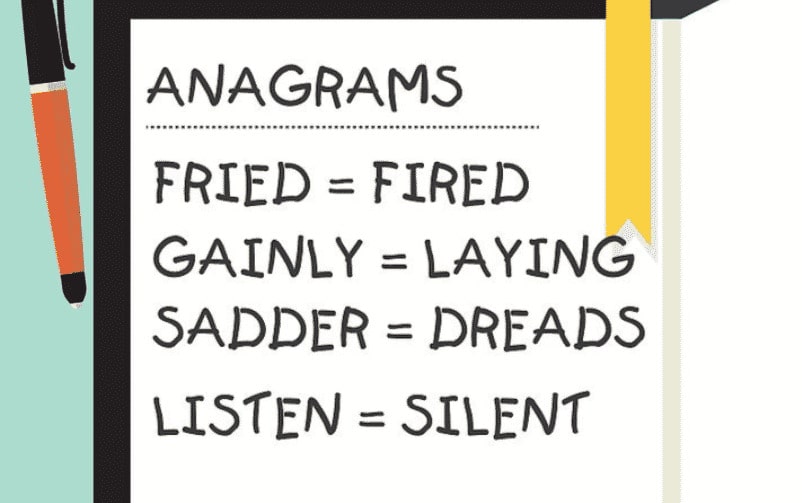
Think up a word and have everyone else try to figure it out. Expect some hilarious answers as everyone chips in.
How to play: Jumble up the letters but ensure that they create a five or six letter word anagram when correctly aligned. Only the presenter should suggest the word, and the activity should be timed. People can submit their answers live on MeetingPulse .
19. Two truths and a lie

The players get to tell two truths and one lie about themselves and the audience deciphers which one is the lie.
How to play: The player chooses a topic, like “career.” They tell two real facts about their career and one lie. The audience then decides which statement is false and why they believe that.
20. Choose the Agenda

In this activity, the participants choose the agenda of the meeting instead of being told what it is. This allow them to address burning issues.
How to play: Participants are invited to submit their agendas, which are shared by everyone and then voted on. The one with the most votes becomes the main agenda for the meeting. This gives participants control over the meeting as well.
You can use MeetingPulse’s brainstorming tool with the upvoting feature for this!
Final Thoughts
Now that you know some of the best interactive presentation games, you’re ready to host your next event with new and creative ways to keep your audience engaged. MeetingPulse is a great tool and resource for you to make your presentations more memorable and — dare we say it — fun.
Related: 25 Fun Poll Questions to Ask Your Audience
Get started with MeetingPulse today!
Share this article on your socials, latest posts.

The Benefits of Language-Inclusive Meetings and Events

Understanding the Pain Points of Language Barriers at Your Meeting and 7 Tips for Breaking Them Down with Technology

There’s only one way to determine if customers are satisfied – ask them

Proactively Managing Employee Engagement, Development, and Satisfaction
Blog categories.
- Audience Response Tools
- Best Practices
- Employee Engagement
- Event Planning
- Hybrid Events
- Leadership Techniques
- Meeting Prep
- Organizational Development
- Uncategorized

To make MeetingPulse a seamless addition to your meetings, we offer custom themes. You can use your own logo and your colors in Attendee View as well as Broadcast View. Your company name can also be included in the webpage’s title. Your meeting can also have its own domain. This is great if you are going to promote your meeting offline. For example, you could use “acme2022.com” instead of “meet.ps/acme-all-hands”.

Live Product Tours
Weekly Product Tour Every Wednesday

- Success Stories
- Integrations
- Help center
- Cvent Marketplace
- Connect with Zapier
- Trust Center
- System Status
10 interactive presentation ideas that leave a lasting impression

Attention is the gatekeeper of our memories. If you can’t get the audience to sit up and pay attention, your presentation will soon be forgotten.
In her webinar, Using neuroscience to create presentations with lasting impact , Dr. Carmen Simon, cognitive scientist and founder of Memzy , emphasized the importance of attention when forming new memories. According to Simon, one of the best ways to win attention is to insert a “cut” every three minutes.
Attention is definitely mandatory to people remembering the right things, and not just random things.
“Cuts” are simply a break from your normal presenting style, such as switching from a lecture to a Q&A or trivia question. Switching styles this ways keeps the audience intrigued about what comes next. Below are 10 interactive presentation ideas you can use as “cuts” in your own presentations.
Some of these ideas rely on Poll Everywhere, a live audience response system that lets you ask the audience a question and show live results. Try it out by signing up for a free account today.
Warm up the audience with an interactive icebreaker
Signal to the audience that this will be an interactive presentation by opening with an easy icebreaker. Kick it off before your presentation starts, as people are finding their seats, to get everyone familiar with the ins and outs of Poll Everywhere in a low-stakes setting.
Doing so speeds up the time it takes to complete subsequent activities because the audience will expect them. They’re also more likely to engage with you on Poll Everywhere if they’re already comfortable with the process.
Icebreakers come in many styles , but one of the most popular among Poll Everywhere users is the word cloud. Choose a question that calls for a personal response – What’s your favorite food? – that everyone can answer.

Plant engaged audience members ahead of time
This isn’t as sneaky as it sounds.
Sometimes all it takes is a few engaged people in the audience to get the discussion flowing, and give other people the courage to contribute. But what if you can’t count on your attendees to speak up on their own?
Ahead of your presentation, ask a few audience members who you already know and trust to pose specific questions during your presentation.
Maybe you want them to chime in with an easy “gimme” to kick things off and encourage that level of engagement. Or, maybe you want your designated attendee to ask a question that everybody else may be too afraid to ask (i.e. “How do we know we can trust this data?”).
This strategy won’t be necessary for every presentation. But when you’re worried that your request for questions will be met with lowered heads and shifting glances, this is an effective way to get the ball rolling.

Read more: From classroom to boardroom: A high school teacher’s presentation tips
Repeatedly ask questions to build involvement
You can’t expect your audience to engage and interact with you if you don’t give them an opportunity. So, make sure to have plenty of spots throughout your presentation where you can pause and ask a question.
This doesn’t need to be a threatening, pop quiz-style way to scare your audience into paying attention. Even the simplest questions can make people feel a little more involved in what you’re presenting. Think of things like:
- Have you heard of this before?
- Can you read what’s on that slide for me?
- Does anybody know where/what [thing] is?
They’re straightforward questions that require a one-word answer or super easy response, yet they do the job of reminding your audience that you’re talking with them – and not just at them.
Get people moving and out of their seats
It’s time to get your audience’s blood pumping. No, you don’t need to have them do jumping jacks or pushups, but think of some creative ways that you can get them moving around a little bit.
It could be something as simple as asking people to stand up, rather than requesting a show of hands. Or, you could think of some ways to incorporate movement with the content of your presentation. For example, have them walk up and introduce themselves to somebody new to implement the elevator pitch techniques you just taught them.
Give some thought to the different ways you could get your audience out of their seats at a few different points throughout your presentation. If nothing else, you can rest assured that they’re awake.

Read more: 8 interactive presentation games for large teams
Use interactive questions to assess the audience
If you want to know if the audience really understands what you’re presenting, ask.
Christopher Robertson , who teaches at University of Arizona’s James. E. Rogers College of Law, uses Poll Everywhere to identify and resolve any misunderstandings his students have about the complexities of law.
“Law students can easily go an entire semester passively attending class and both the professor and student discover on the final exam that they have not grasped the concepts covered in class,” said Robertson.
I find polling in class encourages active student participation and uncovers misunderstanding of how to apply the law that warrant a second look.
Taking time to test the audience this way gives them a chance to reflect on what you told them, and apply that knowledge on the spot. This can improve the chances they’ll remember that information after your presentation ends.
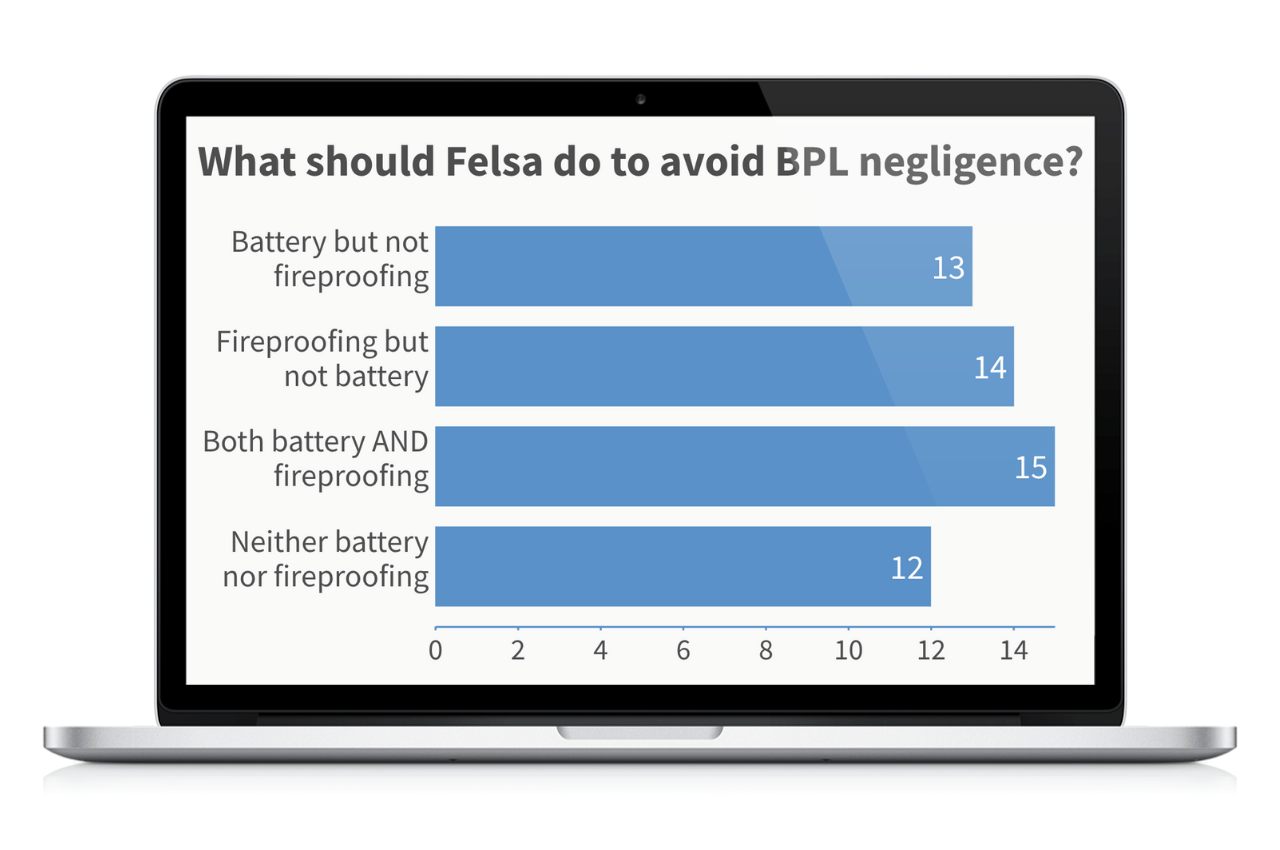
Enable anonymity to encourage candid feedback
Dr. Mark, physician and author of The Productive Physician , uses anonymous polling in his medical classes. He cites how this extra layer of security helps put students’ minds at ease, and lets them focus on the lesson instead of worrying about scrutiny from their peers.
“Poll Everywhere allows both anonymous and signed-in polling,” explained Dr. Mark, “but I prefer to use the anonymous mode as I feel it increases learner psychological safety: my students might be more inclined to test their knowledge without the fear of being seen to be wrong in front of their peers.”
You can enable anonymity for all Poll Everywhere activity types. The audience responds from the privacy of their phones – not in front of their peers – giving everyone an equal opportunity to make their voice heard.

Split your audience into smaller discussion groups
There’s nothing worse than explicitly asking your audience to engage with you and being met with only crickets and blank stares.
But, here’s the thing: Not everybody is comfortable speaking up in front of a crowd.
For that reason, it can be smart to divide your audience into smaller groups to discuss something relevant to your presentation topic – even if it’s just for five minutes.
If you want the whole audience to come back together and share what they learned during those conversations, it’s likely that a spokesperson will naturally arise from each group; meaning the people who aren’t comfortable chiming in on a large scale don’t have to.
The best thing about this strategy? The previously-reserved attendees will have a little more confidence to speak up when they know the rest of their group is there to jump in if needed.

Read more: How to present an effective PowerPoint presentation
Encourage questions throughout your presentation
It’s natural to want your audience to hold on to all of their questions until a Q&A portion at the conclusion of your talk. However, that’s pretty much the exact opposite of an interactive presentation.
Instead, be upfront at the beginning of your presentation that you want people to chime in with thoughts or questions, rather than biting their tongue until the very end. Of course, you’ll need to be willing to step in and get things back on track if a question steers the conversation too far off course.
If you don’t want the interruptions, find a way for people to submit questions asynchronously , such as in a chat window or shared document. You can respond to those submissions at your own pace throughout the presentation.
Either way, encouraging people to contribute to the topic in real-time is far more interactive and engaging than forcing them to sit and wait until the end.

Let the audience decide what’s next
Presentations don’t always need to flow in a straight line. With a quick question, you can empower your audience and let them decide what to learn about next.
Poll Everywhere’s own Katie Wilson gave a webinar on this very topic. In it, she explained how corporate trainers use polling to create choose-your-own-adventure style presentations .
Present your audience with a multiple choice activity, and let their votes determine which topic you tackle next. In Katie’s example, a corporate trainer is asking about how best to respond to a customer complaint.
Three options are available, and the audience votes on which one they think is most appropriate. Once the results are in, the presenter navigates to the slide associated with that option and discusses the results.
Use surveys to extend interaction after your presentation ends
Audience interaction doesn’t have to end with the presentation.
Jez Wiles, lecturer at the London College of Music, continues the conversation with his students both before and after his lectures with online questionnaires.
“Getting [students] to use a survey as a post-class reflective tool, or pre-lecture poll to find out what they know about something…this has all extended the use of [Poll Everywhere] for me, and boosted engagement,” said Wiles.
Poll Everywhere surveys can include any type of activity – from multiple choice to open-ended – and can be completed asynchronously at the audience’s own pace. This is a great way to help reinforce the topics of your presentation, or to collect audience feedback on the presentation itself.
I like the sense of fun Poll Everywhere naturally brings. I always find engagement goes up when I use it.
These are just some of the ways the Poll Everywhere community uses live audience engagement to drive interactive presentations. Each of these ideas is a type of cut you can use to keep your audience alert and engaged with what you’re saying.
Related articles

- SUGGESTED TOPICS
- The Magazine
- Newsletters
- Managing Yourself
- Managing Teams
- Work-life Balance
- The Big Idea
- Data & Visuals
- Reading Lists
- Case Selections
- HBR Learning
- Topic Feeds
- Account Settings
- Email Preferences
6 Super Fun Activities for Your Next Virtual Meeting
- Christopher Littlefield
Bring a little laughter into your workplace.
Research has shown that many have experienced a decline in well-being since the start of the pandemic. While laughter is not a cure-all, it is an action that decreases depression and anxiety, and one that is also a scarce commodity right now.
- The easiest way to infuse some joy into your workday is by having a little fun during your team meetings.
- Use the rule of 1/6: for every hour of meeting time, 1/6, or 10 minutes, should be devoted to relationship-building. On some days you can use this time to check in on people’s well-being, and on other days you can use it to laugh, have fun, and play together.
- It doesn’t matter if you are a manager, a new employee, or seasoned contributor. Everyone can play their part in bringing some laughter and joy to team meetings with these fun virtual games that require little or no prep and can be played in under 10 minutes.
Where your work meets your life. See more from Ascend here .
After a brutal year of working remotely — and often alone — many of us have forgotten the importance of allowing ourselves moments of joy. In fact, sometimes the very thing we need to brighten the repetitive days of back-to-back meetings and email overload is … laughter.
- Christopher Littlefield is an International/TEDx speaker specializing in employee appreciation and the founder of Beyond Thank You . He has trained thousands of leaders across six continents to create cultures where people feel valued every day. He is the author of 75+ Team Building Activities for Remote Teams—Simple Ways to Build Trust, Strengthen Communication, and Laugh Together from Afar . You can follow his work through his weekly mailing The Nudge .
Partner Center

Work Life is Atlassian’s flagship publication dedicated to unleashing the potential of every team through real-life advice, inspiring stories, and thoughtful perspectives from leaders around the world.

Contributing Writer
Work Futurist

Senior Quantitative Researcher, People Insights
Principal Writer

18 virtual team building activities and games
This isn’t academic theory or some stuff we just made up. This is how real remote teams have fun and stay connected.

5-second summary
- Building bonds between teammates is extra-important when you’re in remote or hybrid mode, as a growing body of research confirms.
- Whether an activity is just for fun or helps move your work forward, taking time to help your virtual team to get to know each other is an investment that pays dividends in team cohesion and performance.
- We collected a list of activities used by real teams at Atlassian that can help virtual teams get to know each other as people and colleagues.
The bad news: team building is a lot more challenging when all or some of your people are working remotely. Try as you might, you just can’t do trust falls over Zoom. (Also, no one likes trust falls anyway.)
The good news: we have a trove of the best virtual team building activities to share with you. These are the same super-creative, road-tested, remote-team-approved activities that we use here at Atlassian.
Get stories about tech and teams in your inbox
What is virtual-team building?
Virtual team building means creating human-to-human connections between your remote team members. Forging these bonds not only promotes team harmony, it can also help streamline communication and increase productivity.
Distributed eam bonding is a topic that matters deeply to us. We have a Team Playbook of exercises and workshops to help teams work better together (not to mention a guide to hybrid meetings for when it’s time to get down to business). It’s important to take time out to build connections while having fun, too. And, as a company of several thousand people distributed across five continents, we’ve had plenty of chances to act as test subjects for both flavors of virtual team-building activities.

Keep your virtual team connected with these proven rituals
How do you do team building virtually.
The best way to connect remote teams is to help them feel seen and heard, literally, and in ways that directly address the challenges of a dispersed workforce.
In mid-2020, we ran a survey on remote work , which uncovered the real-world complications we’re all facing with distributed work: feeling that our work is “invisible,” navigating new barriers to organic collaboration, and having less access to our managers. When we ran a similar survey in 2021 , we found that, although some of the initial challenges we faced have eased up a bit, teams are still struggling with belonging and cohesion.
The common thread here is that working from home can be lonely. Spending less time in an office environment means fewer built-in opportunities to form social bonds and build trust with colleagues. That can lead to disengagement, which, in turn, can lead to poor performance on the job.
That’s no small deal. In fact, 94 percent of workers we surveyed said that mutual respect and connection were critical to their team’s success, and 19 percent said it’s the most important factor in their sense of well-being at work. Understanding each other on a personal level means we can communicate more effectively and have an easier time distributing roles and responsibilities across the team.
So how can teams overcome these hurdles?
Tools of the trade
We use Trello boards as sort-of a virtual whiteboard, Slack as our chat tool, and Zoom for video conferencing. You’ll need at least one of these tools (or their equivalent) for each of the activities shared here.
Fun remote team building activities for any occasion
Choose what’s right for your team based on these categories:
Real-time vs. asynchronous – Do you need to do this simultaneously, or can each person participate at whatever time works best for them?
Practical vs. just for fun – Is the activity intentionally unproductive (which is not necessarily a bad thing), or does it serve the dual purpose of building social bonds and improving the way you work in a more tangible way?
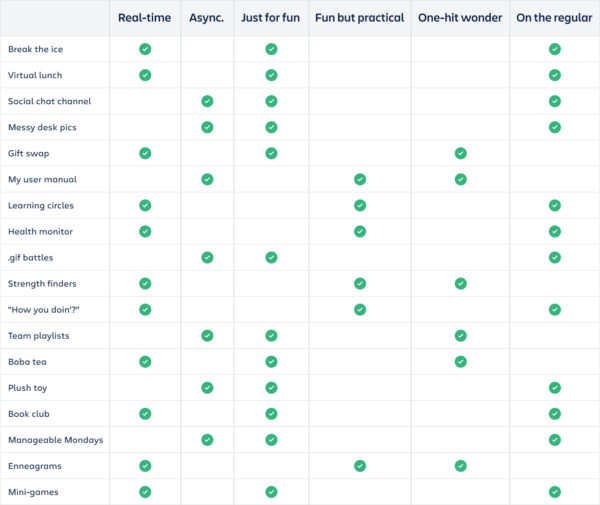
18 ideas for virtual team games and activities
1. don’t overlook the classic: icebreaker questions 🧊.
Type: real-time, just for fun, on the regular
Time: 5 minutes
Tools required: video conferencing
Before you roll your eyes and go “Duh … like I hadn’t already thought of that,” understand that some of our distributed teams (my own included) do an icebreaker at the start of our team meetings every week. Even though we’ve been working together for a couple of years and feel pretty connected already, there are always more interesting tidbits to learn about each other. Some recent favorites include:
- Who was the last artist you searched for on your music streaming service of choice?
- What are your parents’ best qualities?
- Put these morning routine items in order: breakfast, coffee/tea, open up your laptop.
- What was something that always frightened you as a child?

Small talk at work has big benefits
2. have an online lunch date 🍱.
Time: 60 minutes
This one comes from the engineering team that built the Trello app for Android. Once a month, the team links up via video conferencing over lunchtime. Team members can even expense up to $25 so they can join from their favorite cafe, order delivery, or cook up a little something special at home (because, real talk: heating up leftovers gets old).
Only have 15-30 minutes to spare? No worries. Virtual coffee chats and virtual happy hours are fun variations on this activity.
3. Socialize over group chat 💬
Type: asynchronous, just for fun, on the regular
Time: varies
Tools required: Slack, Teams, or other group chat app
Group chat is an ideal way for distributed teams to stay in touch, but who says you have to keep it strictly business? Pre-pandemic, Atlassian set up a channel in Slack called #social-remote where we remote workers (which is now pretty much all of us), talk about what we had for lunch, compare notes on standing desks, share articles related to remote work, and generally discuss anything but the projects we’re working on.
There are even off-shoot channels for cities or states where clusters of “Remote-lassians” live. Let’s just say that more than a few hot-dish recipes have been swapped in the #minnesota channel.
4. Have a messy-desk photo contest 📸
When you work in an office, you feel compelled to keep your desk at least minimally clean: no used tissues, three-day old cereal bowls, or constellations of coffee rings.
But when you work from home, there’s no such social contract to uphold. So one of our rituals in the #social-remote Slack channel is “messy desk Thursdays” in which we out ourselves for the abysmal state of our workstations while the ROTFL 🤣and 🤦🏽♀️ facepalm emojis fly fast and thick.
It’s also a chance for your preternaturally tidy teammates to do some humble bragging about their austere, magazine-worthy office spaces.
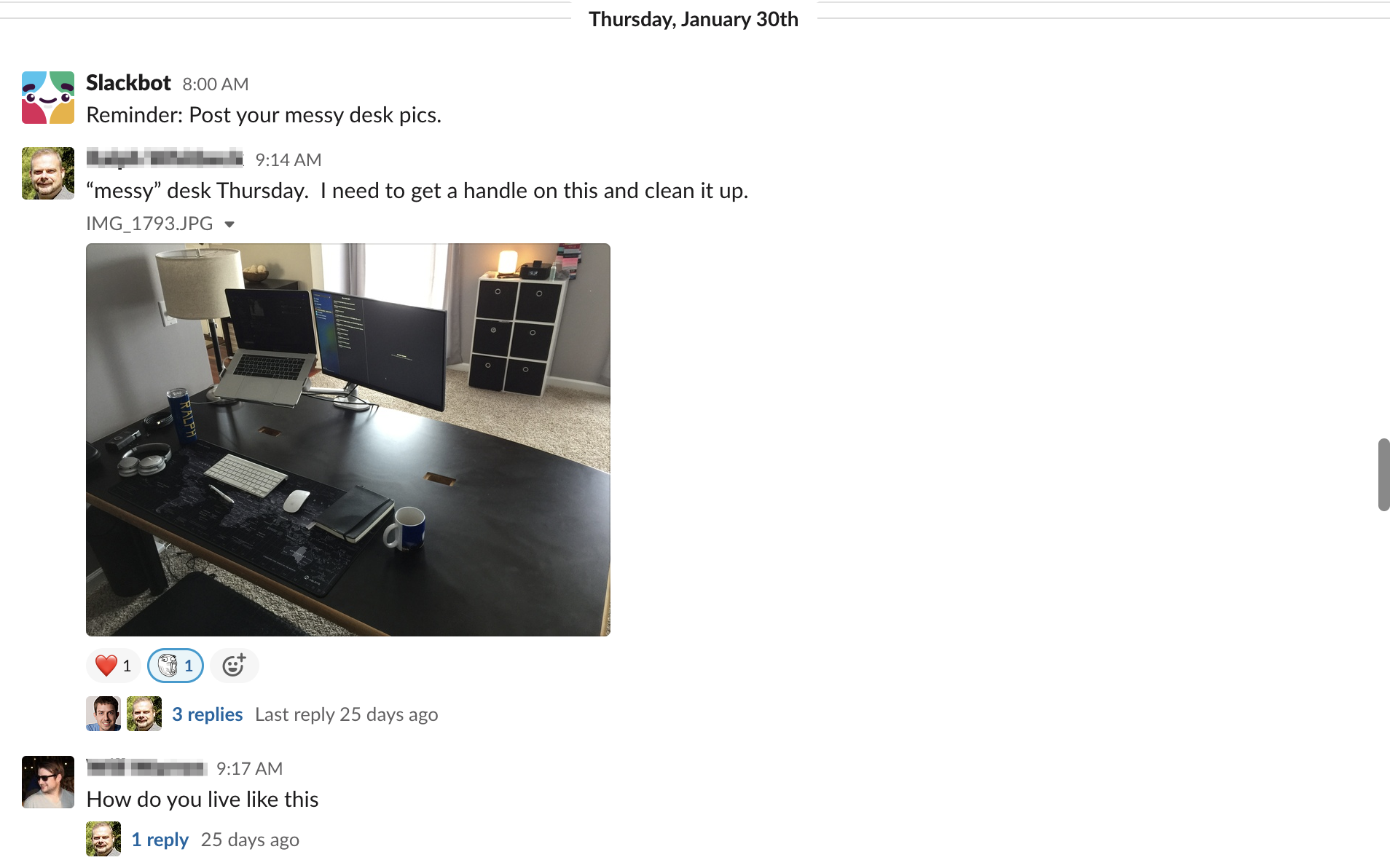
5. How do you make online meetings fun? Presents 🎁
Type: real-time, just for fun, one-hit wonder
Tools required: video conferencing, Trello board
Whether your team prefers white elephant style or something more thoughtful, you can pull off a gift exchange even if you’re not at an offsite. Start by copying this handy Trello board template and inviting your teammates to join. It has full instructions in the “Rules” column, but here’s the gist. Each team member buys a gift that can be shipped easily. Instead of announcing what the gift is, you’ll add a card to the board with a picture and title that provides a hint.
During the game, you’ll take turns clicking on cards to reveal what the gift is. Once you turn over a card, you’ve claimed that gift. You’ll also get chances to steal a gift someone else has already claimed. After the game is over, mail the gift you contributed to the person who ended up with it.
6. Teach people how to work with you with “My User Manual” 📋
Type: asynchronous, fun but practical, one-hit wonder
Tools required: Keynote or PowerPoint
When you’re just forming as a team, or when a new member joins, it’s worth taking the time to share your personal workstyle. Do you prefer chat or email? What time of day do you do your best heads-down deep work? Are you cool with impromptu video calls? Check out this example from the CEO at CultureAmp:
Inspired? So were we. That’s why we created the My User Manual play, where you’ll find instructions on how to run this exercise in your team. Set up a meeting to review everyone’s “user manuals” in real-time, or share the decks so people can review them asynchronously. Either way, collect the decks in a central repository where future team members can access them.
7. Expand your professional skill sets together with “Learning Circles” 📚
Type: real-time, fun but practical, on the regular
Time: 30-60 minutes
Tools required: video conferencing, study materials as needed
It’s easy to get so caught up in executing on your work that you forget to expand your horizons, especially when working from home with no office banter happening around you. Plus, remote work can be isolating if you don’t make a point to connect with your teammates on a personal level.
Our Learning Circle play can address both issues. Choose a topic related to your work that you want to learn more about – anything from SQL to leadership styles to trends in recruiting practices – and find colleagues who share that interest. Each month, gather over video conference to discuss a book or article, or have someone in the group give a short presentation. The best part about learning circles is that you can extend them beyond your immediate team and connect with people across the entire organization.
8. Take your team’s pulse with “Health Monitor” 🩺
Tools required: video conferencing, Confluence, or Google Docs
Health Monitor is a variation on the classic agile retrospective. It prompts you to examine how you’re working together, instead of what you’re working on.
Through extensive research, we identified eight attributes that healthy, high-performing teams tend to have in common, then developed the Health Monitor as a framework for assessing how your team is doing in each area. Do you have the right balance of skills on the team? Are you making decisions effectively? Do you understand the dependencies around your work? Here’s a one-minute overview, staring yours truly.
Although this activity was not designed specifically for remote teams, it’s amazingly beneficial. When your team doesn’t sit shoulder-to-shoulder, it feels easier to sweep issues under the rug rather than address them head-on.
But little problems have a way of growing larger while you’re not looking, and eventually, you’ve got a crisis on your hands. Health Monitor prevents this by prompting teams to self-assess on a regular basis and keep their weaknesses from becoming full-blown liabilities.
9. You can’t have Nerf wars, but you still have .gif battles 💥
Time: 15-30 min
If you’ve ever been jealous of the Nerf dart wars waged by your co-located colleagues and friends, you’ll love .gif battles. Copy this Trello board template and invite your teammates to join it. (Click on the “How it works” card to see full instructions for the game.)
The game consists of four rounds, each with its own theme. You’ll use Giphy.com or Google Images to find a .gif that fits with the theme for that round and attach that gif to a card. Once everyone has their .gifs in, you’ll vote on the round’s best submission. At the end, the person who wins the most rounds will be crowned the Ultimate .Gif Battle Champion of All Time™. Just think of the glory! Don’t be afraid to add a tiebreaker round if needed.
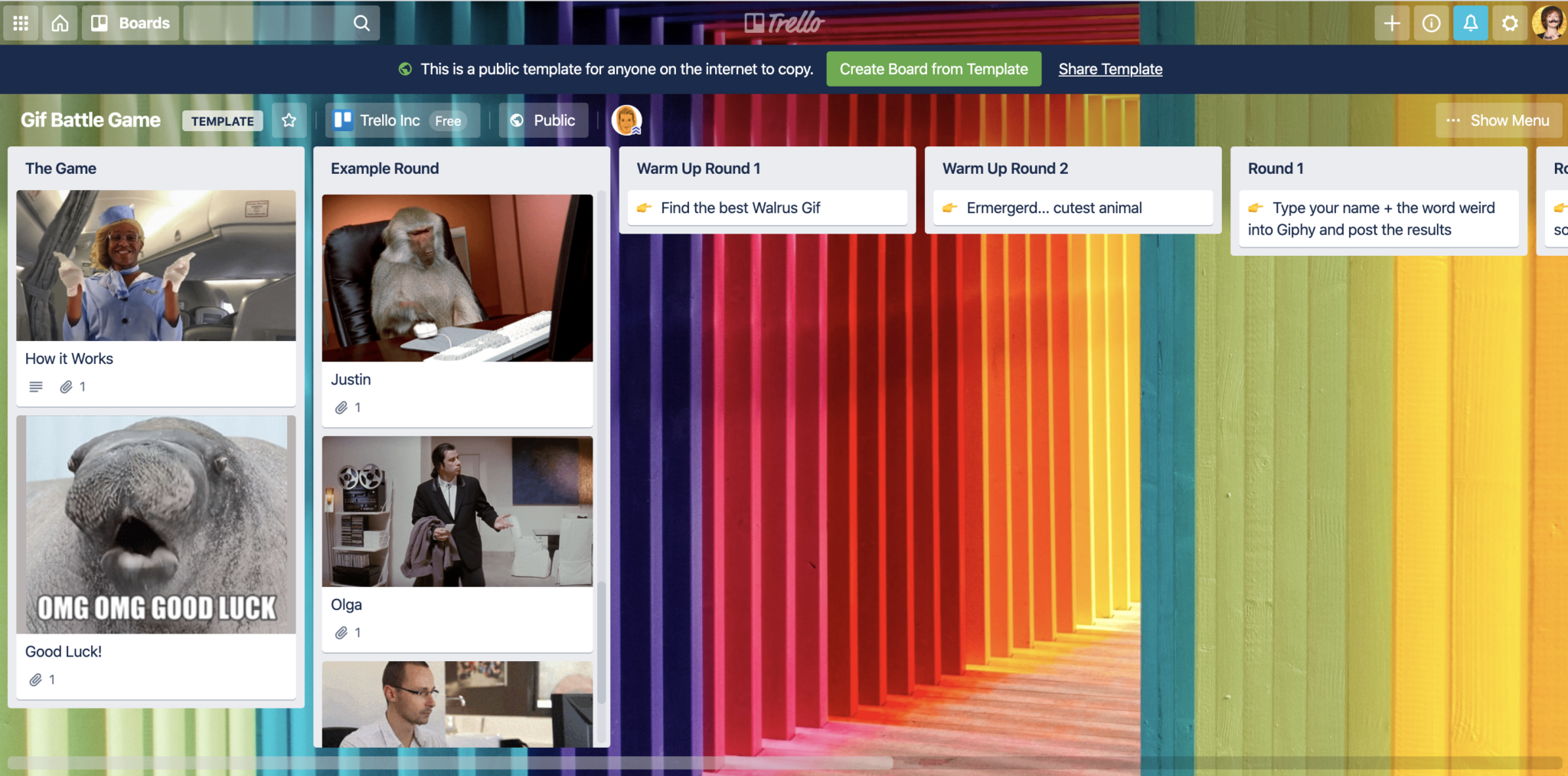
10. Uncover your superpowers 🦸🏽
Type: real-time, fun but practical, one-hit wonder
Time: 30 min individual prep, 60 min as a team

If you think “water cooler moments” unlock creativity, you’re focusing on the wrong thing
If you’re ready to go beyond surface-level connections with your team, this is the activity for you. Each person will prepare for the session by taking an online strength finder assessment such as Clifton Strengths . During the group session, everyone hops on a video call and takes turns sharing their results.
When my team did this, each person shared top three strengths, lowest-ranked strength, and something in our results that surprised us. Then we’d discuss as a group how that person’s top strengths contribute to the team already, and how we could make even better use of them.
This is an intensely personal activity. You’re going to feel a bit vulnerable and exposed, so it works best if there’s already a sense of psychological safety amongst teammates. But because you’re discussing each other’s strengths, the conversation tends to be very positive and affirming. Chances are, everyone will walk away with a deeper sense of belonging and an understanding of the unique value they bring to the team.
11. “How you doin’?” 👋🏽
Time: 5 min
(This one is so much better if you say the words “How you doin’?” in a low, Jersey mobster voice – think Sal from “The Sopranos.” But I digress… ) The team that looks after the Atlassian Community website and our user groups added this five-minute ritual to the beginning of their weekly team meetings.
The board they use to track agenda items includes a space for each person to add a card representing how they’re feeling that week. Maybe they’re struggling with something in their personal life and are a bit low-energy. Maybe they finally ran that 10k over the weekend and are PUMPED for the week ahead. It’s an easy way for teammates to let each other know when they might need some extra support or patience, or when they’ve got good vibes to spare.
12. Make sweet music together 🎶
Tools required: Spotify or Google Play, Slack or other group chat app
Raise your hand if you and your remote teammates talk about music. (Thought so. Pretty much everyone does.) The content team at Trello is no different… but they’ve gone next-level with it. Using Spotify, they create collaborative playlists that anyone on the team can listen to and help curate.
Try creating an upbeat, “get $#!t done” playlist, a soothing “de-stress” playlist, or any other theme that suits your team.
13. DIY boba tea 🧋
Type: real-time, just for fun, one-hit wonder
Time: 2 hrs
Tools required: video conferencing, kitchen
Y’know how boba tea (sometimes called bubble tea) costs like $6 at a retail shop? It sounds overpriced until you realized how labor-intensive it is! About 50 members of our marketing team learned this first-hand when we did a virtual boba-making session. Each participant received a kit containing all the ingredients (we used this one ). Then, an expert guided the whole group through the process – it really does take two hours to make a batch! But that provided plenty of time for icebreakers and general chit-chat while ingredients cooked and/or cooled.

14. The fellowship of the traveling plush toy 📦
Type: asynchronous, just for fun, on the regular
Time: varies
Tools required: Slack or other group chat app
A cross between the gnome prank in Amélie and the Flat Stanley craze, this ongoing activity yields months of fun. Choose a plush toy or doll that will be easy to pack up and mail – we had a custom plush made in the shape of our logo, and named it “Ace” – and set up a rotation so it travels between team members. When it’s your turn, use your chat channels to share photos of the plush hanging out with you, then pack it back up and mail it to the next person after a week or so.

15. Birds of a feather read books together 🤓
Type: real-time, just for fun, on the regular
Time: 30-60 min for discussion; reading time varies
Tools required: video conferencing, Slack or other group chat app
Calling all bookworms! If you’re like me, then you know that the only thing better than reading a good book is discussing it with friends. Or, in this case, colleagues who also enjoy books (which, really, is pretty close to friends anyway).
Our brand content team runs a casual book club where the only parameter is that the books we choose must have nothing to do with our jobs. We use a Slack app called Polly to vote on book selections and when to meet over Zoom (and drinks) to talk about it.
16. Monday JAMM sessions 📆
Time: 5 min
Tools required: Slack or other group chat app
“So, how was your weekend?” The Atlassian brand and events teams took this time-honored Monday morning question into the virtual world by sharing stories and photos from their weekend over chat – but with a twist. To help put themselves in the best mental space possible for the week ahead, they focus on sharing the most positive and rejuvenating aspects of their weekend that will help them power through the week. Each entry starts with JAMM, which means “just another manageable Monday.” For example, “JAMM because I got to an amazing hike on Saturday!” Think of it as part gratitude practice , part pep-talk. It’s been such a hit that it’s spread to other teams, too!
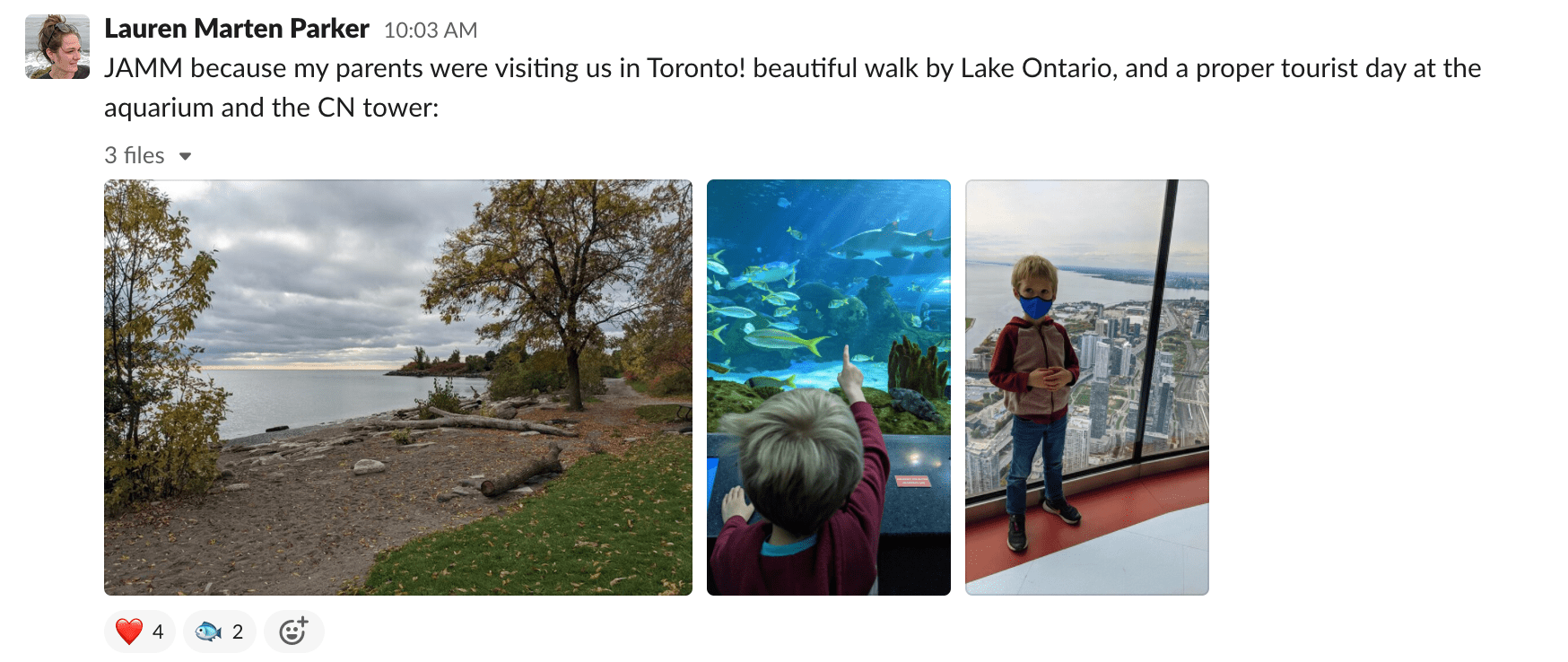
17. Enneagrams for everybody 🥸
Type: real-time, fun but practical, one-hit wonder
Time: 2+ hours
How well do you really know each of your teammates? Take time out for a deep dive into your personalities by using the Enneagram system . You’ll walk away with a better understanding of what makes everyone tick, and you’ll probably get some juicy insights into your own personality as well. (I sure did!)
Unlike finding your Myers-Briggs type or your zodiac sign, Enneagram asks you to self-identify your personality type based on the descriptions for each one. From there, you can explore how to best get along and communicate with other types. It’s a self-awareness + team harmony win-win.
18. A lightning round of mini-games 🕹
Time: 1-2 hours
Game apps for tools like Zoom and WebEx can be a ton of fun. (Hot tip for Zoom users: try the Kahoot! trivia app .) It’s a great way to add extra flavor to your virtual team lunches or kill a few minutes while you’re waiting for people to trickle in at the start of a meeting.
Now go forth and bond!
Get more stories like this in your inbox
Advice, stories, and expertise about work life today.
- Virtual Experiences
- In-Person Experiences
- Hybrid Experiences
- Social Calendar [New]
- Experience FAQ
- Features & Benefits
- How Pricing Works
- Client Testimonials
- Happiness Guarantee
- Blog Articles
- Video Library
- View Experiences
26 Fun Virtual Meeting Games to Energize Employees
By: Grace He | Updated: March 14, 2024
Here is our list of fun virtual meeting games .
Virtual meeting games are group activities to play on platforms like Zoom, Teams, and Webex. These challenges use websites or simple onscreen activities to connect players. For example, online escape rooms, trivia games, and virtual happy hours. The purpose of these activities is to energize online meetings and to help remote coworkers interact.
These exercises are online versions of team meeting games , and are examples of video call games , activities for conference calls and virtual team meeting ideas , and are a way to make virtual meetings fun .
This list includes:
- virtual meeting room games
- games for virtual meetings
- online meeting energizers
Here we go!
List of virtual meeting games
Virtual meeting games include guided online activities, competitive tasks, and board games. Here is a selection of virtual meeting room games and activities that are easy to use, including many free options.
1. Buzzword Bingo
Buzzword Bingo is an easy virtual meeting game. Simply email your team Bingo cards filled with common meeting phrases. Each time players hear a phrase on the card they can mark it off. The first player to have five marked squares is the winner. You can also make requirements for horizontal, vertical, or diagonal lines.
Some fun Buzzword Bingo Words to use:
For more card options, check out this icebreaker Bingo generator .
2. Online Drinking Games
Online Drinking Games are great virtual meeting games for large groups. There are many challenges to complete with teams during online happy hours. For instance, the group can compete in an online cocktail mix-off, drink every time a word or phrase appears, or play truth or dare. Your team can also raise a few toasts to accomplishments and face off to create the best toast on the spot.
If participants do not drink alcohol or if you would rather not encourage on-the-clock drinking, then players can use non-alcoholic drinks like coffee, soda, or water.
Check out this list of online drinking games .
Get our free team building toolbox
- icebreaker games
- bingo cards

3. Scavenger Hunt
Scavenger hunts send your teammates around their houses and are an excellent way to get meeting participants moving and energized. The meeting leader creates a list of unique objects for players to find. You can organize the list using items from specific rooms in the house. Hyper-specific objects like one used eraser, one red jellybean, and one blue button, will make the search extra challenging.
Here are virtual scavenger hunt starter lists .
4. Search Engine Savvy
Search Engine Savvy is a virtual meeting game that uses internet searches to lead players around the World Wide Web! You can create a treasure map that identifies exotic items in various locations. Your team then searches for those images. Each player makes a catalog by pasting screenshots into a document or spreadsheet to present to the team. Each participant will end up with a unique take on the hunt.
Some starter suggestions:
- Exotic animals
- Expensive cars
- Special flowers, plants, and trees
- Unique buildings
- Street signs with specific names or words
You can also include meaningful items to your team members or your organization.
5. Coffee Talk
Online coffee talk sessions are fun virtual meeting games to play with employees as a get-to-know-you activity. Using an app like Donut, you can pair up your team members and encourage participants to schedule a 15 or 30 minute video call. Partners can discuss hobbies and interests, friends and family, or work and professional goals. The only rule is to avoid work talk! During meetings, you can also facilitate the activity by sending attendees to breakout rooms in random pairs.
The goal of this game is to help team members become more familiar with one another.
Check out more get to know you activities , and this guide to virtual coffee breaks .
6. Virtual Team Trivia (Popular)
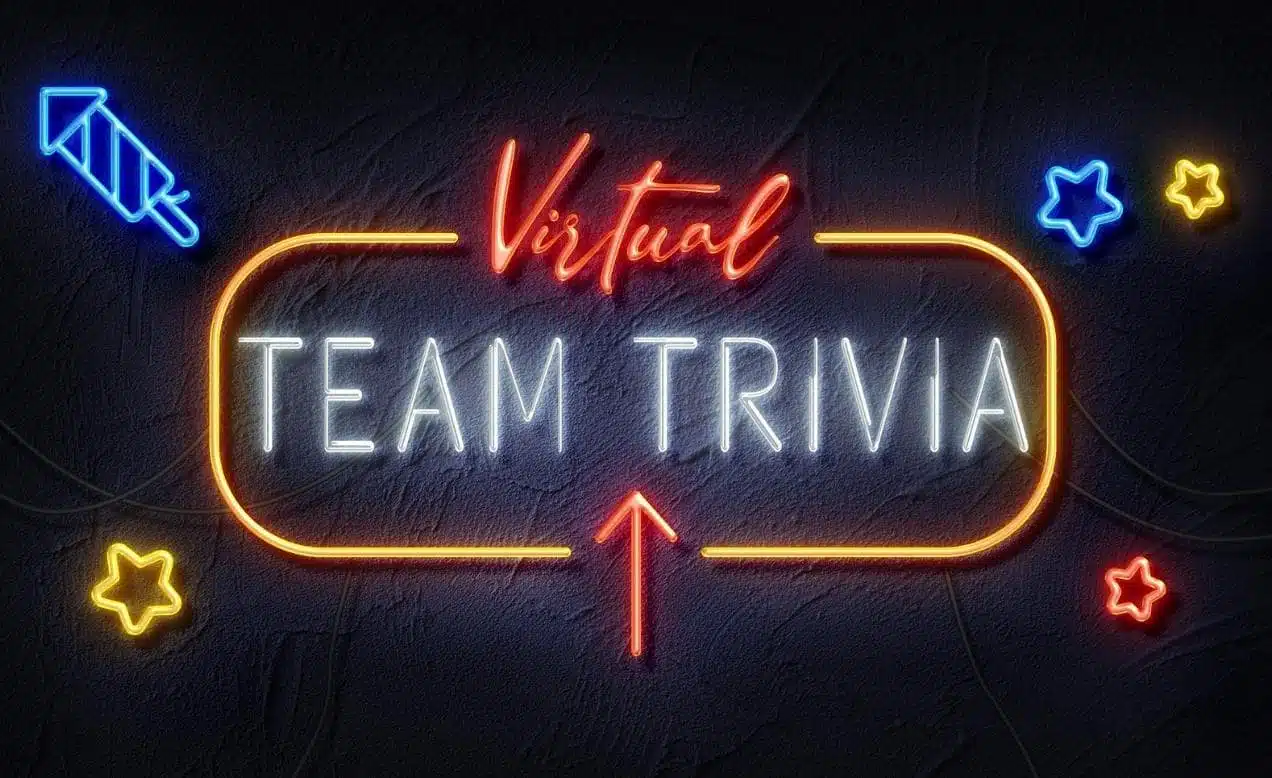
With Virtual Team Trivia, you can tailor all the questions to match your employees’ answers during this fully hosted event! Virtual Team Trivia brings the ambiance of a bar trivia night from the comfort of your own space. This head-to-head competition sparks excitement and fosters friendships among participants.
Virtual Team Trivia offers the following features:
- a 60-minute session guided by a talented host
- icebreakers, small groups, and catchy team names
- themed trivia or customized questions
- lively group discussions and clever pun-based wordplay
To make the experience more like a bar trivia night, consider adding on cocktail and s’mores kits. Virtual Team Trivia is a fantastic choice for improving your team’s relationships and boosting morale!
Learn more about Virtual Team Trivia .
7. Murder in the Speakeasy (Highly Rated)

Players can fully immerse themselves in the glitz and glamor of the vibrant Roaring ’20s with Murder in the Speakeasy! Participants will dive into a world of clubs and characters inspired by real-life personalities from the 1920s. Throughout this captivating journey, participants will solve a historical murder mystery.
Here is what you can look forward to:
- a 90-minute experience led by an expert host
- an intriguing story centered around a mysterious murder
- clues and puzzles that reflect the glamorous era
- renowned politicians and musicians who frequented the famous Krazy Kat club
Teams will travel back in time and work together to uncover the truth behind this jazz-era crime. So get ready to showcase your problem-solving prowess with Murder in the Speakeasy!
Learn more about Murder in the Speakeasy .
8. Online Karaoke
Online karaoke is one of the top online meeting energizers to get your teammates engaged. You can coordinate an online karaoke session featuring your choice of genres or eras. Attendees take turns following the lyrics on the screen and sing into their microphones. You can encourage team members to prepare food and drinks to snack on to recreate the atmosphere of a real karaoke bar.
There are online karaoke sites like Karafun and Singa that give you a platform for your event. Some offer free versions, while other sites require a subscription.
9. Talent Showcase
You can host a talent showcase that lets your attendees become stars of the virtual meeting. Employees can perform a skit, sing a song, or demonstrate a talent. Encourage team members to choose their most incredible talent to showcase. Bizarre and unexpected talents make for an especially fun event. To do the showcase during an online meeting, spotlight each performer accordingly.
Pro tip: Performers with similar talents can team up for group acts and practice collaboration.
Check out this guide to doing online talent shows .
10. Name That Tune
Name That Tune is a familiar activity you can adapt for virtual staff meeting games.
How to play:
- The game leader creates a playlist of well-known songs.
- The game leader asks player one how many seconds they need to hear to guess the name of the song. Then, the game leader asks player two the same question.
- The player who bids the smaller number tries to guess the name of the song after hearing their chosen length.
- If that player cannot guess the song, then the other player has a chance to guess.
- The player who guesses the correct answer wins and moves on to challenge another player. If neither player guesses the answer, the leader moves on to two new players.
Here is a list of high energy songs for conferences that work well for this game.
11. Headline or Head Lie?
Headline or Head Lie? is a virtual team meeting game that tests the internet savvy of your team.
Here are the rules:
- The game leader gathers true headlines from around the internet.
- The game leader creates two alternate headlines for each headline.
- The game leader asks the attendees to choose which of the three is the true headline.
Pro tip: You can try to make your Head Lies as believable as possible to confuse players!
12. Story-Go-Round
Story-Go-Round is an interactive virtual game that encourages creativity from your team. The meeting host can collect a series of simple story prompts such as “Once upon a time,” “Deep in the woods,” and “On a planet far, far away.” The host then begins the story with a prompt and one or two lines before passing the tale to another teammate. This player adds a line or two before passing to another teammate. The story grows and changes each time a new storyteller takes the lead.
13. Show and Tell
Show and Tell can turn your virtual meeting into an online showcase. In this exercise, your teammates select a favorite item to share during the event. Then, participants can spend a few minutes describing the significance of the item and what makes it special. If your teammate is reluctant to share a sentimental possession, then you can ask them to choose a random item and create an entertaining story about it. This game is good for setting a relaxed tone at the beginning of a meeting.
14. Pizza vs. Burgers Challenge
Surveys like Pizza vs. Burgers are fun virtual meeting games to play with employees who like competition. The game leader creates a series of items to vote for, pairings such as pizza vs. burgers, coffee vs. tea, or chocolate vs. vanilla. The winning item from each round moves on to the next round. For example, if you begin with chocolate vs. vanilla and chocolate wins, then the next challenge is chocolate vs. mint. If mint wins, then the next challenge is mint vs. strawberry, and so on. You can list enough options for 10 or 12 rounds.
This game is similar to This or That .
15. Virtual Pet Day
You can invite your teammates to show off their pets with a virtual pet day! If a member does not have a pet to share, then you can suggest that they choose their favorite would-be pet. Participants can pick any animal they want, give it a name and present a fictional account of the chosen pet. Any imagined animal will count, even lions and giraffes!
For more online animal fun, check out virtual Take Your Dog To Work Day ideas .
Online versions of I Spy make simple yet enjoyable remote meeting games for employees. Your teammates can use items in their home offices as items to “spy.”
- The leader chooses an item found in the background of an onscreen player.
- The leader declares, “I spy with my little eye something…” and describes a quality or characteristic of the item.
- The other players search their screens and try to figure out what item the leader describes.
- The first person to call out the correct item is the next leader.
- If the item is not identified after the first clue, the leader gives another clue, until a player guesses the item.
You can encourage your team members to choose an item to place in a visible part of the room before the game begins. This step will ensure that all players can see the object.
17. Have You Ever?
Have You Ever? is a fun icebreaker or get-to-know-you activity for virtual meetings. For this virtual meeting game, the team leader reads from a list of possible behaviors, such as breaking a bone, traveling to a foreign country, or riding in a limo. Then, players check off actions they have experienced. Each item is worth one point. At the end of the game, players share their answers for each item and total points. The player with the highest point total wins.
Here is a list of Never Have I Ever questions you can use for this game.
18. Bake Shop Recipe Swap
Bake Shop Recipe Swap gets your teammates in the kitchen for a tasty homemade treat. This activity requires prep work. You can send out instructions several days before the meeting. For this game, each team member chooses a favorite baking recipe. Team members create a batch at home to sample on screen. The bakers describe what their creation is and what makes it so unique. Teammates or judges can score the products based on presentation and perceived deliciousness. Participants can also type up recipes to send to the rest of the group.
Pro tip: The team leader can print the recipes and create a recipe book as a thoughtful keepsake for team members.
19. Taste Test
Taste Test gives your team a chance to test powers of deduction. For this virtual meeting game, each player chooses a food or drink to taste test, keeping it out of view of the camera. The snack can be a favorite item or new food. The player turns their camera off to taste the item and describes the flavor and texture. The other attendees try to guess the food. The teammate who guesses the answer is the next taste tester.
20. Read My Lips
In the virtual game Read My Lips, one team member mutes their microphone and speaks a well-known phrase, title, or name. The other team members try to guess the phrase by reading the player’s lips. You can create a list of phrases for the players to use, with category headers for each item. Some subjects that make great categories are song lyrics, cereal names, celebrities and movie titles.
21. Pyramid Guessing Game
Pyramid Guessing Game is a virtual meeting game modeled after the popular television game show.
- The game leader prepares several lists of six familiar topics. Some examples: Things You Might See at a Beach, Items in a Fridge, and Things You Might Take Camping.
- The team divides into smaller teams of two.
- The game leader sets a one-minute timer.
- Player one receives a list of topics.
- Player one provides player two clues without using any words in the topic.
- Player two tries to guess the topic.
- If player two guesses the topic, player one gives clues to the next topic.
The team that scores the highest wins the round.
Check out more virtual game show ideas .
22. Teammate Talk Show
Teammate Talk Show is an easy virtual meeting game that puts your teammates in the spotlight. For this exercise, you can select a guest of the week and create a list of 10 get-to-know-you questions to send them. During the meeting, the leader interviews the guest of the week, expanding the conversation based on answers given by the guest. The audience can raise their hands and ask questions of the guest.
Here are some random questions .
23. Virtual Gift Exchange
Virtual gift exchanges are great holiday virtual meeting games when an actual gift exchange is impossible. In this activity, your teammates email each other ultimate wish lists. Then, players can “shop” online to find an image of the perfect gift to send to the recipient. The team members open their gifts one by one and share their reactions. If your team is too large to shop for all team members, then you can trade names beforehand for a secret swap to help the game move quicker.
Check out these guides to virtual Secret Santa and Virtual White Elephant exchanges .
24. Emoji Guessing Game
For this game, attendees try to figure out everyday items and phrases using a series of emojis. Players can work alone or in teams to decrypt the messages. You can create a list by selecting emojis in Word and emailing your list to your team members. A list of 15 to 20 phrases works well.
Here is an online version of an emoji guessing game you can use, too.
25. You Know What They Say
You Know What They Say is a virtual meeting game that tests the collective knowledge of your team.
These are the guidelines:
- The leader gathers a list of familiar proverbs, sayings, and phrases.
- The leader prompts players with single-word topics related to the list.
- Each player offers their best phrase, idiom, or saying based on that word. For example, the topic “dog” might inspire the phrases “Every dog has their day,” “Let sleeping dogs lie,” and “When you lie down with dogs, you get up with fleas.”
Here is a list of familiar phrases you can use for this exercise.
26. Sharing GIFs
Sharing GIFs is a virtual meeting game that helps your teammates express thoughts and feelings. In this activity, your teammates share the GIFs that best illustrate their spirit, feeling, or mood during the meeting. Players can also choose GIFs to express their feelings about how their day or week is going. Before starting, you can specify that the GIFs should be work appropriate.
Remote teammates can find it challenging to stay engaged with one another. Virtual games for meetings help folks remain connected. These activities also offer co-workers an opportunity to see a more personal side of each other. Virtual games that require cooperation and collaboration can help the whole team feel included and involved.
Next, check out this list of team meeting ideas , this collection of virtual morning meeting ideas , and these virtual energizers for work . Plus this list of fun online team games .
Book wildly fun team building events with expert hosts

FAQ: Virtual meeting games
Here are answers to questions about virtual meeting games.
What are virtual meeting games?
Virtual meeting games are fun activities played online by remote teams using video conferencing programs like Zoom, Microsoft Teams, and Webex. These games utilize video and audio connections to engage team members in fun and interesting ways. Virtual meeting games are great for breaking the ice or helping teams relax and decompress.
What are some good free games for virtual meetings?
Scavenger hunts, get-to-know-yous, and trivia games are good free games for virtual meetings. Online escape rooms, buzzword bingo games, and karaoke websites also make fun corporate virtual meeting games. Simple get-togethers like talent shows and recipe swaps make good free games for virtual meetings as well.
How do you play games during video calls?
You can play games during video calls by emailing rules and guidelines to attendees. Make sure all players understand the rules of the game. You can use video cues for games like charades or I Spy. You can use audio features as well, such as muting the lead player in Read My Lips games. There are also breakout rooms available to separate your team into smaller groups for strategic play.

Author: Grace He
People & Culture Director at teambuilding.com. Grace is the Director of People & Culture at TeamBuilding. She studied Industrial and Labor Relations at Cornell University, Information Science at East China Normal University and earned an MBA at Washington State University.
We lead wildly fun experiences for teams with 1,000,000+ players to date.

4.96 / 5.0 rating on
50,225 Google Reviews
Virtual Team Building Events
From $20 per person.
- Choose from 30+ event types
- Fun for all team sizes
- Includes DEIB options
- Rated 4.96/5.0 on 50,225+ reviews

Enter your email for instant access
- Editor's Choice: Tech Gifts for Mom
- New! iPad Air 6 Details
10 Free PowerPoint Game Templates
Customizable slideshows for Jeopardy, Deal or No Deal, and other games
:max_bytes(150000):strip_icc():format(webp)/stacy-fisher-9842c081a15b4def99bfd26b4822be19.jpg)
- Emporia State University
:max_bytes(150000):strip_icc():format(webp)/Lisa_Mildon-1500x1500-4f77d70e45154ae7ada946d2c35ec60d.jpg)
- Southern New Hampshire University
PowerPoint templates are a great way to introduce a new unit or review for a test with your students. It's a break from the regular routine, and students love the teamwork and competitiveness.
I've also used these templates with friends. I can replace the questions and answers with fun topics we're all familiar with and then play in person or online over a video call.
There are lots of websites with free PowerPoint templates that work with Microsoft's software and free presentation programs .
Jeopardy PowerPoint Templates
Most of the hard work is done for you.
Sleek graphics.
Some come with familiar sound effects and theme song.
Some are in the HTML format only.
A few require your email address.
One of the most popular types of PowerPoint games to use in the classroom is Jeopardy. It's a great game to use to review for a test or to introduce new material to students. They can be played as a class, teams, or individually on computers.
Family Feud PowerPoint Templates
Can encourage and be used with teams of students.
Great graphics resembling the TV gameshow.
Realistic sound effects from the gameshow.
Some are limited to a few slides.
Some require quite a bit of customizing.
Not much non-English support.
Some don't come in the popular PPTX format.
Another free game that's popular with teachers and students is Family Feud. These are played just like traditional Family Feud, and kids of all ages really get into the game.
Wheel of Fortune From Games by Tim
Comes with great instructions for setup.
Realistic looking graphics.
Website has handy instructional video for help.
Cool animation.
Setup is pretty involved.
Doesn't automatically figure dollar amounts.
Can load only 12 puzzles.
Spin the wheel, use your own puzzles, and track scores with this Wheel of Fortune PowerPoint template that really reminds me of the actual game. It comes in the PPTM format .
Only Connect From Fisher Huntz
Includes sounds.
Multiple templates with questions and answers.
Includes a blank template.
Provides directions for playing and editing the template.
Doesn't include the game's Connecting Wall.
More free PowerPoint templates are available here that are modeled after the game Only Connect. One template is basically blank, so you can fill it out with whatever you want. Each of the others have 20 prefilled questions and answers that are ready to go for any teacher looking to entertain their kids with math or science related questions.
Deal or No Deal From Mining Quiz
Included a game rules slide for players.
Has a small help page to assist in setup.
Easy to edit template.
Graphics are a bit simple.
Single sound effect isn't clear.
This Deal or No Deal PPTX template is easy to manipulate and has sounds for each time you choose a briefcase.
Who Wants to Be a Millionaire Verbs
Comes with 12 pre-made questions.
Graphics and text are easy to read.
Added sound effects to enhance gameplay.
Will need to change the money values for other countries.
The lifelines are not clickable and only advance the slide.
Doesn't accurately keep track of winnings.
This Who Wants to Be a Millionaire template has questions already filled out for you about simple verbs. There are 12 questions in total, and I like that it has sounds and animated graphics for realism.
Who Wants to Be a Millionaire Templates From Sctriton Science
Website provides optional sound effects.
Provides enough blank question templates to play a full game.
Sound effects add some excitement.
The lifeline links reveal all answers.
Sound snips aren't very high quality.
This is yet another template for playing Who Wants to Be a Millionaire in PowerPoint. It has 15 questions, all blank and ready for you to fill out with your own information.
Cash Cab From Sctriton Science
Provides enough slides to play an entire game.
Gives basic game instructions.
Fun ceiling animation like the TV show.
Can easily edit it.
Sometimes the template messes up.
Just like in the real game, this template includes not only blank slides for all the different questions, but also a place for a Red Light Challenge and a Video Bonus Question. You can also download the audio files for this template.
Cash Cab First Aid From Mining Quiz
Gives clear instructions on how to customize.
Nice sound effects to engage player.
Text is easily readable at a distance.
Distracting background.
No extra rounds like actual the actual game.
No way for player to select answer.
This Cash Cab template for PowerPoint has 12 questions, all related to first aid information. This template revolves around the objective to reach the Empire State Building before being kicked out of the cab with too many wrong answers.
You can also grab a blank template from the same download page if you want to write in all the questions and answers yourself.
The Price is Right by Stranded Goose
Works for free through Google Slides.
Very simple design.
Must make a TPT account if you don't already have one.
TPT requires access to your whole Google Drive account.
This 22-page template for The Price is Right is from a user called Stranded Goose at Teachers Pay Teachers. It works in Google Slides , so you'll use the presentation as part of your Google account.
Get the Latest Tech News Delivered Every Day
- 13 Free PowerPoint Game Templates
- The 8 Best Slideshow Apps of 2024
- Best Free Family Feud PowerPoint Templates
- 5 Best Free PowerPoint Background Sites
- 9 Best Free Jeopardy Templates
- The 11 Best Free Games For Android in 2024
- 10 Best Places for Free PowerPoint Templates
- 13 Best Google Home Games of 2024
- How to Create a Google Docs Form
- The 8 Best Free PowerPoint Alternatives
- The 10 Best Apps for Your High-Schooler
- Use This PowerPoint Template for a Multiple Choice Quiz
- The 11 Best Roku Games in 2024
- The Top Social News Sites to Check Out
- How to Use Canva Templates
- The 11 Best Fun Online Games to Play in 2024
25 engaging ice breakers for virtual meetings (that won’t bore your team!)

Virtual ice breakers can be an effective method of kicking off a project, onboarding a new team member or enlivening your team meetings. Choose the right method and you can get your meeting off to an energizing start that encourages participation and builds connections . Get it wrong and risk being met with groaning team members or indifference.
In this post, we'll share some proven virtual icebreaker games used by real facilitators and help you find the right method for your virtual team. Whether you need a short activity to kick off a conference call or to help onboard new team members without making things awkward, we have you covered!
Design your next session with SessionLab
Join the 150,000+ facilitators using SessionLab.
Recommended Articles
A step-by-step guide to planning a workshop, how to create an unforgettable training session in 8 simple steps, 47 useful online tools for workshop planning and meeting facilitation.
When teams start their meetings and workshops effectively, the outcomes and overall enjoyment of a session follows suite. An effective virtual icebreaker not only helps a team warm-up and arrive in the session, but it also helps build alignment and set the tone for the team meeting ahead. But how can you choose the right one for your remote team? What do you need to look for when choosing a virtual icebreaker ?
Read on to discover what makes an effective icebreaker for virtual teams and how to run them effectively. We’ll also share instructions and tips for 25 ready-to-use activities you can employ in your next video call or online meeting!
What is a virtual icebreaker?
Virtual icebreakers are activities or games that are designed to help break down barriers and kick-off virtual meetings or events in a productive, welcoming manner. They are great for building relationships, warming up groups and establishing connections among remote teams.
The purpose of a virtual icebreaker can vary depending on the session you’re running, but generally, the goal is to create a comfortable and engaging atmosphere which prepares your virtual team for the work of the session ahead.
Virtual icebreakers can range from simple, short activities that invite participants to check-in with the group or share their progress, to more complex games that require teamwork and collaboration.
Sometimes, the purpose of a virtual icebreaker can be as simple as getting people talking or to learn one another’s names before dropping into breakout rooms. Whatever the format, the goal is always to help your team be present in the meeting and begin making connections.
Why virtual icebreakers are important
All sessions benefit from an effective opening. When kicking off a virtual meeting, we have additional work to do in order to position the session for success. When working remotely, our attention is often split between windows, laundry and what meeting is coming after this. Connection is harder in a virtual environment where it’s more challenging to fully engage with others or easily read body language.
This is where virtual icebreakers come in. By using interactive activities to kick off meetings or team events, you can help your remote team fully arrive in the space and bridge gaps between your teammates . If you’re struggling with overall engagement and participation from your remote team during meetings, maybe you’re missing the right icebreaker!
Virtual games can also serve to encourage behaviours or introduce concepts that will be useful for later in the meeting. Creative team building activities can get your group primed for out of the box thinking. Ice breaker questions can help improve connections ahead of a collaborative workshop.
Virtual team ice breakers can also be effective ways to catch up and save time later in the meeting. A quick check-in round can help surface issues, wins and potential discussion points. They can also help set expectations and ensure alignment before the group moves forward.
In all cases, these activities encourage communication and contributions from your entire virtual team. For this reason alone, their inclusion at the start of a meeting can be transformative.
Ready to design an online session around your chosen icebreaker? SessionLab makes it easy to build an agenda in minutes . Start by dragging and dropping blocks, add timings and share your completed agenda with your participants for an engaging session.

What makes a good virtual icebreaker?
Not all virtual icebreakers are created equal. Some are great for helping established teams kick-off a video conference, others are best employed when helping remote team members get to know each other.
In addition to knowing your audience and purpose, there are a few things you want to look out for when selecting online icebreakers . Helpfully, all of our virtual icebreakers have been developed with these in mind!
Here are a few key qualities that make for a good virtual icebreaker:
- Simplicity : The best virtual icebreakers are simple to explain, easy to run and participate in. Generally, you want to spend only a short time breaking the ice with your group, and so simplicity is vital. This can be dependant on your audience and session, but a general rule of thumb I try to follow is that you shouldn’t take more than thirty seconds to explain your icebreaker and it should be simple enough that everyone in the group can grasp it easily. The net result is an ice breaker that is both engaging and time-effective too!
- Inclusivity : A good virtual icebreaker should be inclusive for all team members, regardless of their backgrounds or experiences. It should not rely on cultural references or inside jokes that may exclude some team members. Think too of your audience’s needs and differences. Not all participants will feel comfortable or able to participate in a dance party. Choose an icebreaker that is right for your group and design for inclusivity – add alternatives and choose activities suitable for all attendees.
- Relevance: Every activity in your agenda should be relevant to the group you are working with. An icebreaker that is designed to help learn people’s names can be great for newbies, but for teams that have worked together for a long time, it can feel like a waste of time. It can also help to think about the shared interests and experiences of your virtual team and choose an activity that will resonate. Lastly, try and choose an icebreaker that fits with the session you are running. If you’re running a problem solving session, pick a creative icebreaker. If you’re running a weekly stand-up, a quick energy check-in might be more appropriate. In any case, pairing the icebreaker with the theme of your session to keep it relevant will help it land with your audience.
- Interactivity: Try and choose an activity that encourages team members to participate and collaborate, rather than simply listening or watching. Remember that your virtual meeting is not the only time your team will be looking at a screen that day. Keeping things fresh and creating an opportunity for a novel interactive experience can help your group be present. Getting people talking and interacting early can also pave the way for deeper collaboration later on.

Tips for running virtual icebreakers
To ensure that your virtual icebreakers are effective and enjoyable, keep the following tips in mind:
- Be mindful of time : Virtual icebreakers should be brief and to-the-point, especially if you have a large team or a busy agenda. Use SessionLab’s Time Tracker or an online stopwatch to effectively timebox your icebreaker and keep on track. Ideally, you don’t want to cut someone off mid response, but it’s also important to remember that this is just the first part of a larger workshop or meeting.
- Ask participants to go on camera : Where possible, invite your team to go on camera while participating in any virtual games. The instant feedback of a smile or a laugh can really elevate the sense of connection and improve team bonding. In some cases, this step is optional, though note that some games require cameras, and so you should select your ice breaker accordingly.
- Go first and model an ideal response : Some virtual icebreaker games are easier to grasp when demonstrated. As a leader, it’s often helpful to go first and show your team how to break the virtual ice. Being vulnerable and demonstrating the kind of responses you’d like to see can also help remote teams build team rapport and be a little braver in their responses.
- Give positive feedback : Thanking participants for getting involved and noting contributions can help create a positive feedback loop and encourage further interactions. This almost should go without saying, but its worth noting how important this can be for setting the right tone for the meeting and making it feel good for everyone to contribute.
- Encourage participation : Make sure that everyone has a chance to contribute and that no one feels left out or excluded. In some groups, this might mean calling on people to jump in or simply leaving space and being comfortable with a little silence instead of prematurely bringing an activity to a close.
- But make it okay for people not to participate too! As with any activity, non-participation is okay if it’s agreed upon by the group. Forcing people to contribute if they’re not comfortable can be detrimental to team rapport so definitely consider this point depending on your group and design activities to be as comfortable as possible by default.
- Ask the group to select the next participant : in sequential activities, where people take it in turns to answer a question or take part in a game, try to encourage each person to call on someone else to go next. This not only keeps things moving but it also encourages people to talk to other team members, rather than simply to you as a facilitator.
- Use breakout groups : when groups get over a certain size, certain icebreakers end up taking too long and can stop being fun or dynamic. Consider using breakout groups and running your virtual icebreaker in parallel with groups of over 10-15 people, or when the icebreaker calls for more in-depth responses and discussion.
- Use music : just as a film score is a vital accompaniment to the images onscreen, music can elevate your choice of virtual game. Play relaxing music at the start of a session to set a calming tone, or put on something with a beat to build energy during an active game!
Short virtual icebreakers
Short virtual icebreakers are activities that are designed to take only a few minutes, but still provide an opportunity for groups to connect and engage with each other at the start of a meeting. Here are a few examples:
Remote: Change 3 things
Getting people to pay attention during a virtual team building session can be challenging. This icebreaker is designed to perk up remote teams, ask them to pay attention and also have some fun too!
Start by getting the whole team on camera and ask everyone to observe other team members closely. Next, ask everyone to turn off their camera and change three things in 30 seconds. They might change something about their appearance, perhaps with a hat or costume change, or move something in the background! When everyone is done, get them back on camera and ask other team members to spot the differences and guess what has changed.
Remote: Change 3 things #energiser #energizer #warm up #remote-friendly Light, energising exercise that helps the group to observe the other people on the call.
Take a Picture of Your Shoes
What we wear and how we move through the world can say a lot about us as individuals. This activity is a quick and simple way to get meeting attendees quickly warmed up by simply asking them to take a picture of their shoes and share it with the group. Set a time limit and encourage creativity – wacky shoes or fun photographs are absolutely encouraged.
If you have time, ask for a few people to share a story behind their shoes or even get people in breakouts to discuss in small groups. You can even modify this activity to have your group vote on the best pair of shoes or story! We love the fact this icebreaker is incredibly simple but always invites fun and creativity into the meeting.
Take a Picture of Your Shoes #energiser #teambuilding #icebreaker #remote-friendly Get to know the other members of your team and share something interesting about yourself in this quick energiser activity.
Rollercoaster Check-in
Checking in is one of the best ways you can quickly break the ice and start your session off on the right foot. When working in online meetings, it can be helpful to include interactive, visual elements to any activity.
For this virtual icebreaker, invite your team to an online whiteboard and draw a line resembling the ups and downs of a rollercoaster. Next invite each member of your group to place a picture or a post-it on the rollercoaster to represent where they are and how they’re feeling. Simply asking people to be aware of how they’re feeling is a great addition to any morning routine!
You might then ask people to share why they put themselves where they did, or simply use this as an opportunity to gauge overall energy in the room. I find it particularly effective to return to the rollercoaster at the end of a session and to ask people how their position might have changed.
Rollercoaster Check-In #team #opening #hyperisland #remote-friendly This playful method creates a powerful shared picture of the feelings in the group. Checking-in is a simple way for a team to start a meeting, workshop, or activity. By using the metaphor of a rollercoaster this alternative version supports participants to think differently about how they are feeling. People place themselves at different points on the rollercoaster, explaining their dominant feeling right now.
Rock, Paper, Scissors Tournament
Running a familiar game in a virtual setting is one of my favourite ways to start a meeting. Not only do you get to play with expectations, but it can prove to be a great conversation starter too!
In this online version of Rock, Paper, Scissors, randomly select a pair to face off in your video call and play a round. The winner stays in the game while the loser turns off their camera and becomes a cheerleader for another player. Keep playing until you have only one player remaining!
This fun virtual icebreaker is best played in gallery mode on Zoom so all participants can see each other and while it can sometimes descend into chaos, it is guaranteed to get people involved and generate laughter too.
Rock, Paper, Scissors (Tournament) #energiser #warm up #remote-friendly This is a fun and loud energiser based on the well-known “Rock, Paper, Scissor” game – with a twist: the losing players become the fan of the winners as the winner advances to the next round. This goes on until a final showdown with two large cheering crowds! It can be played with adults of all levels as well as kids and it always works!
Chat Waterfall
In remote meetings with large amounts of participants or you are very short on time, asking people to speak up and share on camera can be tricky. Chat Waterfall is an effective way of getting contributions from large groups and avoiding cross-talk.
First, invite people to open up the chat in your video conferencing app. Next, ask an icebreaker question, but instruct people not to send their answer until you say so. Give a few moments and then have everyone press enter at the same time. The result is a wonderful cascade of answers you can then choose to highlight as a facilitator. Add a follow-up if you can or sum up the results as a segue for your next activity.
Chat Waterfall is an incredibly flexible icebreaker activity: whether you want to use it to start an in-depth discussion or just get people virtually communicating quickly.
Chat Waterfall #zoom #group mind #virtual #remote-friendly Using the chat in zoom, participants share ideas / challenges and then additions / solutions.
One Word Method
This is one of my favourite activities for virtual team building. It’s quick, effective and can be modified for almost any scenario. The game works by having one person start a sentence with by saying a single word. The next person then jumps in to add the next word to the sentence and play continues with each person in the room contributing a single word until the sentence is complete.
Sentences can end up random, funny or nonsensical, but for an added challenge, set a theme for the group to follow and see if the group can collectively create a sentence that makes sense!
I particularly like setting a theme that matches the purpose of the workshop and using this to segue in a discussion, but it can also be fun to just see what strange places virtual teams go with this!
One Word Method #product development #idea generation #creativity #icebreaker #online #warm up Creating a sentence relating to a specific topic or problem with each person contributing one word at a time.
Virtual icebreaker questions
Sometimes, all you need for a good icebreaker is an effective conversation starter that lets people get to know each other and start communicating. Whether it’s about what’s on their bucket list, whether they’re a dog person or cat person, or simply what fictional character they most identify with, these kinds of questions are tried and tested.
For best results, pair these questions with Chat Waterfall, call on people to speak or break people into smaller groups to talk among themselves. Dropping a question into a group without structure or clear rules of engagement can be met with an awkward silence. I prefer to use these kinds of ice breaker questions in breakout rooms or in smaller groups and to tailor the specific questions to fit the team I’m working with.
Conversation Questions #connection #icebreaker #trust #meeting facilitation #opening
Virtual ice breakers for new team members
Virtual icebreakers can be particularly helpful for new team members who may feel isolated or disconnected in a virtual setting. Here are a few virtual icebreaker ideas that are ideal for welcoming new team members into the fold and to supplement your onboarding efforts.
The Desert Island
Creative games that allow your team to demonstrate their problem solving skills while collaborating can be an engaging way to kickoff a session. This icebreaker poses that age-old question of what we would do if stuck on a desert island while asking your team to think about what they would need to survive.
Start by sharing a list of items, some obvious and some less so. Ask each participant to choose 1-3 items they would take with them in order to survive on a desert island. In smaller groups, ask each person to select items, though with teams of over 10 people, it can be great to separate into breakouts and deliberate which items to bring as a team. The Desert Island is great for offering a framework for conversation with no single correct answer and which allows creative, individual responses.
The Desert Island #relationships #icebreaker #teamwork #remote-friendly Many of us have played a game similar to this before – if you were stranded on a desert island, what essential items would you choose to survive? Participants are given a list of items to choose from and must work together to decide which items will help them stay alive. A great, remote-friendly exercise for a team to work together and share opinions.
Break the Ice with The Four Quadrants Activity
Icebreaker activities that go a little deeper and encourage individuality are great for helping teams get to know each other. In this fun game, each team member is given space for drawing the answers to four questions you’ll ask. You can run this using a virtual whiteboard or by asking participants to draw on paper and share their completed image with the whole team.
Start by sharing four questions with the team: for example, What do I bring to the group? What do I need from the group? What is your hobby? What is your vision for this group? Give each person 5-10 minutes to draw their answers and then bring the group back together to share what they’ve drawn. This activity encourages connection and is a great way to introduce something tangible and visual into a remote working environment.
Break the Ice with The Four Quadrants Activity #team #icebreaker #get-to-know #teambuilding The Four Quadrants is a tried and true team building activity to break the ice with a group or team. It is EASY to prep for and set up. It can be MODIFIED to work with any group and/or topic (just change the questions). It is FUN, COLORFUL and works every time!
Who are you? The pirate ship exercise
Every member of a team is also an individual, and in this game, participants are invited to imagine themselves as the member of a pirate crew! Start by sharing the image of the crew of a pirate ship and ask each person to choose who they most identify with. Then ask everyone to share, either in the chat, verbally on in breakout groups.
This exercise can be as quick or as deep as you need and I love that it is easy for everyone to participate while also encouraging some critical thinking. Why do I feel more like the lookout than the Captain? Such games can prime team members work in the rest of the session and give rise to more ideas too!
Who are you? The pirate ship exercise (dinámica del barco pirata) #team alignment #team #remote-friendly #teamwork #warm up #icebreaker This an easy but powerful exercise to open a meeting or session and get participants to reflect on their attitudes or feelings about a topic, in the organization, team, or in the project.
9 Dimensions Team Building Activity
For teams looking for a more in-depth icebreaker, this activity is a great way to share strengths, weaknesses and preferred ways of working with the group. It’s especially effective at the start of a team building session where you want to build relationships, though it works equally well when inviting people to get to know each other.
Start by posting the 9 dimensions (Adventure, Career / Profession, Community Service, Creative Outlets, My Environment, Family & Friends, Health & Fitness, Personal Growth, Spirituality) in your virtual whiteboard or Google Doc for the team to copy. Next, ask everyone to add a coloured dot to each dimension based on whether they’re crushing it or have room to improve.
Finally, invite everyone to share one dimension for each coloured dot if they’re comfortable and have a short debrief on what everyone learned. By sharing and being vulnerable in this way, teams can learn a bit more about their colleagues and start to strengthen their relationships as a result.
9 Dimensions Team Building Activity #icebreaker #teambuilding #team #remote-friendly 9 Dimensions is a powerful activity designed to build relationships and trust among team members. There are 2 variations of this icebreaker. The first version is for teams who want to get to know each other better. The second version is for teams who want to explore how they are working together as a team.
Snapshot of my Life
Photographs can do a lot of heavy lifting for remote teams, effectively bridging communication barriers and building connections. In this game, invite your team to break the virtual ice by sharing a photograph from their life with the group. For new team members, this method can be a memorable way of getting to know their virtual colleagues!
You can modify this exercise by encouraging anonymous posting and having the group guess who each photo belongs to, or ask the group to share around a particular theme. With groups where trust is high, ask each team member to share one of the most recent photographs on their phone and tell a story about it.
A snapshot of my life #remote-friendly #energiser #teambuilding This exercise is great for building empathy amongst team members, and giving each participant a deeper understanding of their colleagues’ backgrounds (particularly great for international or remote teams). It’ll also set a casual atmosphere for the workshop ahead.
Guess the Desk
A companion method to the above, Guess the Desk asks that participants take a photograph of their workspace and anonymously post it to the group. Next, have the group guess which desk belongs to whom and then invite the desk owner to talk a little bit about their workspace.
This activity can be great during an onboarding call or first meeting, as it naturally flows into conversations about how to work effectively and tech set-up, which can help position new members of the team for success. It can also serve to truly humanize everyone in the virtual team and kickstart team bonding you can follow up with later in the session. Who doesn’t like seeing the cute knickknacks, mementos or cool tools their colleagues are using!
Guess the desk #remote-friendly #energiser #teambuilding An energiser game for remote teams where participants share images of their work set-up and attempt to guess opponents’ desks while bluffing their own!
Virtual icebreakers to get people moving
Virtual meetings often involve sitting in front of a computer screen for extended periods of time, which can be physically and mentally draining. Virtual icebreakers that involve movement can help to energize team members and improve their focus, productivity and general mental wellbeing. Even a quick stretch can do wonders for engagement!
Here are a few examples of virtual icebreakers to get people moving:
Stand up if
Combining movement and questions can be an effective way to warm-up both the body and the mind. In this virtual icebreaker activity, start by making a statement to the group such as, Have you ever climbed a mountain? If this statement is true, you must stand from your chair. Nominate the next person to make a statement and continue until everyone has had a chance to make a statement.
After a few statements, I like to invite the group to include a stretch or other optional movement when speaking, which other team members must then try to follow. Be sure to invite groups to be creative with their statements and perhaps take over towards the end to use statements which then apply to the session at hand.
Stand up if #icebreaker #sharing #opening #energiser #online #remote-friendly short, fun, energizing team activity
One of the quickest icebreakers I’ve ever run, Shake down is as simple and effective as they come and it has the bonus of encouraging physical activity among your virtual team! Begin by asking the group to stand if they’re able and then shake each of their limbs eight times in turn. After shaking both arms and legs, then repeat the cycle for four shakes, two shakes, then a final shake with a ninja kick or big cheer.
This game is proof that icebreakers do not need to be complicated in order to be fun, and I love that it can often shake a group awake and get them involved off the bat. It’s especially good for meetings in the after-lunch slump!
Shake Down #hyperisland #energiser #remote-friendly In this short and very physical energizer, the group shakes out their bodies one limb at a time. Starting with eight shakes of the right arm, then eight shakes of the left, eight shakes of the right leg, then eight shakes of the left. It continues with a round of four shakes of each limb, then two, then one, ending in a big cheer. A good energizer when time is limited and the main aim is to get people moving.
Follow the Follower
Encouraging movement and a little silliness can be one of the best ways to kick off a session where you need everyone to be present and willing to engage. Follow the Follower is a game that can be played virtually just as well as it can by people in the same location.
Start by designating one person as the leader and ask them to lead the group in a movement – yoga poses, terrible dance moves, whatever they like! After 10-15 seconds, the leader designates someone to take over, who chooses a new movement that everyone has to follow. Include music if you like but for best results, include a quick debrief at the end to give everyone a chance to reflect on what it was like to follow and indulge in a little bit of chaos!
Follow the Follower #zoom #virtual #physical #teambuilding #connection #energiser #opening #remote-friendly #ericamarxcoaching One person is designated as the leader. Others copy exactly how the leader moves. The leader calls on a new person to be the leader, and so on. Follow the follower variation is when the leading gets passed to the entire group and no single person is leading.
Modelling the characteristic simplicity and fun we want to see in our virtual icebreakers games, Touch Blue invites the group to find an object in their physical space matching a prompt and then bring it quickly back to the video call and show the camera. The last person to bring back an object gets to select the next one.
By using prompts like “touch something blue” or “touch something hot or noisy,” you can invite participants to be creative while sharing something from their lives. In some groups, you might ask groups to use their whole house and retrieve things from their kitchens or bathrooms. In any case, try to have space for folks to share stories about their favourite items and connect during the game!
Touch Blue #energiser #fun #remote-friendly Touch Blue is a classic energiser that is quick and easy fun for remote teams too! Challenge participants to find objects on their desk that match the attributes you select and have fun doing so!
Looking Around
This quick virtual game does double duty by encouraging participants to both do a little stretching while also learning a valuable lesson about the danger of previous associations.
Begin by asking your group to stand-up and let them know you’ll be giving them instructions for where to look. Lead them through a round of randomly saying directions while they follow your instructions. Next, make a change and let them know that down now means up and up means down while left and right remain the same. Lead another around and bask in the laughter and mistakes the group makes while warming up! If you’re feeling brave, add further wrinkles by inserting other instructions such as reverse, repeating the reverse of the previous action, or double, repeating the next action twice.
Looking Around #thiagi #concepts #remote-friendly #energiser Here’s another jolt that explores one of our favorite themes: You have to unlearn something old in order to learn something new. A nice thing about this brief activity is that you don’t need any supplies or equipment.

Icebreakers for Zoom breakouts
Some virtual games are most effective when used in small, self contained groups where it might be easier to be vulnerable or simply quicker to share and discuss. Other times, breakouts might be necessary just because of the sheer size of your group!
While most of the games in this article can be used effectively in breakout groups, the virtual activities below are those that especially benefit from the format, whether you’re using Zoom or other video conferencing tools. Let’s take a look!
Unique Thing in Common
Finding we have things in common with our colleagues is a gift. In this virtual ice breaker for Zoom, get people into pairs and invite them to find the most interesting or unexpected thing they have in common. This can work effectively with people who know each other well or people meeting for the first time, but be sure to highlight the need for a unique or unexpected thing in common.
If you have time, encourage returning groups to share their facts, though let them know in advance of going into breakouts. Some of the facts that can come up may want to stay between those people in the breakout!
Unique Thing in Common #virtual #zoom #connection #trust #active listening #opening #get-to-know #teambuilding #remote-friendly #ericamarxcoaching With a partner, find the 3 most unlikely / unusual / unique things you have in common with each other. Each pair chooses one to share with the group.
Virtual Scavenger Hunt
For groups who enjoy friendly competition or when wanting to encourage collaboration, a virtual scavenger hunt can be a great way to kickoff a session. Begin by preparing a list of things each team will need to gather online, such as a favorite movie from the year of each team member’s birth or a Google Maps image of everyone’s childhood home. (You’ll find a full list in the method below.)
Next, give your group a time limit (you may want a shorter timeframe and list when using this method as an icebreaker) and put everyone in breakouts. For bonus points, invite each group in your virtual scavenger hunt to give themselves a unique name and crown a winner based on how well each team has performed!
Virtual scavenger hunt #energiser #teambuilding #remote-friendly A fun team-building energiser that encourages groups to recreate the scavenger hunt experience in a fully remote environment!
Discussions in virtual meetings are often more productive when moving into breakouts. For this virtual icebreaker game, start by collecting a heap of inspirational, relevant quotes in an online whiteboard or Google Doc. Next, put people in breakouts and invite them to choose a quote to discuss with the group. They might cover that the quote means to them, whether they think the same, or simply wonder what it has to do with the session ahead.
This icebreaker is great to use at the start of a session where the group may need to use critical thinking and get into some deep discussions. It provides a safe space to practice and get warmed up!
Quotes #icebreaker #energiser #online #warm up #remote-friendly For participants to get acquainted with each other in a meaningful way
Happiness Exercise
Looking for a virtual meeting activity that is guaranteed to raise some smiles? The Happiness Exercise is an incredibly simple invitation for people to share happy experiences in a breakout and discuss them in small teams. You might include a theme or framing question to help guide what people share, but in my experience, it’s best to trust the groups to share whatever comes to mind and let conversations flow naturally.
By using groups of just a few people, you can ensure each person gets space to share and the relationships that are built on this foundation can be meaningful indeed.
Happiness exercise #teambuilding #icebreaker #warm up #remote-friendly This exercise is a simple application of the principles of Appreciative Inquiry.
Everyone is a Liar (Two truths and one lie)
This classic icebreaker works just as well online as in real life, though I’ve found it most effective in breakout rooms. The most interesting conversations that arise from this game are often about discussing the two truths that came up, rather than simply finding out if we’re right or wrong.
Start by asking the group to come up with two truths and a lie about themselves and then invite the other people in their breakout room to guess which is which by asking some lie detector questions. This activity is a tried and tested way to help create connections and can be a great icebreaker for virtual meetings too! Where possible, invite participants to share their truths and lies in an online whiteboard or shared document to make it easy to play and to debrief with later.
Everyone is a Liar (Two truths and one lie) #warm up #icebreaker #remote-friendly #online Starting a meeting or after a break in a group where participants don’t know each other or don’t know much about each other
Three Wishes
Oh, what we might do if we all had our wishes come true! In this virtual game, you’ll use the idea of a genie that can grant three wishes as the basis for a small group discussion. In breakouts, invite your team to share the three wishes they’d make and why.
This is an incredibly simple game, but it can also create space for great conversations that help teams of any size or maturity get more familiar with one another and have some laughs too! For a more directed experience, invite groups to make a personal wish, a professional wish for the company and a wish for someone else on their team. These wishes can make for interesting discussions that can feed into the rest of your workshop.
Three wishes #get-to-know #icebreaker #remote-friendly The activity serves as a brief energiser during a workshop, and helps to get creativity flowing. At the end of this method, each team member will be a little more familiar with each other.
Breakout Room Tag
Tired of just chatting in your Zoom breakouts? This fun game is a virtual spin on a playground classic that encourages your team to jump between breakouts and attempt to not get caught! Start by choosing one person to be “it” and let them know they need to count to ten and say someone’s name in order to tag them and make them “it.” Put people into random breakouts and then let the chaos begin!
For even more fun, try the freeze tag version in the method below. Not only does this game create a sense of excitement but it can be a great way to teach people how to move between breakouts and get familiar with your video software!
Break-out Room Tag #large group #virtual #zoom #remote-friendly #energizer #high energy #ericamarxcoaching Everyone plays tag, using breakout rooms in Zoom
In Conclusion
A good virtual icebreaker can set up your virtual meeting for success. Set the right tone during kick-off and your team can be more prepared to participate. Break the virtual ice effectively and you’ll help people start talking and engaging without further prompts.
Looking for more effective icebreakers? This collection of icebreaker games is a great source of more ideas that will work in both remote and live settings.
Did you have a favourite virtual icebreaker that isn’t featured? Let us know in the comments below! We’d love to hear about what works for you and your team. Want to discuss facilitation approaches in more detail? Join our community to connect with other facilitators and talk all things facilitation!
Leave a Comment Cancel reply
Your email address will not be published. Required fields are marked *

Going from a mere idea to a workshop that delivers results for your clients can feel like a daunting task. In this piece, we will shine a light on all the work behind the scenes and help you learn how to plan a workshop from start to finish. On a good day, facilitation can feel like effortless magic, but that is mostly the result of backstage work, foresight, and a lot of careful planning. Read on to learn a step-by-step approach to breaking the process of planning a workshop into small, manageable chunks. The flow starts with the first meeting with a client to define the purposes of a workshop.…

How does learning work? A clever 9-year-old once told me: “I know I am learning something new when I am surprised.” The science of adult learning tells us that, in order to learn new skills (which, unsurprisingly, is harder for adults to do than kids) grown-ups need to first get into a specific headspace. In a business, this approach is often employed in a training session where employees learn new skills or work on professional development. But how do you ensure your training is effective? In this guide, we'll explore how to create an effective training session plan and run engaging training sessions. As team leader, project manager, or consultant,…

Effective online tools are a necessity for smooth and engaging virtual workshops and meetings. But how do you choose the right ones? Do you sometimes feel that the good old pen and paper or MS Office toolkit and email leaves you struggling to stay on top of managing and delivering your workshop? Fortunately, there are plenty of online tools to make your life easier when you need to facilitate a meeting and lead workshops. In this post, we’ll share our favorite online tools you can use to make your job as a facilitator easier. In fact, there are plenty of free online workshop tools and meeting facilitation software you can…
Design your next workshop with SessionLab
Join the 150,000 facilitators using SessionLab
Sign up for free
35 Icebreakers Perfect for Virtual and Hybrid Meetings

We’ve all been there – the start of a virtual or hybrid meeting where there’s an awkward silence. But this can be a thing of the past when you introduce the humble icebreaker to get people talking and loosen them up.
Our list of 35 different virtual icebreakers and team-building activities for 2023 have all been tried, tested, and enjoyed by team Slido – even by the introverts among us.
We’ll enlighten you first on what exactly a virtual icebreaker is, and why it’s good to have one on hand for your next meeting. Breaking the ice has never been this easy!
What are virtual icebreakers?
Virtual icebreakers are small interactive activities that are used to lighten the mood, typically at the start of a meeting.
They are great conversation starters – they help energize people, drive lively discussions, and encourage the participants to be more active throughout the meeting.
With online and hybrid meetings , virtual icebreakers can help make your video conference call more personal and allow your colleagues to get to know each other better and enjoy some social time.
From quick icebreaker questions to longer ice-breaking games – pick your favorite ones!
- Quick icebreaker questions
- Short virtual icebreaker activities
- Icebreaker games & Team building activities
1. Quick virtual icebreaker questions
These are great rapid-fire questions to energize your participants and kick-start a conversation.
Read also: List of 200 Icebreaker Questions For Meetings and Tips On How to Use Them
#1. Mood barometer: How are you feeling today?
The classic “So, how are you folks doing?” usually gets you only a couple of reluctant answers. Ask your team how they are in a different way this time – try it with a poll .
For example, check the overall energy in the room by running a rating poll such as: “On a scale of 1-7, how are you feeling today?” Or, “What’s your energy level today?”
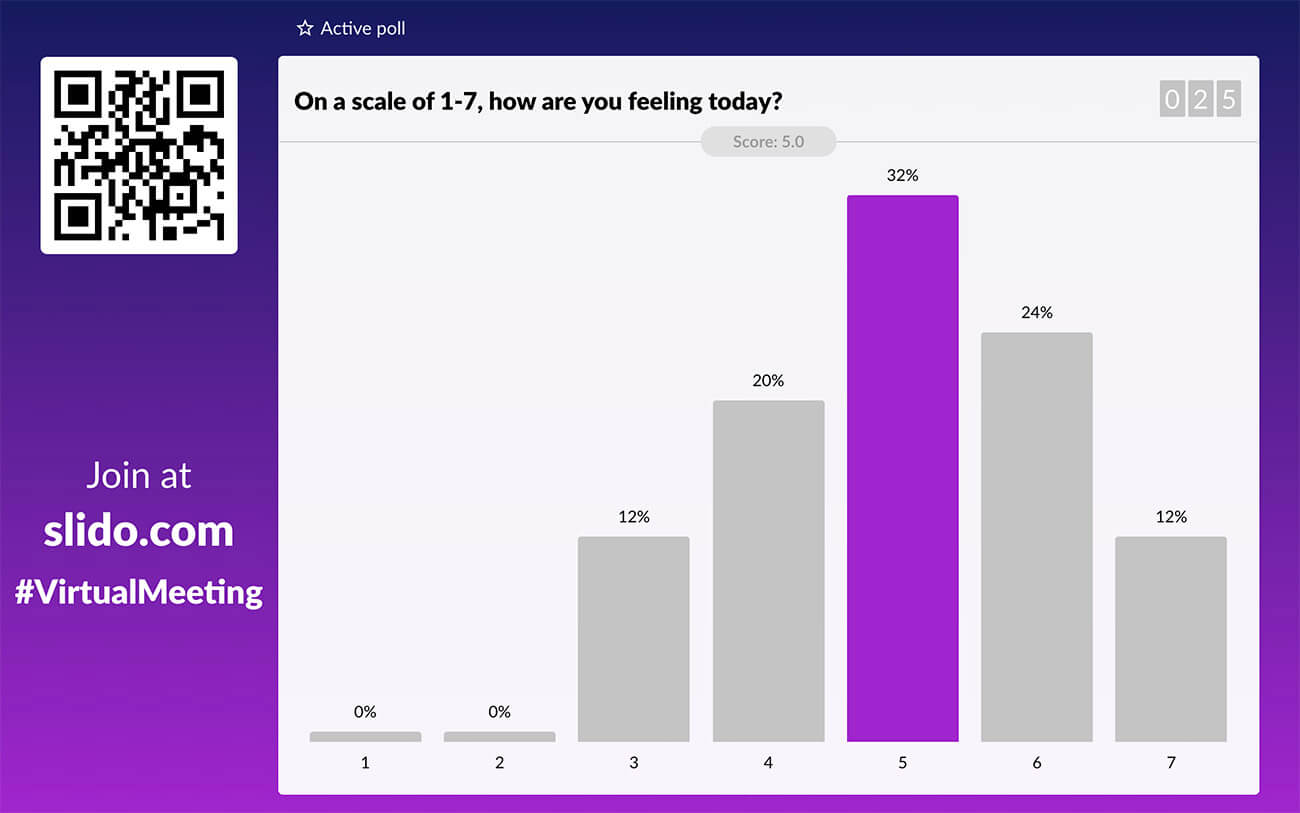
Everyone can contribute and so you’ll take an instant pulse check on how everyone is feeling before the meeting.
Use the poll results as a discussion starter: “I can see that not everyone is feeling at their best. Does anyone want to share their thoughts?”
Create your own poll in Slido and engage your audience. Sign up below and try it for yourself.
Sign up for free
#2. Would you rather…?
A would you rather virtual icebreaker question is guaranteed to spark a lively discussion at the start of your meeting and help with breaking the ice.
Simply ask your participants a thought-provoking ‘this or that’ poll question with two options to choose from. Then, drive a discussion around how people voted and why.
Here are some of our favorite would you rather questions:
- Would you live in the Arctic or in the Sahara Desert?
- Would you rather be always overdressed or underdressed?
- Have 2 meter long legs or 2 meter long arms?
- Time travel back to the past or to the future?
Read also: 101 Would You Rather Questions to Cheer Up Your Meetings
#3. Quiz question of the day
Or, why don’t you start with a little guessing game? Everyone loves quizzes as ice breakers and so a little brain teaser at the beginning of your meeting will perk your colleagues up.
This is an ideal virtual icebreaker for recurring meetings. If you and your team meet regularly, you can turn this into a tradition and run one quiz question at the start of every one of your meetings.
How to pull this off?
Simply create a quiz poll question in Slido and mark one option as correct. You can use our integrations with Google Slides and PowerPoint to insert the poll directly into your slides.
What’s more, you don’t even have to think up quiz questions. Our ‘magic cube’ random question generator will do that for you.
#4. Where are you joining from?
If your teammates are scattered around the world, kick off your meeting by sending a virtual hi to each one of them.
At the beginning of your conference call, run a word cloud with the question: “Where are you joining from?”
This is one of the best virtual icebreakers for large meetings or virtual events – the more locations, the better the word cloud will look.
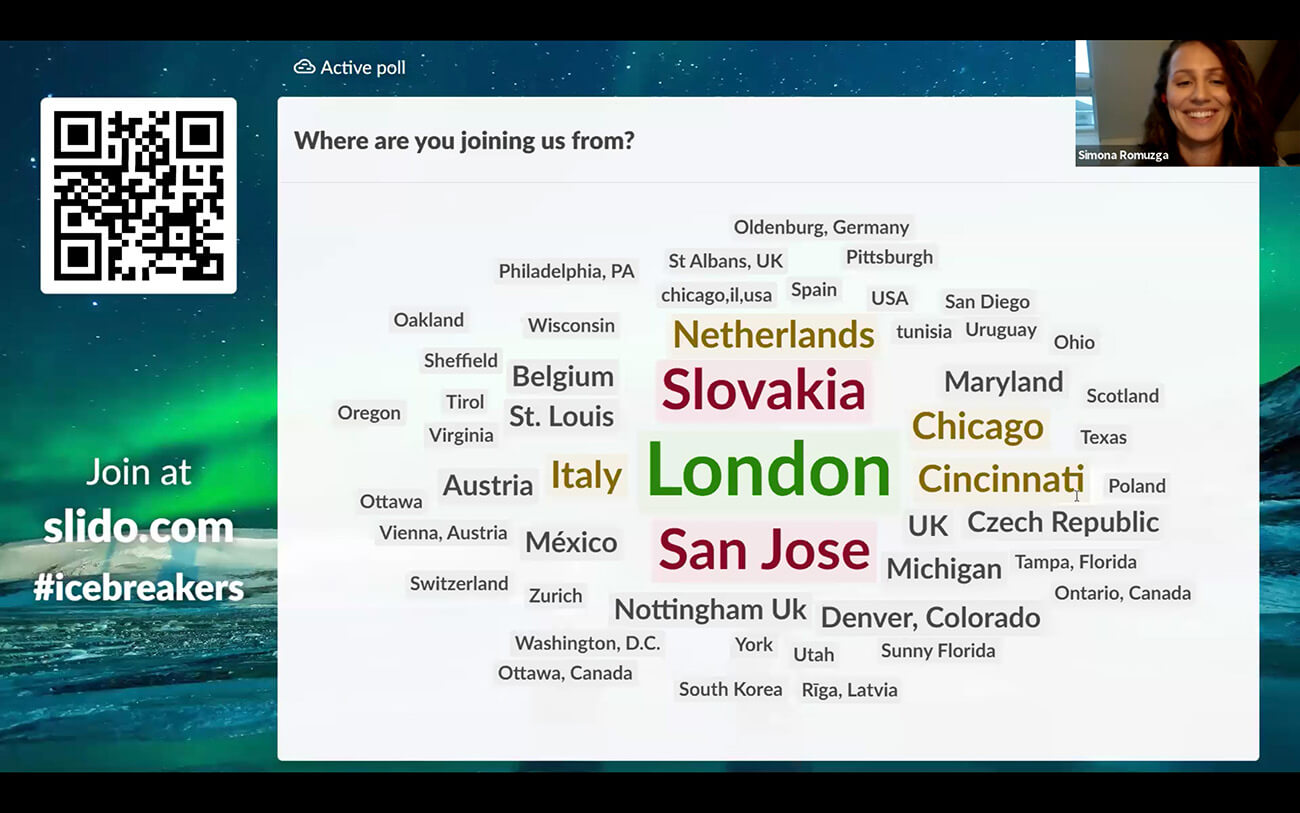
As your colleagues post their locations, give them a special shout-out.
You’ll even be able to see if participants are still typing or not with Slido’s typing indicator feature when you’re in present mode – so that everyone gets their chance to participate before you move on.
Read also: 35+ Word Cloud Examples for Your Meetings and Events
#5. In one word, how would you describe…?
You can also use word clouds to pick up your team’s thoughts and feelings. Open your meeting with a question such as: “In one word, how would you describe the past week/month?”
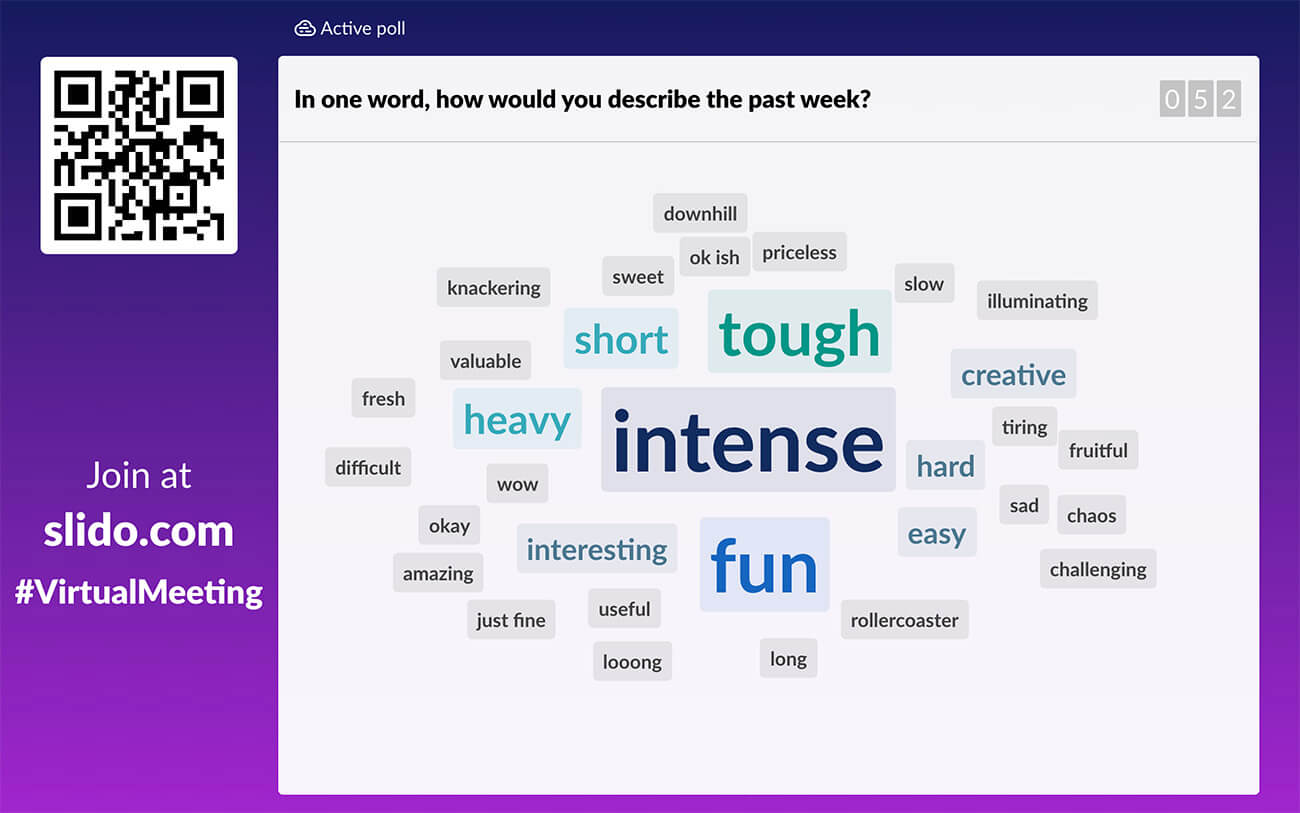
This is one of the virtual ice breakers that will help you take a pulse check of the overall atmosphere in the team and detect possible downturns – especially handy in a virtual setup.
Or, you can even try something different like: “If you were to describe our company in one word, what would it be?”
#6. Good old times
If you need a guaranteed conversation starter, try a question that brings back childhood or teenage years memories – they provide an inexhaustible source of amusement.
You can use word clouds here as well.
- Which was your favorite candy you were hoping to get when trick-or-treating? (A perfect icebreaker to use before Halloween.)
- Which music band was your favorite growing up?
After people submit their answers, ask volunteers to share how they voted and why.
There will be a lot to talk about, maybe even some arguments about which candy or which movie is the best. You’ll start a meeting with some laughs and get your colleagues in a good mood before a meeting.
Read also: The Best 110 Trivia Questions for Team Bonding Quizzes
#7. Rank your favorites
Similar to the previous virtual icebreaker, you can engage people in ranking their favorite things, whether from their childhood or not – the possibilities are endless.
Use a ranking poll question, add as many options as you wish, and let your participants rank them.
Here are some ideas:
- Rank these 90s movies from your most favorite to your least favorite.
- Rank these Christmas movies from a must-watch to the most passable one.
- Rank these Harry Potter movies from the best to your least favorite.
After your participants are done voting, display the chart with the winners and the runner-ups. Expect a lively discussion – people tend to passionately root for their darlings!
#8. Say it with an emoji
Here’s another way to get a sense of how your team members are feeling – let them express it with emojis. For example, at the start of your meeting, ask your colleagues:
“Which emoji best describes your current state of mind?”
You can use a Slido word cloud for that, but instead of words, your participants will submit an emoji. This works best with larger meetings and events when a large number of emojis gets submitted.
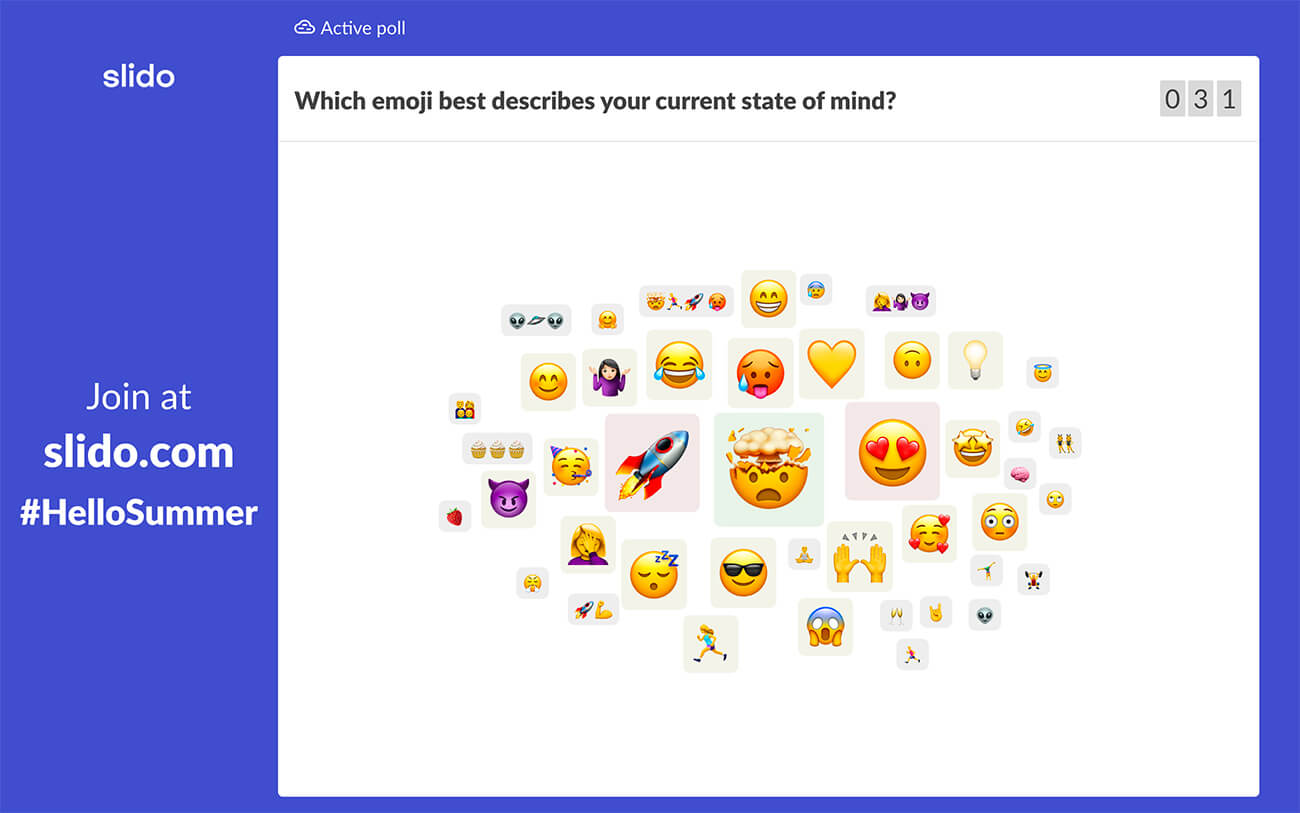
Here are some other ideas for emoji icebreakers:
- Describe our team with an emoji.
- Use an emoji to describe your ideal vacation.
- Which emoji do you use most frequently?
This is an ideal virtual icebreaker if you’re looking for a simple activity that anyone can participate in, for example, as you’re waiting for others to join the meeting.
Read also: 80+ Best Poll Questions To Ask Your Online Audience
2. Short virtual icebreaker activities
These are great if you want to surprise your participants with a fun little activity and enjoy some bonding time.
#9. Draw your mood
Instead of verbally asking your colleagues how they are at the start of your meeting (which often results in a half-baked ‘fine’, or ‘okay’ here and there), ask them to draw how they are. It’s much more fun and you’ll spark creativity among your colleagues.
During our recent Brand Team meeting, our colleague, Sabine, shared a Zoom Whiteboard with us and asked us to draw our current mood on it. So we channeled our inner Basquiat and came up with something that remotely resembles art. But it was so much fun, we swear!
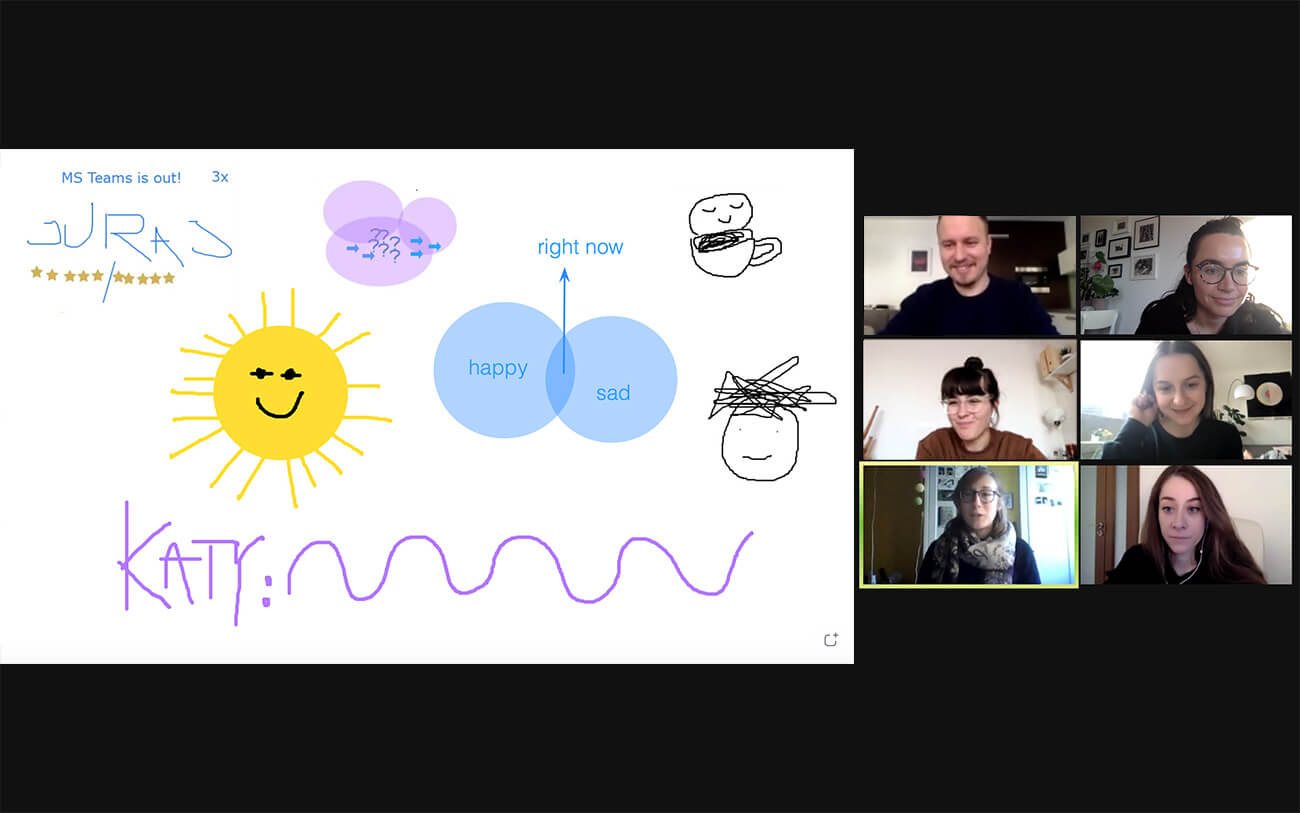
Note: Are you running your meetings in a hybrid setup ? Then make sure that each of your on-site team members joins the video conferencing call from their own device so they can participate in the activity.
#10. Highlight of the month
Here’s a great way to lift people’s spirits. Crowdsource your colleagues’ personal or professional highlights from the last week or month.
Thanks to this virtual icebreaker, you can see what other people have been up to and have experienced, and you can celebrate some of your top moments.
As you kick off your meeting, ask your teammates to post their highlights in an open text poll . Then, display the highlights on the screen, and give a shout-out to each one.
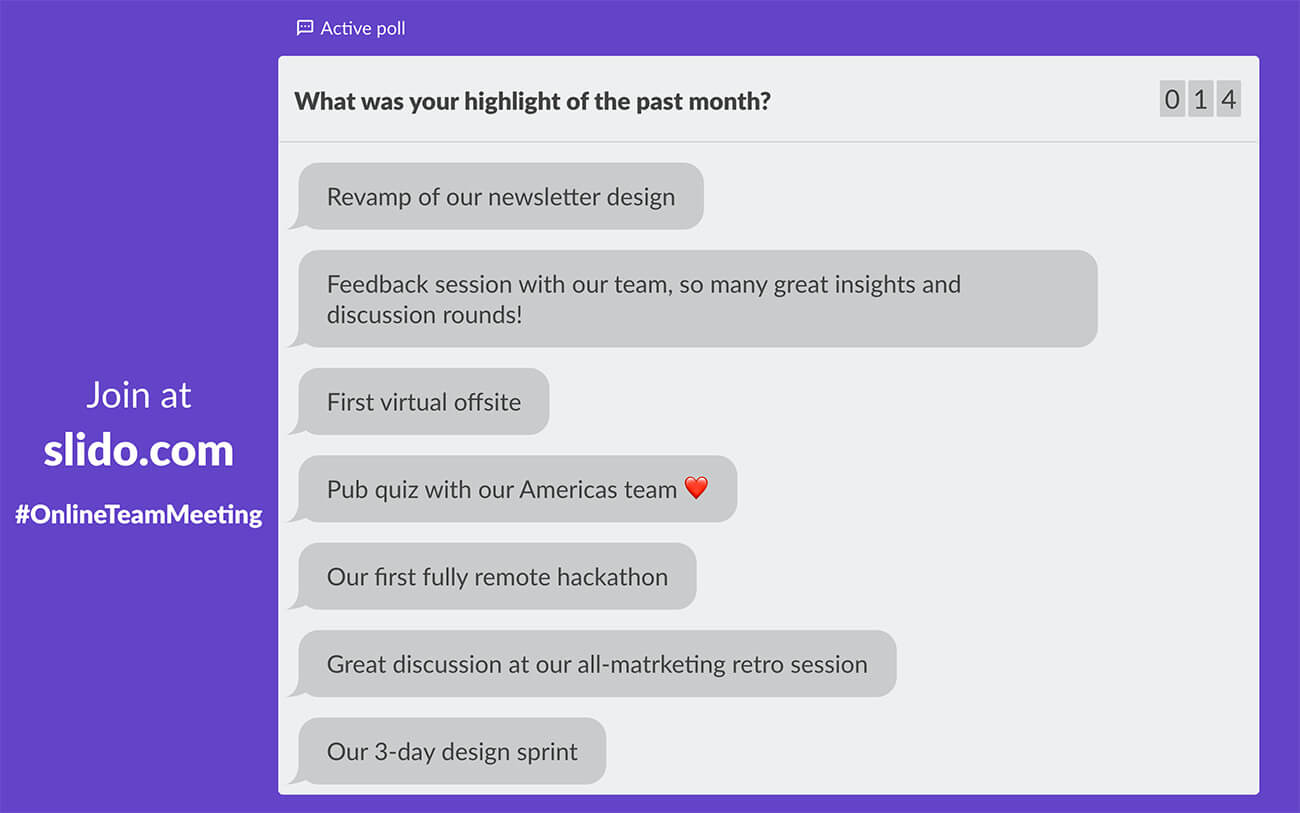
It’s good to remind people of all the remarkable work that they’ve done. For example, in our Slido marketing team, we share highlights as part of our monthly all-marketing meeting.
#11. Unsung heroes
This is not only an icebreaker but a morale booster as well. And we all need that now and then, especially when working in isolation.
Give kudos to the heroes in your team. Kick off your meeting with a word cloud poll such as: “Who was your silent hero this month?”
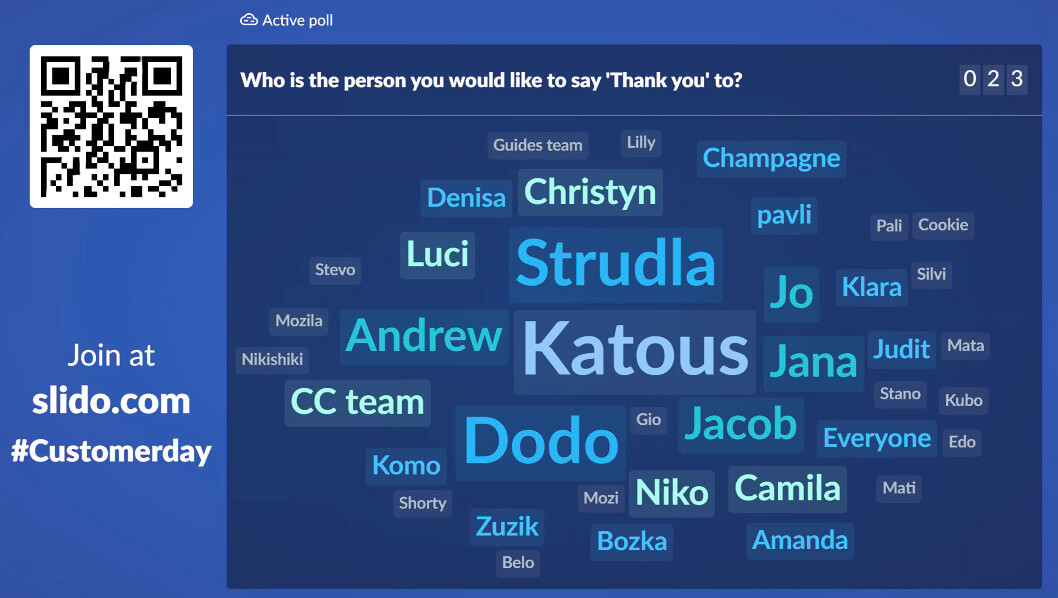
Acknowledging people for the effort they’re putting in is a wonderful way to start a meeting. Expect lots of hearty “awws”.
💡 Tip Combine the word cloud with an open text poll , so that people can also leave a heart-warming message for their nominated silent hero.
#12. What are you thankful for?
This ice-breaking activity is ideal, for instance, before Thanksgiving or as a morale booster during special team meetings.
Ask people to submit what they are grateful for or who from the team they would like to thank.
You may open your meeting with this question, either via word cloud or an open text poll , and wait for your team members’ submissions.
Then, display people’s submissions on the screen and ask your colleagues to share what they put in and why.
It’s a nice bonding moment and helps you start the meeting on a positive note.
#13. Team photo
A list of virtual icebreakers wouldn’t be complete without a group photo! This one’s as much fun through a video chat as much as it is in real life. And you can repeat it time and time again by taking a different picture each time — make funny faces, bring in your pets, do a crazy gesture, be creative.
Take inspiration from our Customer Care Team!
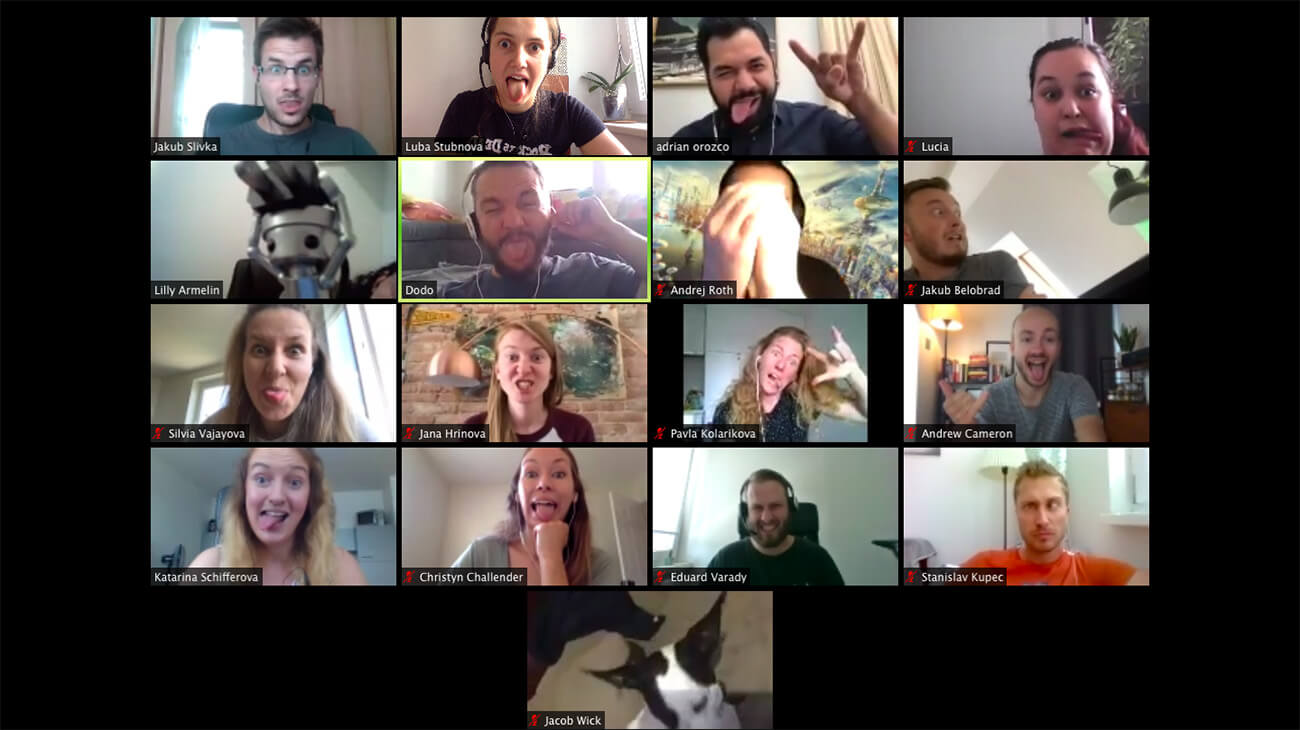
💡 Tip These photos also make nice content for your social media, internal newsletters, or Slack channels!
#14. Guess whose desk?
Get to know your colleagues a little better, and take a sneak-peek into their home work stations. This virtual icebreaker is a mixture of ‘Guess who?’ and a house tour.
Collect pictures from your colleagues of their desks at home and add them into Slido multiple choice polls with a question: “Can you guess whose desk this is?” and give several options.
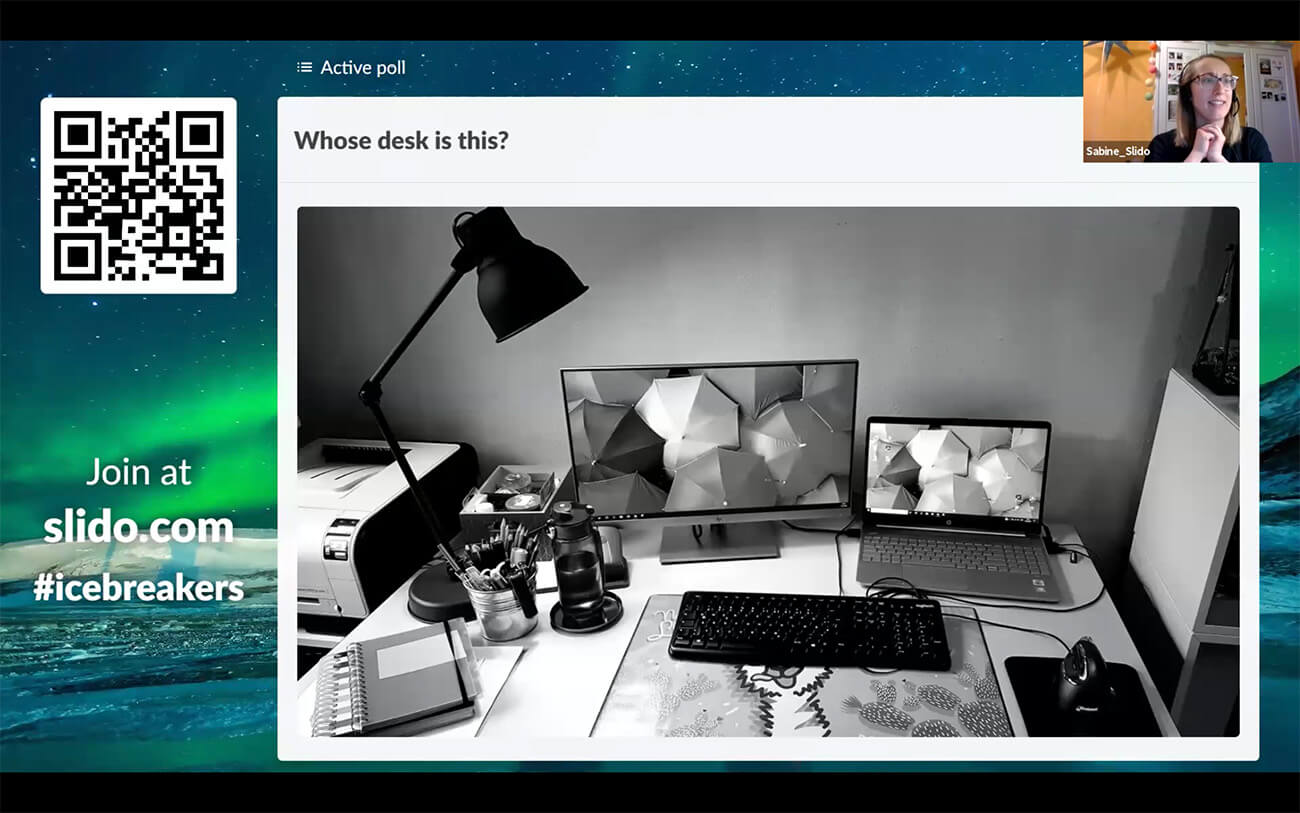
Then, once at a meeting, let your colleagues guess away!
#15. Weekend photo contest
A slow start after the weekend? Run a quick weekend photo contest to get your teammates talking. Tell them to share a cool photo from their weekend – for example in a Slack channel.
You can then put people’s names in a Slido multiple choice poll and have your colleagues vote for the best shot!
#16. What’s the last picture that you took?
Similar to the previous virtual icebreaker, this one is probably even more fun: Ask your colleagues to go to their phones, and dig out the last photo that they took. Ask them to either post it to your Slack channel or simply show it to the camera. Then, ask them to share a story behind the picture (if it’s not a secret!).
It’s a sweet little activity to make people talk and get to know one another better.
#17. Random question of the week
Here’s another one from the ‘Get to know your colleagues better’ virtual icebreakers. Set up a new tradition and ask your team one random question each week or month.
For example:
- What’s the most useless thing you have in your home?
- What would your superpower be if you had one?
- What one thing should everybody stop doing right now?
- What’s one song or artist that you’re embarrassed to admit you like?
We actually started doing this as a weekly activity in our #random Slack channel. We’ve since learned so many cool new things about one another!

3. Virtual icebreaker games & Team building activities
These are great get-to-know-you games and longer team-building activities that will both entertain and bring the team closer together.
#18. Home scavenger hunt
Begin this team building activity by getting your colleagues out of their chairs. This virtual icebreaker is fun and you’ll all get a chance to move around a little. Give your teammates a little task such as: “You have 25 seconds to fetch something yellow,” or “Get the weirdest thing in your apartment, then bring it back to show us”.
You can even take it a little further and play a full-scale virtual scavenger hunt. We recently played it in our Brand team and it was so much fun. Our colleague, Nadia, gave us 5 minutes to fulfill 20 tasks such as:
- Take a picture of a view from your window and post it to Slack
- Find something smaller than your fingernail
- Bring the softest thing you own
- Change your background to your favorite movie set
- Bring an item that’s older than you are
And on a hunt we went.
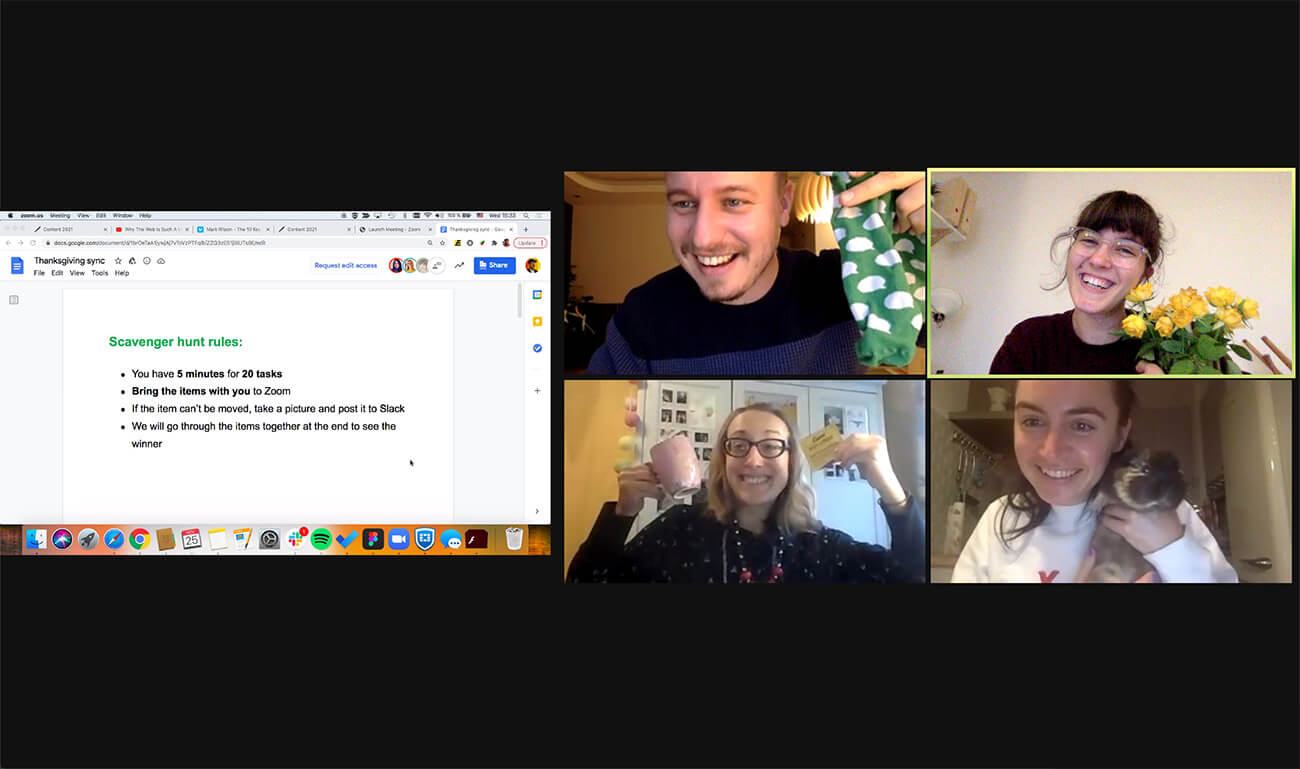
When the time was up, we got back together on the call and shared funny stories behind the objects that we brought. We shared some good laughs together!
#19. Team trivia quiz
Using virtual icebreakers during your meetings also helps you get to know your colleagues better.
Try a fun trivia quiz with questions about your team. Collect interesting facts about each team member, then let other colleagues guess away. We’re sure you’ll dig out plenty of fun stuff!
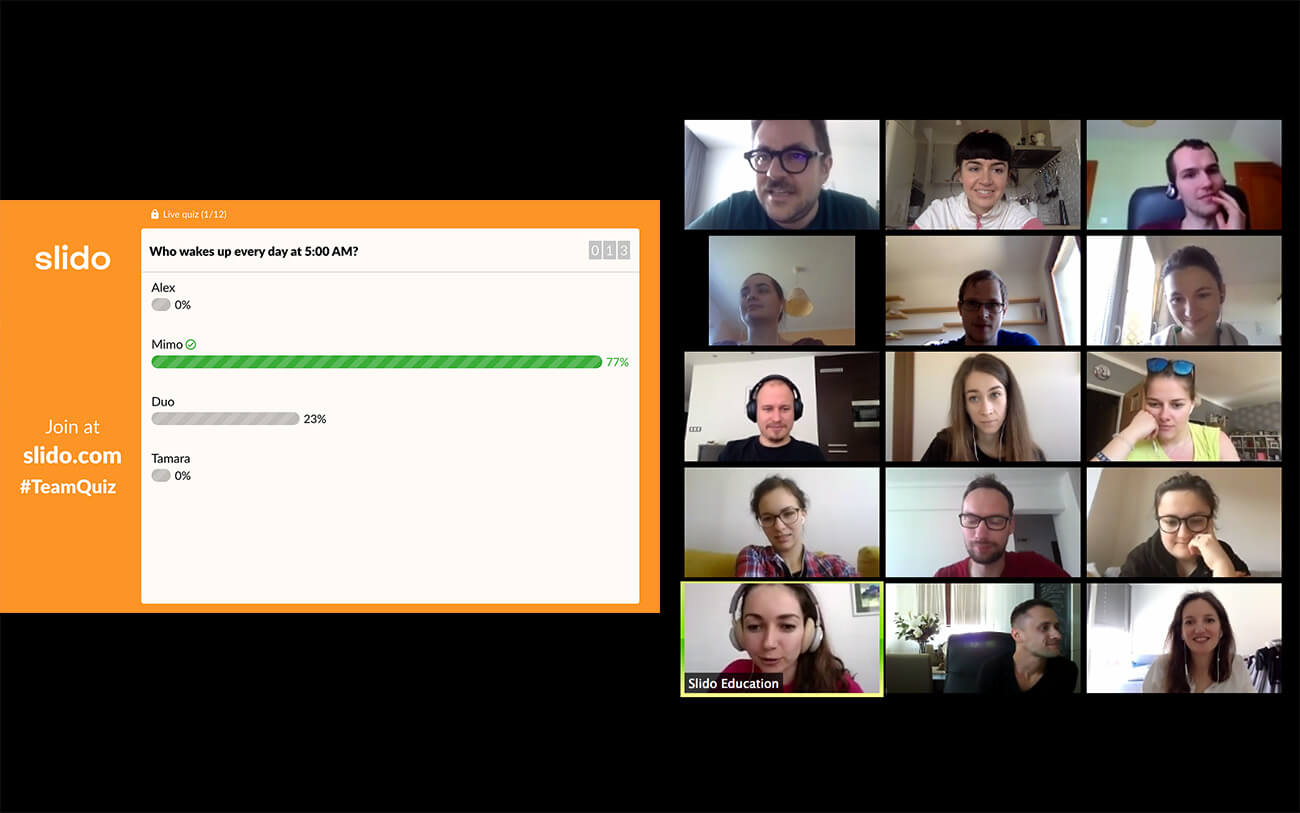
We run this type of quiz when we introduce a new team member, or as a holiday fun activity.
Read also: 7 Awesome Quizzes for Your Virtual and Hybrid Meetings
#20. Background challenge
Share some laughs with your teammates on the call. Before your next all-hands or town hall meeting, set a theme and ask your colleagues to pick a virtual background image that, for them, represents it best.
Get creative. Favorite movie scenes, 80’s disco, memes, dream vacation places – the possibilities are endless.

Seeing each other’s backgrounds will break the ice and give you something to talk about during the first minutes of the call.
But virtual backgrounds do more than just entertain . They’re also great for hiding a messy kitchen behind you, or a trespassing family member!
If you need inspiration, visit this huge library of virtual backgrounds by Canva, or get more quirky ones here .
💡 Tip You can also let your colleagues vote for the best background through a Slido poll .
#21. Two truths & one lie
This fun game is great for introducing new colleagues or getting to know each other better. Collect three statements about each of your colleagues – two of them should be true facts and one should be a lie. Tell your colleagues to provide a lie that’s not so obvious so as to make it harder for others to guess.
Next, put all of the collected statements into Slido multiple choice polls , or you can make it a live quiz .
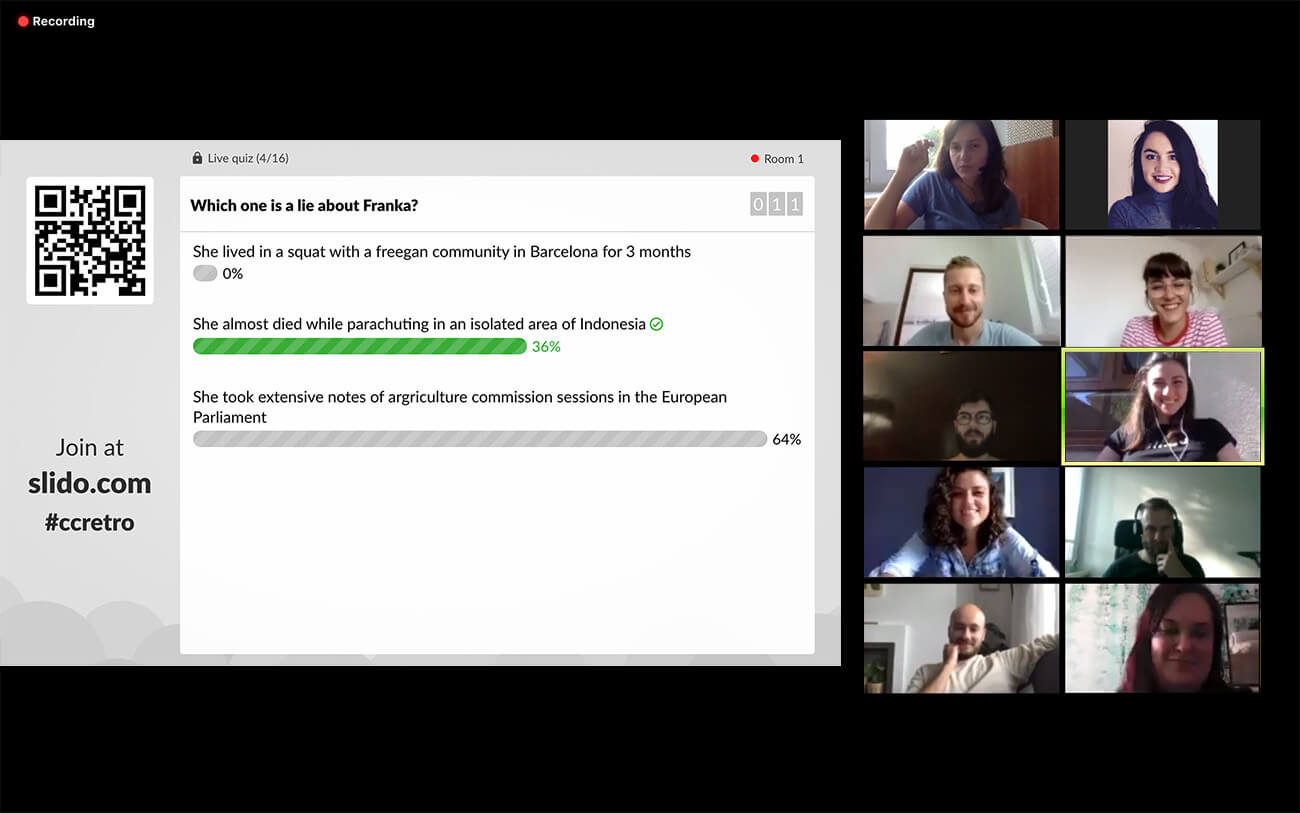
💡 Tip Don’t forget to ask the person who the poll is about to share at least one story behind the statements.
#22. Struggle sharing
Sharing is caring – and that should apply to both the good and the bad. Similar to sharing highlights (see point #10), it’s important to also give our attention to things that didn’t go so well; things that we can learn from, and move forward together.
It makes for a great team bonding experience.
Depending on the setup you’re in, divide your colleagues into smaller groups (if you’re in an online setup, use breakout rooms) and ask them to discuss their struggles. It can be both professional and personal.
Using an open text poll , encourage your team to share their failure or struggle in Slido as well so that people can see that they’re not alone in being imperfect. You can then regroup and open a discussion about lessons that people learned from their failures.

As a leader, don’t forget to contribute as well. Showing vulnerability is also a form of strength.
Read also: How Talking About Wins and Struggles Helped Our Team Bond
#23. Show & Tell
Inspired by the classic kindergarten exercise where kids bring an object to school and describe it to their fellow pupils, show and tell is a great activity for getting to know the team better.
Tell your colleagues to bring an object that has special meaning to them or that is tied to an exciting story. Give each group member 3-5 minutes to tell the rest of the group about it.
This virtual icebreaker is ideal for small teams (or done in groups) because people might not be willing to talk in front of larger crowds of people.
💡 Tip Don’t forget to give people enough time to think about their story and prepare for the short presentation. Not everybody is happy with improvising.
#24. Guess who?
This is another great get-to-know-each-other-better game, inspired by our Head of User Research, Neil Sharman.
In one of the meetings, he asked everyone to anonymously submit into Slido three brands they know they ‘love a bit more than is logical’.
Then, he displayed people’s submissions on the screen and the team guessed who is who just from the three brands. It’s fun to identify people, plus everyone gets to share something about themselves. You’ll definitely learn a lot of interesting stuff about each other.
💡 Tip It doesn’t necessarily have to be about brands. It can be music, hobbies, movies, etc.
#25. Coffee time
Have you heard of Fika ? It’s a Swedish word often interpreted as ‘a coffee and cake break’.
For Swedes, however, it is much more than that. It’s about taking a break from everything for a while and enjoying quality time with friends or colleagues over a cup of coffee or tea.
Take Fika to an online environment. You can call it whatever you like – virtual watercooler talks, virtual happy hour – it’s your choice.
But be sure to schedule an informal team catch-up from time to time just to chat with your teammates about something other than work. In remote times, it will help you feel less isolated.
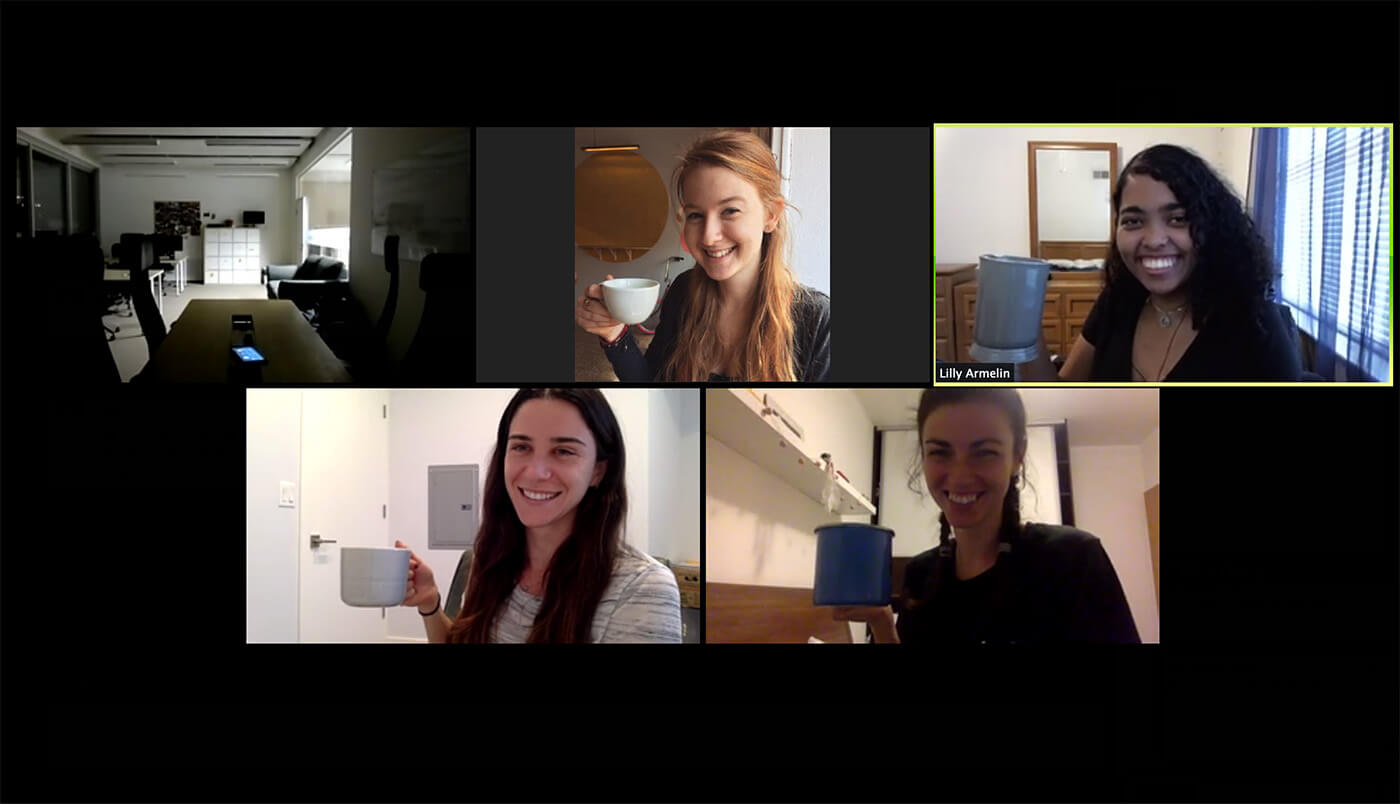
#26. Visual brainstorming
Good productive idea exchanges make for great virtual icebreakers too. Instead of just shouting ideas at each other, try visual brainstorming.
Take advantage of one of the visual collaboration tools such as Mural . We tried it recently during our Brand team meeting and it was an hour well spent – productive, creative, and fun.
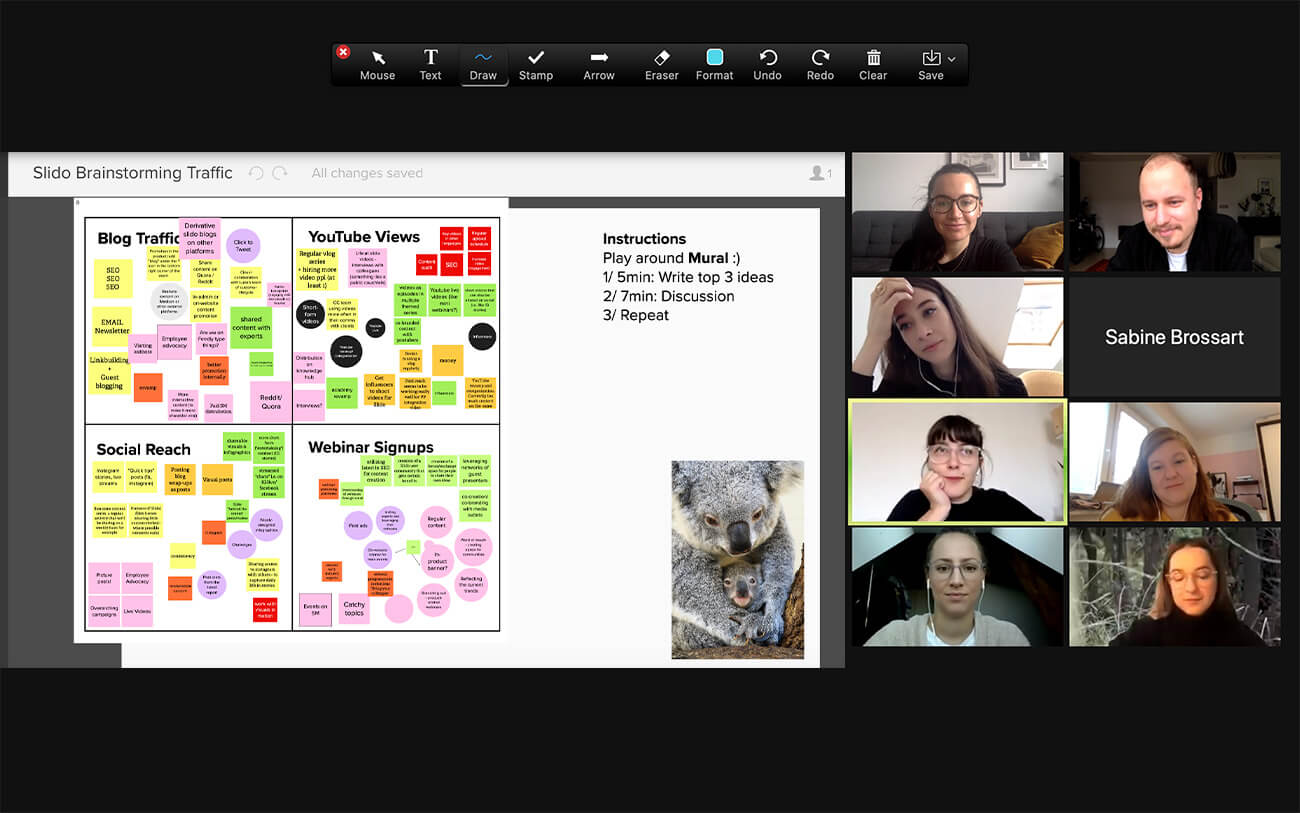
We set up a virtual whiteboard, and each of us was supposed to write our ideas on little stickers that we then posted on the board. It nicely simulated a real-life brainstorming session .
#27. Meet up in a virtual bar
If remote work or distributed team setup doesn’t allow you to enjoy an after-work beer with your colleagues, why don’t you go for a virtual alternative?
In our Brand team, we recently tried Kumospace – an immersive video chat that allows you to ‘meet’ your colleagues in a virtual bar (or other space), move around, or create smaller chat groups.
Oh, and don’t forget to get a drink. The app will even remind you when it’s time for a refill!

There are other apps that provide immersive team experiences, for example, Topia . With this one, you can even design your own virtual world. It’s good to have a change of scenery, isn’t it?
#28. Never Have I Ever
While you’re all hanging out together in this virtual bar (see point above), why don’t you play a game? If you’re familiar with Never Have I Ever, you surely know how much fun it is – especially with more juicy questions. It’s simple: Each of you will hold out your hand so everyone can see your fingers.
One of you will read questions such as: “Never have I ever gone skinny dipping.” Whenever one of you has done it, he or she will put one finger down.
This icebreaker activity is awesome for getting to know your colleagues better and have a good laugh together while sharing funny stories behind each finger down!
If you need inspiration for Never Have I Ever questions, find 250 of them here .
#29. Donut friends
When was the last time you randomly bumped into someone in a hallway in your office and shared a good chat with them? Or, had a deep conversation about life, the universe, and everything with a bunch of colleagues in a kitchenette or by the watercooler? Before we can enjoy this again, try Donut.
Donut is an app for Slack that randomly pairs two or three colleagues together for a scheduled video call. You can make use of that time however you like: Have a virtual coffee, a peer learning session, or a chat about a book that you recently read.

The best thing is that it gets you together with teammates with whom you wouldn’t normally talk or interact on a daily basis. Sounds like a nice way to foster new friendships in the workplace, doesn’t it?
#30. Online escape room
Need a full-scale team-building activity? Try a virtual escape room. If you’ve ever experienced the real thing, you surely know that it’s as much fun as it is nerve-wracking! It involves dealing with various challenges, finding codes, and completing puzzles in order to “get out of the room”.
It’s the ultimate team bonding experience – if your teammates love a good game, they’re going to be fans. There are plenty of escape room platforms out there, for example, Escape Live . You can choose from various different session types or themes.
#31. Virtual wine tasting
Even if you’re remote, you don’t have to give up the good old wine or beer-tasting sessions. Sure, it’s a bit harder to pull off in a virtual setting, but not impossible. Just agree on a brand or type – or buy a different wine each, so you can tell each other about the subtle tones you’re getting!
Our People team has recently done a wine-tasting call and it was a great team bonding experience.
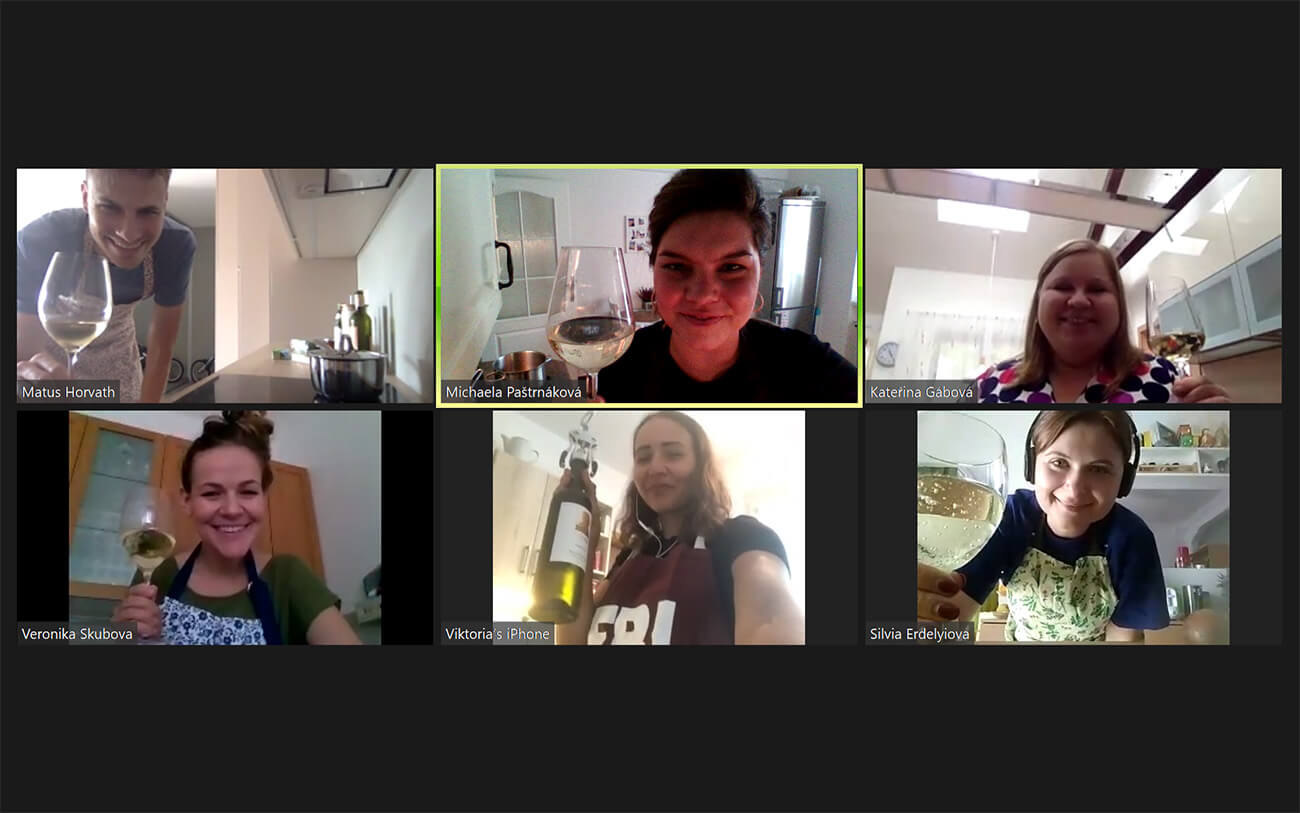
It lets you enjoy some informal time with your colleagues, which, amid all the meetings is a nice change. Plus, you get to indulge in some fine beverages, what a treat!
#32. Pair & Share
This is a great virtual icebreaker that allows for more intimate conversations among your teammates. If you’re familiar with breakout rooms , you’ll appreciate this one.
Give your colleagues a thought-provoking question to ponder, then pair them randomly using breakout rooms (check whether your video conferencing tool allows for it).
Next, allow all groups a couple of minutes to discuss the topic before coming back to the main room to share what each pair talked about.
This is a great alternative to the ‘turn to your neighbor’ kind of exercise – it’s interactive, and allows for more in-depth discussion between people. Introverts will appreciate this, as it feels more comfortable to share something in a pair, compared to the whole team.
#33. Online games
Online team-building games are fun and social – they encourage interaction among coworkers and help bring back the camaraderie of a physical office.
The depths of the internet is full of options, but to inspire you, we recently discovered Bored – a suite of Slack games for remote teams. You simply add the tool to your company Slack and play fun games with your colleagues right in the Slack channel.
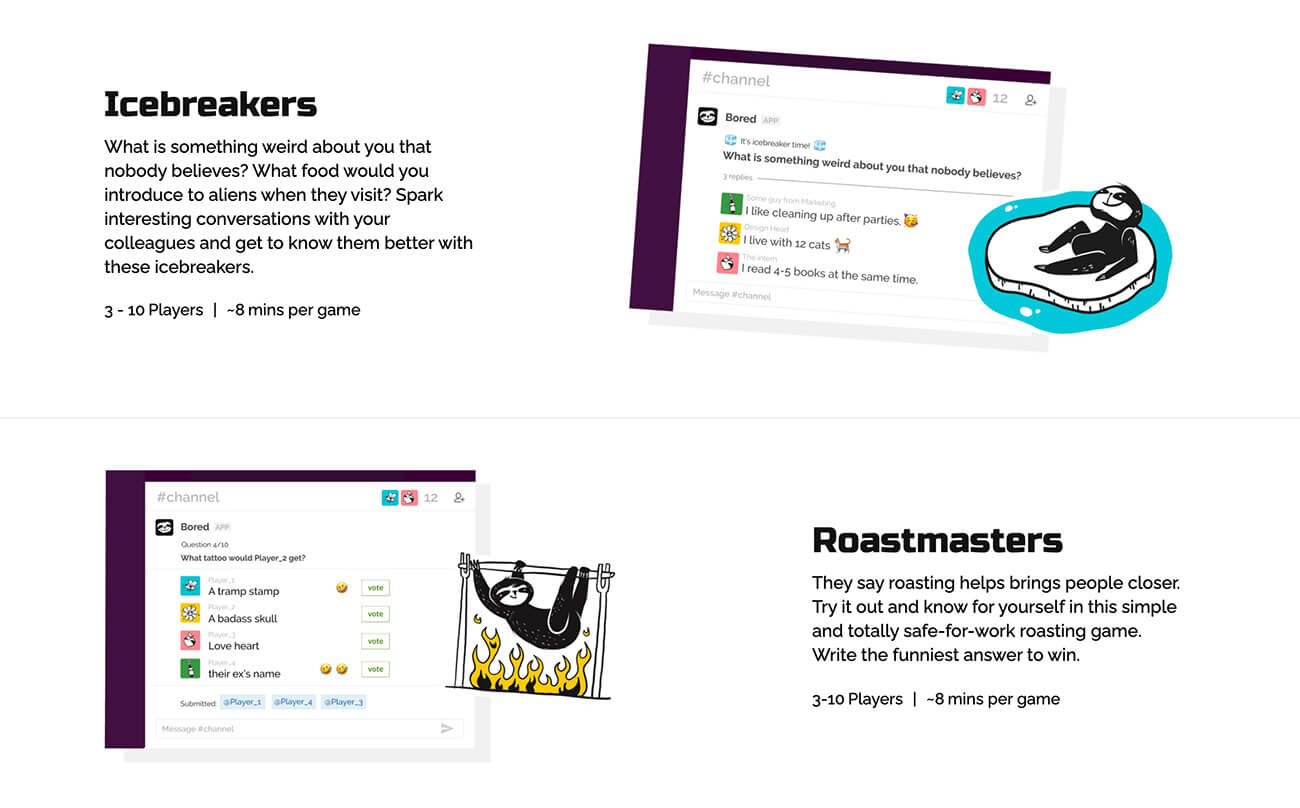
Apart from the ever-popular game of trivia, Bored has games in which you roast your colleagues, or play a game of accusations and deception. Recently, they launched ‘Icebreakers’ to help teammates get to know each other better by answering questions that are unconventional and fun.
#34. Name that sound
Looking for a more sophisticated guessing game? How about guessing the sounds? This is one of the most challenging virtual icebreakers, but it’s ultimately very satisfying!
It’s simple. You turn your cameras off, leaving only audio on, and then you make some sort of a sound close to the mic so that your colleagues are able to hear it, and guess where it comes from.
Here are the instructions:
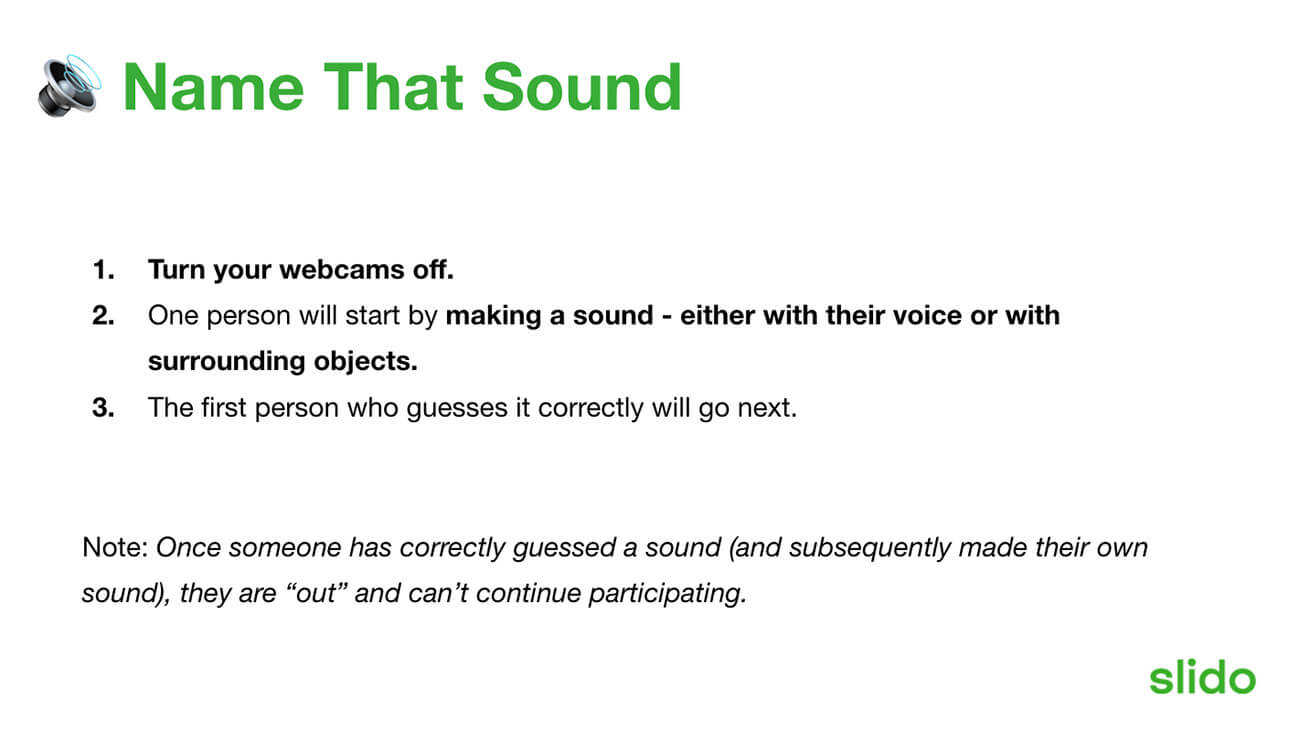
#35. Group storytelling
Put your improvisation skills to the test. This virtual icebreaker is inspired by my colleague Sabine, who decided that since our team-building trip couldn’t happen this year, at least we’ll make up a cool story of how it went.
She created a slideshow of random travel pictures, started a story, and then called on one of our teammates to follow up on what she had said, based on what picture was currently up.
We took turns in telling crazy things we did during our imaginary trip and let me tell you, it was some ride!
Ready to break the ice at your meetings?
We hope you’ll try one of these virtual icebreakers at your next online meeting. Let Slido help you connect with your teammates, wherever they are.
Try Slido for free
Get just a single email per month with our best articles.

5 Slido Activities to Build Psychological Safety In Your Team
At the center of a working environment with high levels of trust is the magic ingredient: psychological safety. If you’re...

7 Ways to Celebrate Your Team in Your End-Of-Year Meetings
As 2023 draws to a close and with 2024 in sight, we’ll all be taking a look back at what...

The Top 80+ Poll Question Ideas to Ask Your Online Audience
Whether you’re running a meeting, hosting a training, webinar, or speaking at an event, polls are your best friend. They...
Got any suggestions?
We want to hear from you! Send us a message and help improve Slidesgo
Top searches
Trending searches

teacher appreciation
11 templates

memorial day
12 templates

9 templates

55 templates

summer vacation
24 templates

islamic history
36 templates
Fun Word Games for Virtual Meetings
Fun word games for virtual meetings presentation, free google slides theme, powerpoint template, and canva presentation template.
Are you a teacher and you've been hosting a virtual classroom for quite some time now? Let's make education more fun with this template. Its main feature is the inclusion of many word games, and all the students can play (and learn!) together. These come in the form of crosswords, word searches, filling blanks, and many more. As a cool nod, the slides contain a little "graphical glitch" effect, because, yeah, we live in the computer era! But fear not, everything is OK with this template!
Features of this template
- 100% editable and easy to modify
- 35 different slides to impress your audience
- Contains easy-to-edit graphics such as graphs, maps, tables, timelines and mockups
- Includes 500+ icons and Flaticon’s extension for customizing your slides
- Designed to be used in Google Slides, Canva, and Microsoft PowerPoint
- 16:9 widescreen format suitable for all types of screens
- Includes information about fonts, colors, and credits of the free resources used
How can I use the template?
Am I free to use the templates?
How to attribute?
Attribution required If you are a free user, you must attribute Slidesgo by keeping the slide where the credits appear. How to attribute?
Related posts on our blog.

How to Add, Duplicate, Move, Delete or Hide Slides in Google Slides

How to Change Layouts in PowerPoint

How to Change the Slide Size in Google Slides
Related presentations.
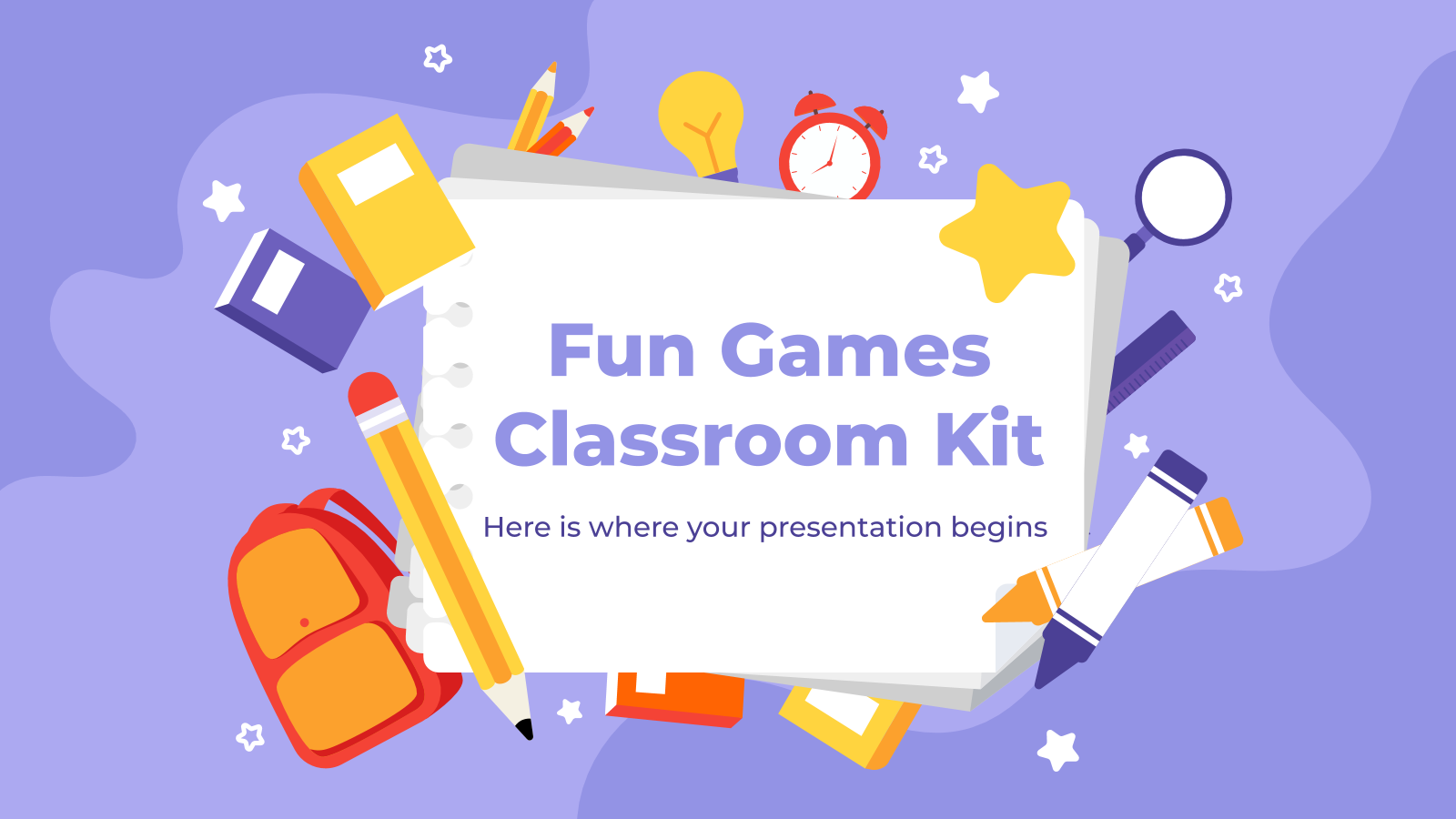
Premium template
Unlock this template and gain unlimited access


IMAGES
VIDEO
COMMENTS
This activity is also free for up to 10 people and is easy to personalize. . 6. The Get to Know You Game. This activity is one of the best presentation games if you have a small group that doesn't really know each other. The Get to Know You Game is a creative way to do introductions, and it's really simple.
Heart, Gun, Bomb - Interactive presentation games. This one's a great game to use in the classroom, but if you're not looking for presentation games for students, it also works wonders in a casual work setting. Heart, Gun, Bomb is a game in which teams take turns to answer questions presented in a grid.
Tailor your choice of games to align with your presentation goals, ensuring they enhance your message rather than distract from it. Now, let's explore 15 interactive presentation games that you can incorporate into your presentations to engage your audience effectively: 01. Polling and Surveys.
10. The never-ending sentence. The never-ending sentence is a great game that incorporates many of your attendees and awakens their brain cells. It is perfect for keeping up their engagement and interest, especially for long presentations or workshops when you feel like some people are getting a little tired.
Interactive presentations leave a lasting impression on the audience. By encouraging active participation and feedback, interactive presentations facilitate better understanding and knowledge retention. Here are 15 innovative 5-minute interactive presentation ideas to captivate your audience from start to finish: 1. Ice-breaker questions.
20 Interactive Presentation Games. 1. Project Jeopardy. This game is designed to make the presentation of reports more fun and interactive. The lead person on the report creates cards that have answers from the report. For example, the card reads "25%.". The rest of the team is supposed to ask the correct question corresponding to the "25 ...
1. Process of elimination. This presentation game for 10 or more players helps the audience get to know each other. This game provides valuable insights into your audience members, while also giving them a chance to stretch their legs. Here's how it works: Have everybody in your audience stand up.
1 Start your interactive presentation with an icebreaker. The first step is creating a rapport with your audience. You can do this by helping them to get to know you a little better and get to know each other as well. The way you go about this will depend on the size of your audience.
The 9 Dimensions Team Building Activity is a great, remote-friendly approach to structuring a team discussion. Begin by distributing or having your team create a 3 x 3 grid with nine areas for discussion. Invite each team member to fill in the grid with a colour based on their feelings about that area.
Read more: 8 interactive presentation games for large teams. Use interactive questions to assess the audience. If you want to know if the audience really understands what you're presenting, ask. Christopher Robertson, who teaches at University of Arizona's James. E. Rogers College of Law, uses Poll Everywhere to identify and resolve any ...
Virtual presentation icebreakers. Not sharing a physical space can make breaking the ice even more of a challenge, especially since many icebreaker ideas would not fit an online presentation. ... It's a great adaptation of a classic game for virtual meetings! Fun icebreaker ideas for playful presentations. Icebreakers can also help your ...
Crush Your Next Virtual Presentation. Summary. While virtual communication platforms help keep remote teams connected, they're not always the ideal venue for delivering engaging presentations ...
6 Super Fun Activities for Your Next Virtual Meeting. by. Christopher Littlefield. April 18, 2021. HBR Staff. Summary. Research has shown that many have experienced a decline in well-being since ...
18 virtual team building activities and games. This isn't academic theory or some stuff we just made up. This is how real remote teams have fun and stay connected. Building bonds between teammates is extra-important when you're in remote or hybrid mode, as a growing body of research confirms. Whether an activity is just for fun or helps ...
Here is a selection of virtual meeting room games and activities that are easy to use, including many free options. 1. Buzzword Bingo. Buzzword Bingo is an easy virtual meeting game. Simply email your team Bingo cards filled with common meeting phrases. Each time players hear a phrase on the card they can mark it off.
One of the most popular types of PowerPoint games to use in the classroom is Jeopardy. It's a great game to use to review for a test or to introduce new material to students. They can be played as a class, teams, or individually on computers. 9 Best Free Jeopardy Templates. 02.
Discussions in virtual meetings are often more productive when moving into breakouts. For this virtual icebreaker game, start by collecting a heap of inspirational, relevant quotes in an online whiteboard or Google Doc. Next, put people in breakouts and invite them to choose a quote to discuss with the group.
3. Virtual icebreaker games & Team building activities. These are great get-to-know-you games and longer team-building activities that will both entertain and bring the team closer together. #18. Home scavenger hunt. Begin this team building activity by getting your colleagues out of their chairs.
Our selection of fun games will help you make your next meeting, games night, or get-together all the more fun and entertaining. Thanks to our fully interactive games you can entertain everyone in attendance. So remove the stress and effort involved in creating rules, organizing cards, and moderating disputes, by downloading one of our templates.
Let's make education more fun with this template. Its main feature is the inclusion of many word games, and all the students can play (and learn!) together. These come in the form of crosswords, word searches, filling blanks, and many more. As a cool nod, the slides contain a little "graphical glitch" effect, because, yeah, we live in the ...